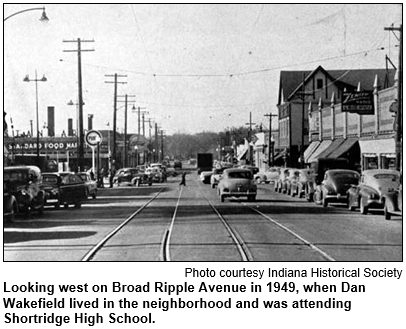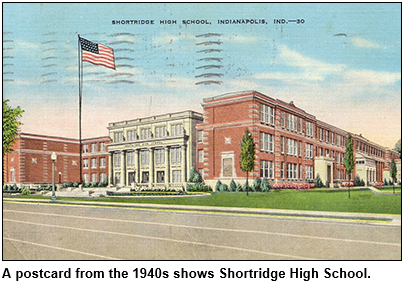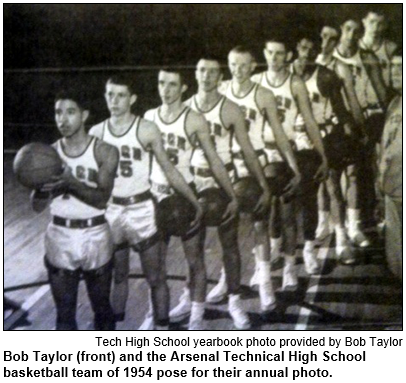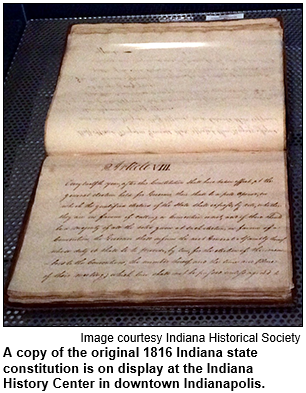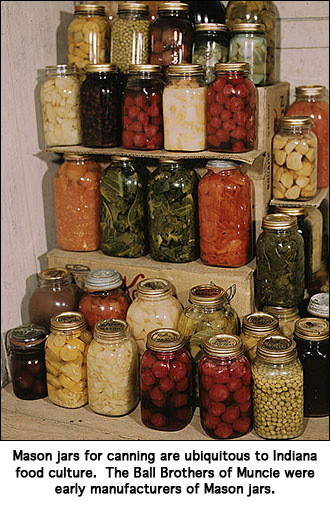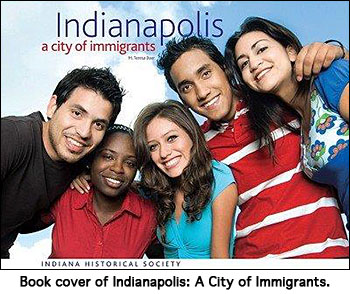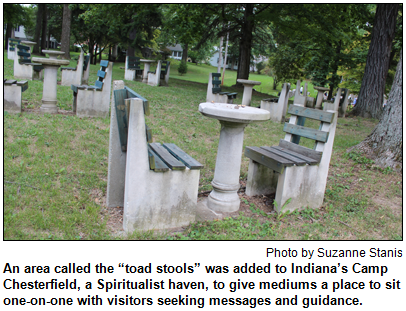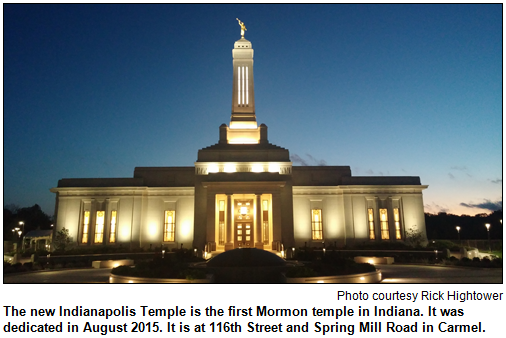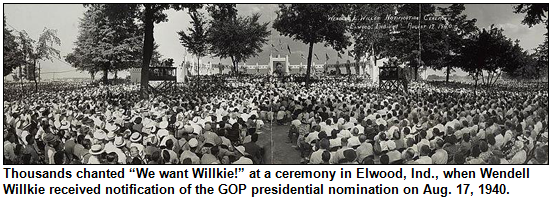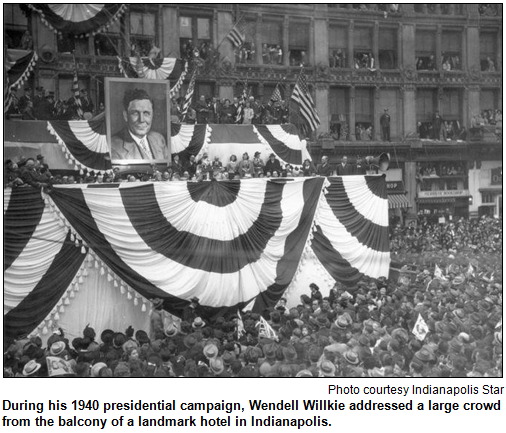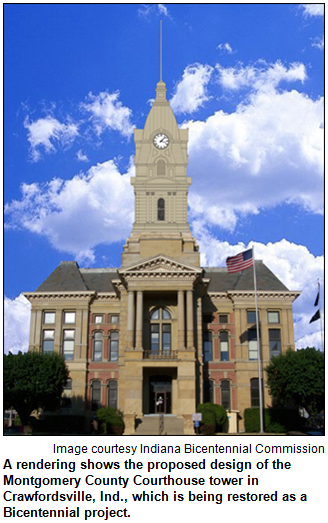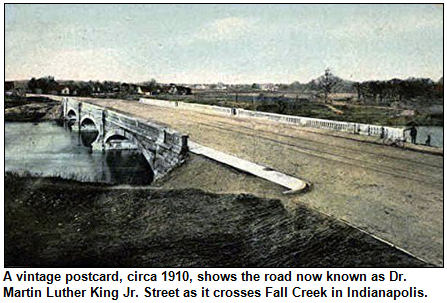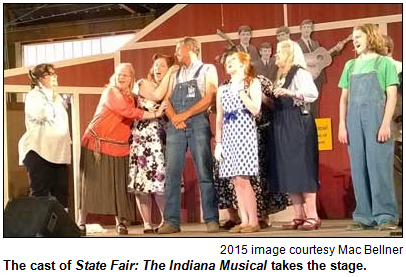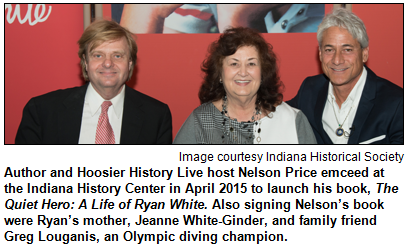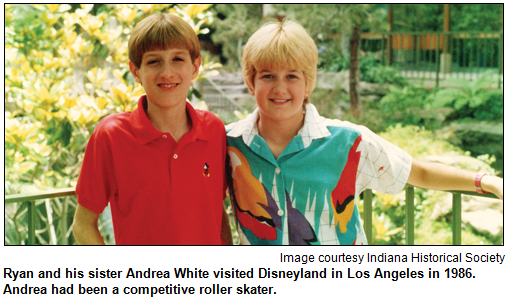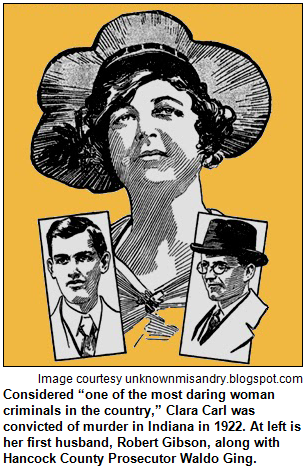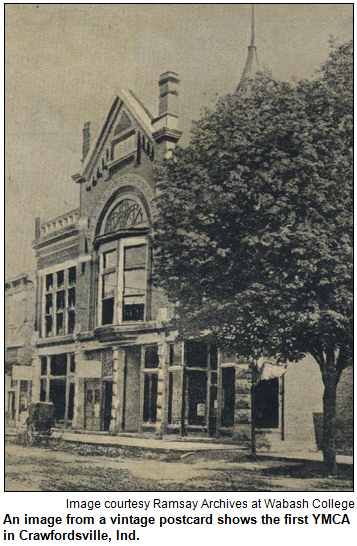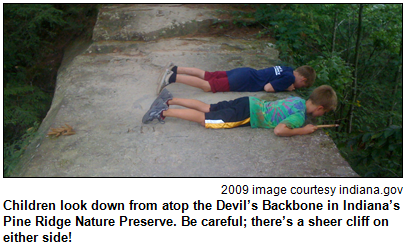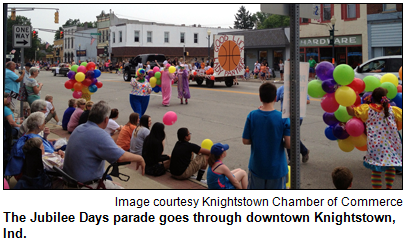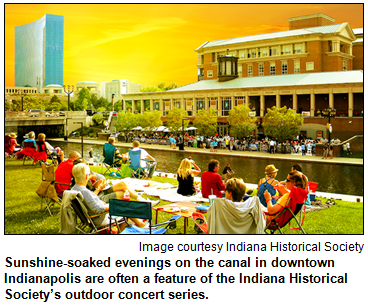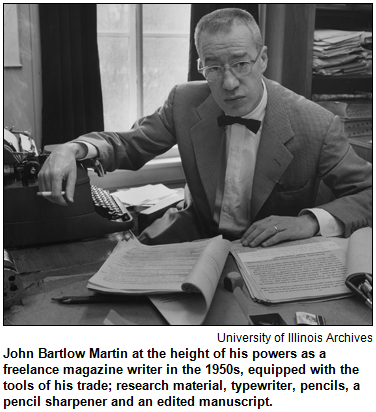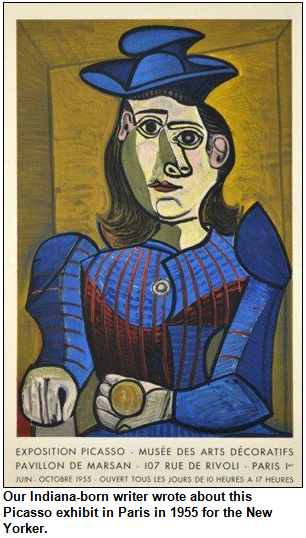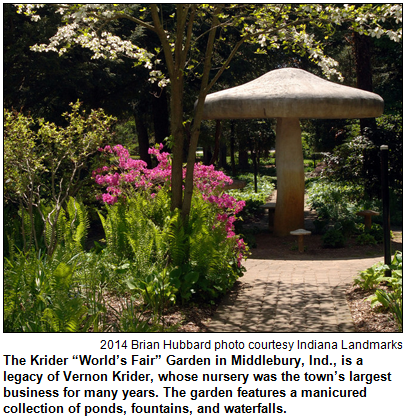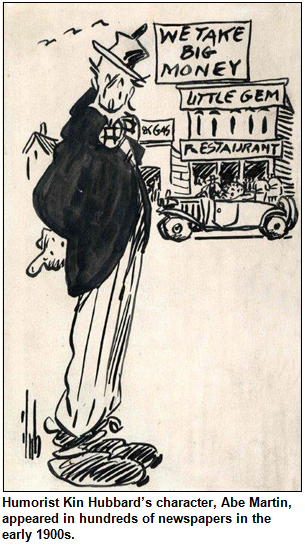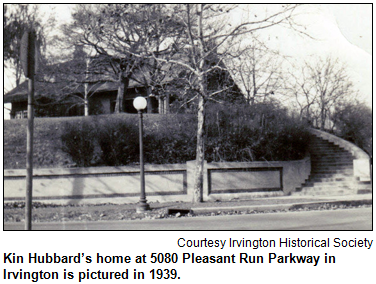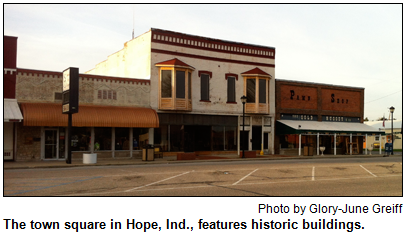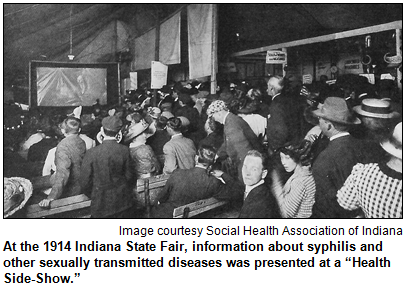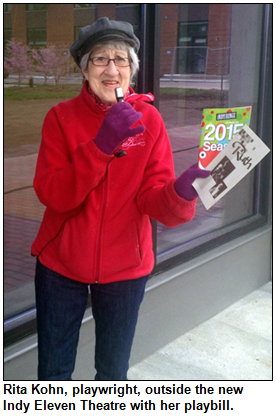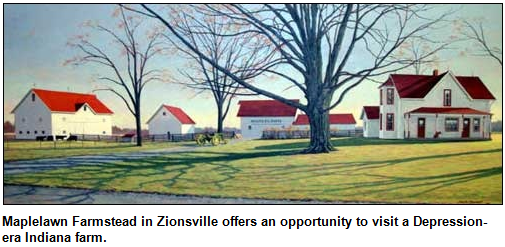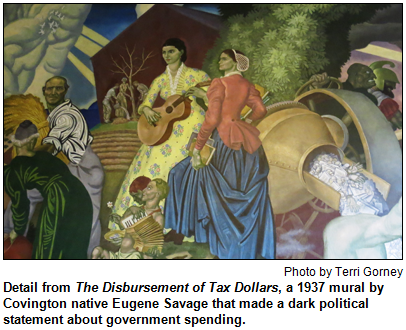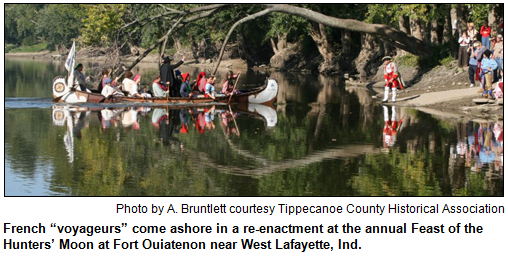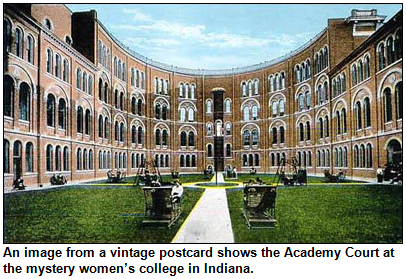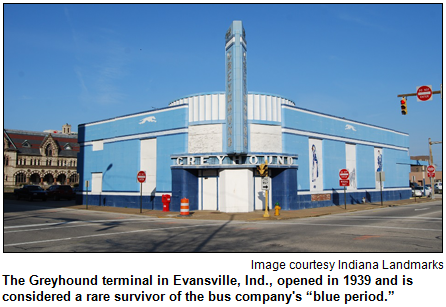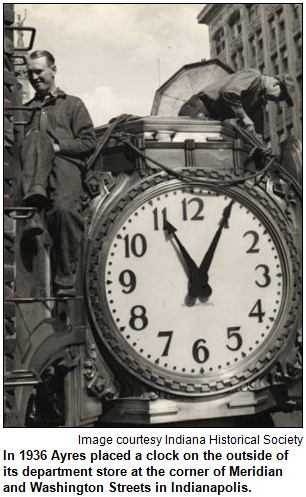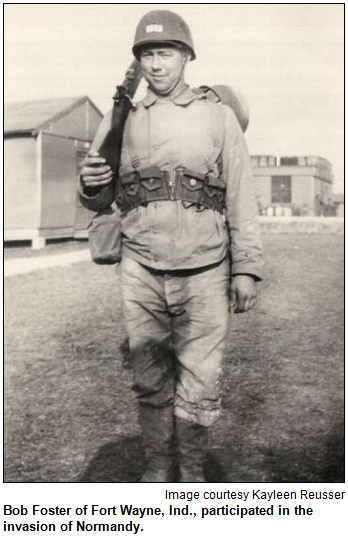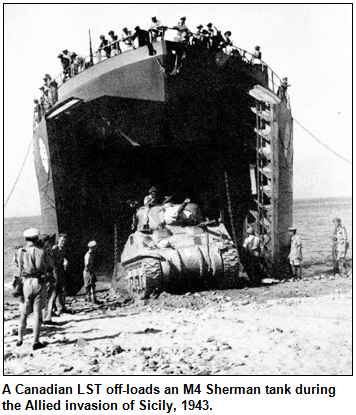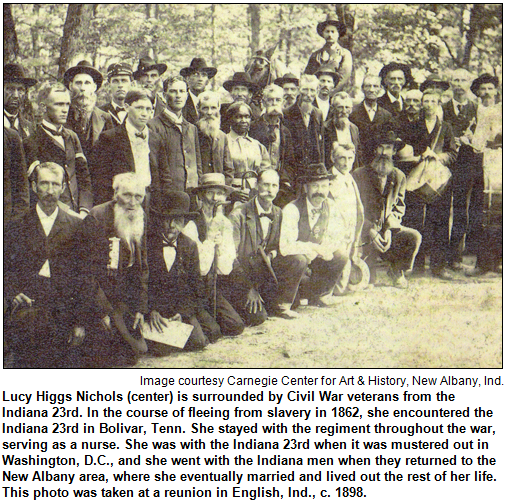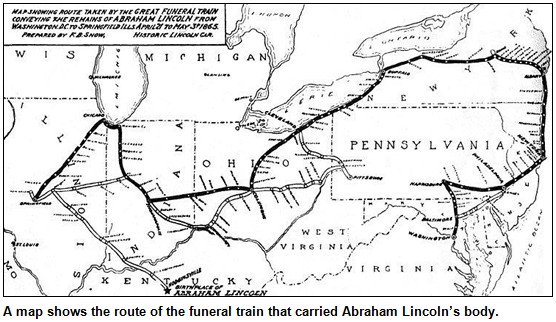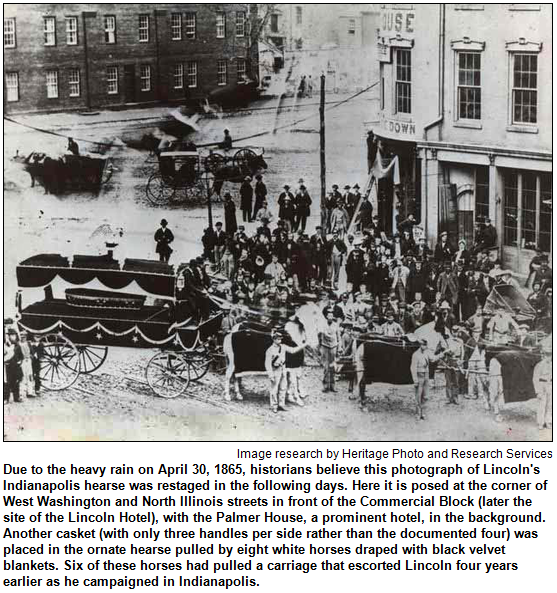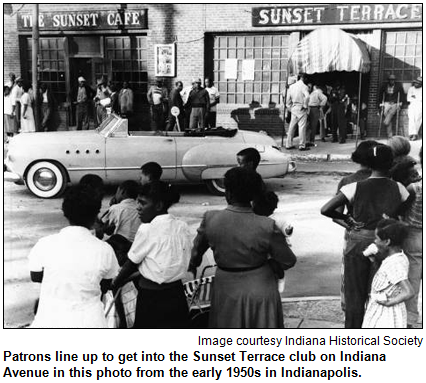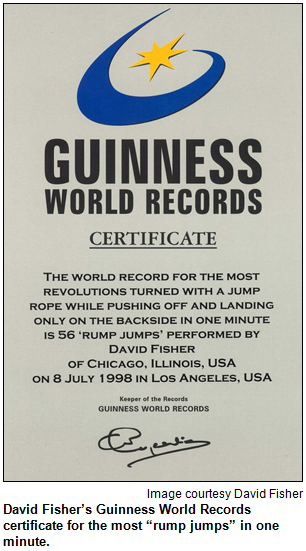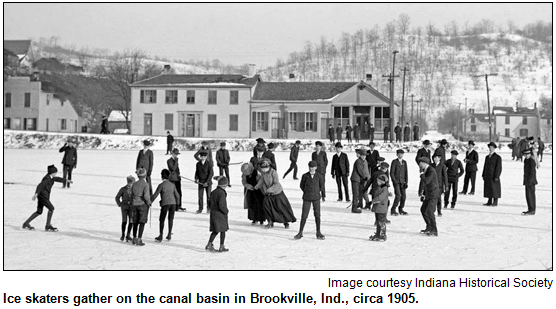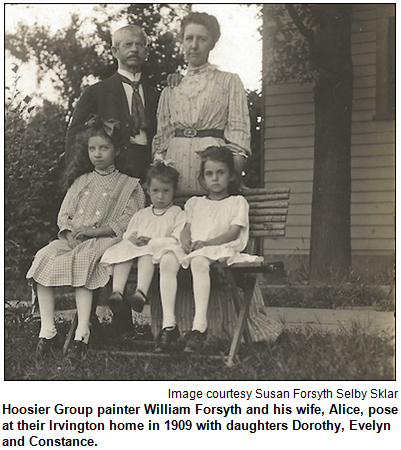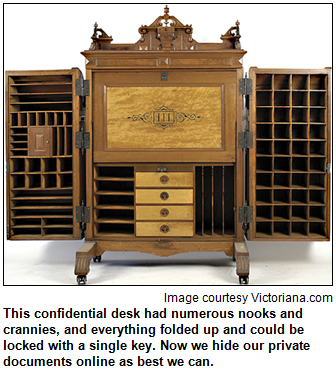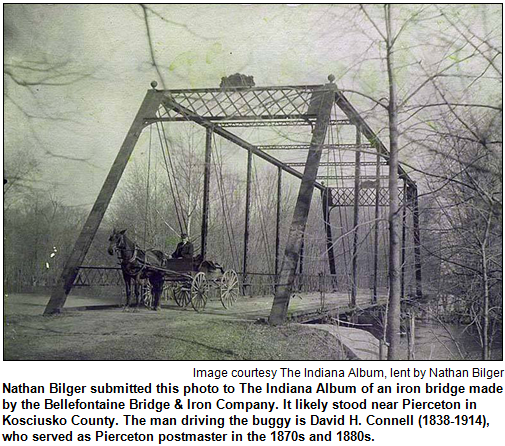Home | About us | Support the show | Contact us | Archives | Listen
2018 | 2017 | 2016 | 2015 | 2014 | 2013 | 2012 | 2011 | 2010 | 2009 | 2008
Archives - 2015
Families and children: evolution of outreach
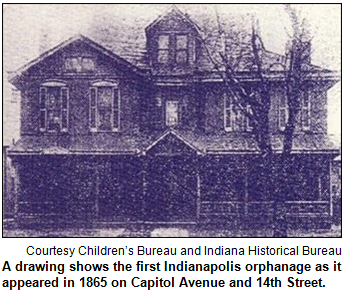 (Dec. 26, 2015 - encore presentation) - In Indiana today, you won't find places called the "Home for Friendless Women" or agencies known as "benevolent societies."
(Dec. 26, 2015 - encore presentation) - In Indiana today, you won't find places called the "Home for Friendless Women" or agencies known as "benevolent societies."
Those were some of the ways, though, that outreach was handled with families, children and other Hoosiers in need more than a century ago. During the Civil War, some early social service organizations focused on helping widows and children of soldiers, whose deaths often left their families destitute.
To explore the evolution of outreach to Hoosiers in need during this encore broadcast (original air date: Dec. 20, 2014), Nelson is joined in studio by guests from organizations whose heritages stretches back more than 100 years. Their names have changed - sometimes several times - as their approach to outreach has evolved.
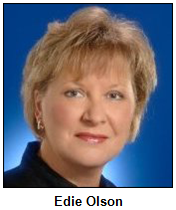 Families First, a nonprofit that is generally considered to be the oldest social service agency in the state, traces its founding to Thanksgiving Day in 1835. That's when a group of early Indianapolis movers and shakers, including attorney/banker Calvin Fletcher and civic leader James Blake, met to share ideas about helping families who were poverty-stricken because of a lack of jobs at the city's earliest factories and mills.
Families First, a nonprofit that is generally considered to be the oldest social service agency in the state, traces its founding to Thanksgiving Day in 1835. That's when a group of early Indianapolis movers and shakers, including attorney/banker Calvin Fletcher and civic leader James Blake, met to share ideas about helping families who were poverty-stricken because of a lack of jobs at the city's earliest factories and mills.
The civic leaders established the Indianapolis Benevolent Society, which, following various name changes in the 180 years since then, is now known as Families First.
Our guests include Edie Olson, the current president and CEO of Families First, an agency that now offers services ranging from counseling to domestic-violence treatment and parent-education classes. During the show, she shares insights about the evolution of social outreach in central Indiana.
 So does Tina Cloer, president and CEO of the Children's Bureau. It began in 1851 as the Widow and Orphans Friends' Society, spinning off from the Benevolent Society.
So does Tina Cloer, president and CEO of the Children's Bureau. It began in 1851 as the Widow and Orphans Friends' Society, spinning off from the Benevolent Society.
In 1880, according to a history of the Children's Bureau, "Across the state 700 children (were) living in county 'poor asylums,' a situation that many recognize as totally unacceptable."
To help, the organization founded the first orphanage in Indianapolis, which opened at Capitol Avenue and 14th Street.
Today, the Children's Bureau of Indianapolis (the agency's name since 1961) offers a range of services, including an adoption recruitment program for families involved in the state's foster-care system. The Children's Bureau offices are in the Gene Glick Family Support Center, 1575 Dr. Martin Luther King Jr. St.
Learn more:
Shopping center history in Indy
(Dec. 19, 2015) - Retail frenzy is at its peak, ideal for an exploration of the dawn of shopping centers in the Hoosier capital.
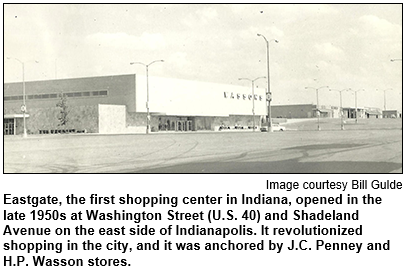 For this show, Hoosier History Live time-travels to the 1950s, which included the openings of what originally were known as Eastgate Center and Glendale Center. According to our guest Jeff Kamm, Eastgate became "the first large-scale suburban shopping center in Indianapolis" when it opened in 1957 at East Washington Street and Shadeland Avenue on the far eastside.
For this show, Hoosier History Live time-travels to the 1950s, which included the openings of what originally were known as Eastgate Center and Glendale Center. According to our guest Jeff Kamm, Eastgate became "the first large-scale suburban shopping center in Indianapolis" when it opened in 1957 at East Washington Street and Shadeland Avenue on the far eastside.
With our guide Jeff, who has researched and written about the early shopping-center scene for Historic Indianapolis, we explore Southern Plaza, Eagledale, The Meadows and other shopping centers, including some that are bygone and others that have evolved substantially since their debut.
When Glendale opened in 1958 at East 62nd Street and Keystone Avenue with the first "suburban" store of beloved L.S. Ayres, it was an open-air mall. In 1969, a roof was added, a blessing for shivering shoppers during the cold months in Indy. In 2008, Glendale returned to its origins as an open-air center. Today it is known as Glendale Town Center.
Glendale also had Ayres' rival retailer, a Block's department store, "in its original lineup," as Jeff puts it.
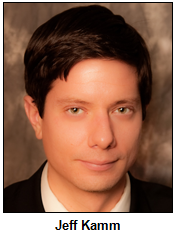 Eastgate, which featured a Sears and J.C. Penney when it opened, flourished for nearly 20 years. As Jeff notes in his Historic Indianapolis article, Eastgate early on also was the site of a Sam's Subway, a popular eatery with several Indy locations.
Eastgate, which featured a Sears and J.C. Penney when it opened, flourished for nearly 20 years. As Jeff notes in his Historic Indianapolis article, Eastgate early on also was the site of a Sam's Subway, a popular eatery with several Indy locations.
According to Eastside of Indianapolis: A Brief History (The History Press, 2009) by Julie Young, Eastgate during its heyday on 40 acres featured more than 40 stores. They included Wasson's, Sears & Roebuck, J.C. Penney, Murphy's and Harry Levinson's,, a men's clothing retailer. But by 2004, when Eastgate closed, it had been in a long, steady decline that included an era as a consumer mall.
On the Southside, Southern Plaza Shopping Center opened in 1961, with Block's and Penney as the anchors.
Eagledale on the Westside and The Meadows on the near-Northside both date to the 1950s.
"These were more neighborhood-oriented and featured discounters such as Zayre's at Eagledale and Danner's at The Meadows," our guest Jeff Kamm notes. "Both featured large supermarkets."
Wasson's also opened stores at Eagledale and The Meadows. A locally owned competitor to Ayres and Block's - although considered less upscale - Wasson's had a flagship store downtown and a heritage that dated to the 1880s, according to a recent "Retro Indy" story in The Indianapolis Star.
In the late 1960s, Wasson's was purchased by a Chicago-based retailer, which shut down all of the stores by mid-1980.
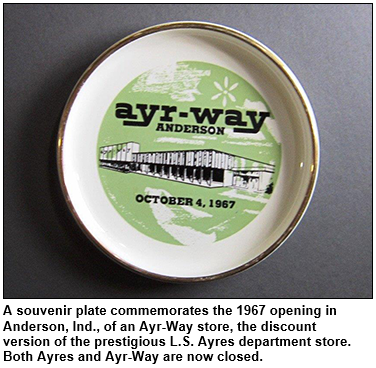 During our show, Jeff and Nelson also explore the locally based Ayr-Way chain. A discounted version of L.S. Ayres, Ayr-Way was "an early superstore ... with an attached grocery," according to Jeff. Ayr-Way was purchased by Target circa 1980.
During our show, Jeff and Nelson also explore the locally based Ayr-Way chain. A discounted version of L.S. Ayres, Ayr-Way was "an early superstore ... with an attached grocery," according to Jeff. Ayr-Way was purchased by Target circa 1980.
(Hoosier History Live explored the history of Ayres in a January 2013 show with guest Ken Turchi, the author of L.S. Ayres & Company: The Store at the Crossroads of America. Listen to audio of that show.)
Eastgate, Glendale and other early shopping centers often paved the way for much larger malls that were developed nearby. In some cases, the newer malls pulled customers away from the shopping centers and were a factor in their demise. (Case in point: Washington Square, which opened in 1974, and Eastgate.)
So during the show, Nelson and Jeff share details about the early history of Castleton Square, Lafayette Square and other malls - some of which now are struggling themselves.
Southern Plaza continues to this day, but its original anchors, Block's and Penney, eventually relocated to Greenwood Park Mall.
Block's had been founded by Hungarian immigrant William H. Block, who had studied to be a rabbi in his homeland before moving to Indianapolis in 1896, as Nelson describes in his Indianapolis Then and Now book. Block's sons oversaw expansion of the department store in various shopping centers not only in Indy but also, like Ayres, elsewhere across the state.
After a series of ownership changes, though, all of the Block's stores in Indiana became part of the Cincinnati-based Lazarus chain in 1988. Eventually, the Block's-turned-Lazarus stores were closed.
Our guest Jeff Kamm, a history lover with a background in the hospitality industry, is the operations manager for the International Center. He was a studio guest in May for a show about the history of another of his passions: bygone roadside motels.
Learn more:
- Historic Indianapolis - Jeff Kamm.
- DeadMalls.com.
- BackStory with the American History Guys, A History of Shopping.
- The Department Store Museum.
- Historic Indianapolis - The Meadows.
- Indianapolis Star - RetroIndy - H.P. Wasson and Co.
- Hoosier History Live show audio, originally aired Jan. 19, 2013 - L.S. Ayres and Company history.
- Hoosier History Live e-newsletter for Jan. 19, 2013 show - L.S. Ayres and Company history.
History Mystery
 When Glendale Shopping Center opened on the northside of Indy in 1958, its tenants included - in addition to L.S. Ayres and Block's - a locally owned retailer that was known for its upscale men's, women's and children's clothing.
When Glendale Shopping Center opened on the northside of Indy in 1958, its tenants included - in addition to L.S. Ayres and Block's - a locally owned retailer that was known for its upscale men's, women's and children's clothing.
Like Ayres and Block's, the retailer's flagship store was located in downtown Indy. In addition to the Glendale store of the clothing retailer, branches were opened in Broad Ripple and, eventually, even Fort Wayne. With its original store, dating to the 1800s, the retailer was credited with pioneering fixed prices for customers in Indianapolis.
All of the stores had been closed by the early 1990s, and the final downtown location was demolished to make way for Circle Centre mall.
Question: What was the longtime retailer known for high-end clothing?
The prize pack includes a gift certificate to Rick's Cafe Boatyard Restaurant, two tickets to the NCAA Hall of Champions and two passes to Sky Zone Trampoline Park in Fishers, all courtesy of Visit Indy.
Roadtrip - Brookston, just north of Lafayette
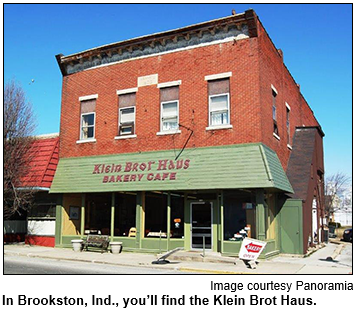 Guest Roadtripper and public historian Glory-June Greiff suggests a Roadtrip to the small town of Brookston in White County. She tells us: "I love having breakfast or lunch at the Klein Brot Haus, a bakery and restaurant at 106 E. 3rd St. in downtown Brookston. The railroad town was founded in 1853 and was named for a railroad official, James Brooks, and it's on State Road 43."
Guest Roadtripper and public historian Glory-June Greiff suggests a Roadtrip to the small town of Brookston in White County. She tells us: "I love having breakfast or lunch at the Klein Brot Haus, a bakery and restaurant at 106 E. 3rd St. in downtown Brookston. The railroad town was founded in 1853 and was named for a railroad official, James Brooks, and it's on State Road 43."
And if you're a connoisseur of Carnegie libraries, Brookston has one of those, too, built in 1915.
A little southeast of Brookston is the even smaller town of Battle Ground, site of the famous Battle of Tippecanoe, whose hallowed ground is today a National Historic Landmark. It's a quiet place to walk about and contemplate what happened there so long ago. There you'll find a museum, and a huge granite memorial erected in 1908.
Just a bit farther to the east you'll find Prophetstown State Park, which celebrates the geography of the prairie.
"Its beauty is more subtle than some of our other state parks," Glory tells us, "although in late summer the prairie is ablaze in colorful flowers."
Jingle Bell Rock and Indiana's Bobby Helms
(Dec. 12, 2015) - Put down the eggnog and raise your hand if, during the yuletide season, you are among the few who have never heard the classic pop tune Jingle Bell Rock.
Ever since 1957, when the song originally was recorded by Indiana native Bobby Helms for Decca Records, Jingle Bell Rock has been a seasonal favorite. It is played on radio stations and at shopping centers, holiday bazaars, festivals and wherever merry-makers gather 'round to celebrate the holidays.
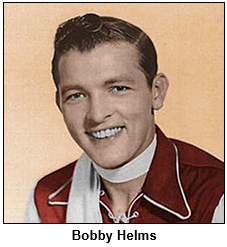 Hoosier History Live explores the colorful heritage of the song, as well as the life of Bobby Helms (1933-1997), the multitalented musician who was born in Bloomington, lived for many years in Martinsville and made Jingle Bell Rock famous. His big year was 1957, when Decca also released two other hit songs recorded by Bobby Helms: My Special Angel and Fraulein.
Hoosier History Live explores the colorful heritage of the song, as well as the life of Bobby Helms (1933-1997), the multitalented musician who was born in Bloomington, lived for many years in Martinsville and made Jingle Bell Rock famous. His big year was 1957, when Decca also released two other hit songs recorded by Bobby Helms: My Special Angel and Fraulein.
Nelson is joined in studio by John Kleiman, a Greenfield native who became Helms' personal manager (and close friend) for the last 10 years or so of the musician's life.
John, who lives on the eastside of Indy, also is a screenwriter - his credits include the movie Pushed Too Far (1988) starring Claude Akins - as well as an author, poet and music-industry veteran who has worked closely with many Nashville-based country entertainers and members of the Grand Ole Opry.
Referring to Jingle Bell Rock, John says: "Bobby originally did not want to do it because he didn't believe it was right to mix rock and roll with Christmas. So the song does not mention Christmas anywhere."
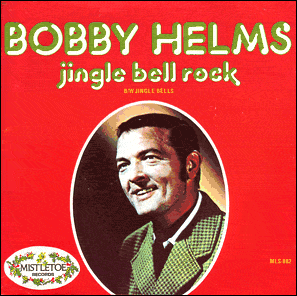 Although accounts differ about credits for the lyrics and music, John Kleiman says Helms wrote most of the words and that the tune was a joint effort between the Hoosier and Hank "Sugarfoot" Garland, who plays the guitar lead-in on the original version of Jingle Bell Rock.
Although accounts differ about credits for the lyrics and music, John Kleiman says Helms wrote most of the words and that the tune was a joint effort between the Hoosier and Hank "Sugarfoot" Garland, who plays the guitar lead-in on the original version of Jingle Bell Rock.
In the nearly 60 years since the tune was released, Jingle Bell Rock has been covered by vocalists ranging from Brenda Lee, Johnny Mathis and Neil Diamond to the Jonas Brothers and Amy Grant. It has been featured on the soundtrack of movies such as Home Alone 2 (1992).
Bobby Helms was 63 years old when he died of emphysema and asthma in 1997. He had been performing most of his life, having grown up in a musical family. In the early 1950s, he began performing with his brother, Freddy, as The Helms Brothers; a regional success, the duo appeared on Hayloft Frolic, a TV show in Bloomington.
As a solo entertainer, Bobby Helms kicked off his long career with Fraulein, which climbed to No. 1 on the country music charts in April 1957. Next came My Special Angel, which also hit No. 1 on the country charts in October of that year, followed by the eternal Jingle Bell Rock, which was released two days before Christmas.
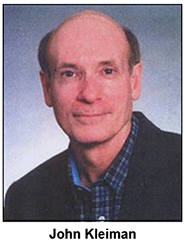 According to our guest John Kleiman, future legend Patsy Cline traveled and sang backup with Bobby Helms for three years. Country great George Jones was his lead guitarist for several years.
According to our guest John Kleiman, future legend Patsy Cline traveled and sang backup with Bobby Helms for three years. Country great George Jones was his lead guitarist for several years.
John Kleiman has managed a country music venue in addition to his career as a personal manager, writer, poet and songwriter. His books include Cast a Giant Shadow, a biography of another famous person associated with Martinsville: the late Sandy Allen, who was the world's tallest woman. John's song Soldiers Prayer was recorded by Bobby Helms.
Other tidbits:
- The original Jingle Bell Rock was recorded by Helms in just two takes, according to John Kleiman.
- Beginning in the 1970s, Helms often wore an eye patch. In interviews, he explained this was due to an eye sensitivity that began with an ulcerated cornea during his adolescence.
- Other books by John Kleiman include Santa's Christmas Secret and Red the Talking Sled.
Learn more:
- Listen to Jingle Bell Rock.
- Listen to My Special Angel.
- Listen to Fraulein.
History Mystery
Not only has Bobby Helms been inducted into the Rockabilly Hall of Fame, an exhibit earlier this year at the Country Music Hall of Fame in Nashville, Tenn., celebrated another singer with deep Indiana roots.
 Although this singer was born in Kentucky, she moved to Wabash, Ind., when she was just 3 or 4 years old and considers it her hometown. She graduated from Wabash High School and enjoyed her biggest hit in the mid-1970s with a soulful tune that topped both the pop and music charts. She also won a Grammy Award for the song.
Although this singer was born in Kentucky, she moved to Wabash, Ind., when she was just 3 or 4 years old and considers it her hometown. She graduated from Wabash High School and enjoyed her biggest hit in the mid-1970s with a soulful tune that topped both the pop and music charts. She also won a Grammy Award for the song.
The singer continues to perform across the country; in recent years, she has released albums of children's music and songs written by famous Hoosier composer Hoagy Carmichael.
Question: Who is she?
Hint: Her older sister, who is associated with Kentucky, also is a famous singer.
The prize pack includes a gift certificate to Cadillac Ranch Bar and Grill, two tickets to the Indiana Experience at the Indiana History Center and two tickets to the Benjamin Harrison Presidential Site, all courtesy of Visit Indy.
Roadtrip - Pigeon River
 Guest Roadtripper and volunteer naturalist Terri Gorney of Fort Wayne suggests a visit to Pigeon River Fish and Wildlife Area near Mongo in far northeastern Indiana. It is one of the many natural gems operated by the DNR, and it's a great place for canoeing, kayaking, fishing, hiking and, of course, for Terri, birding! Canoes and kayaks also can be rented at the Trading Post in Mongo.
Guest Roadtripper and volunteer naturalist Terri Gorney of Fort Wayne suggests a visit to Pigeon River Fish and Wildlife Area near Mongo in far northeastern Indiana. It is one of the many natural gems operated by the DNR, and it's a great place for canoeing, kayaking, fishing, hiking and, of course, for Terri, birding! Canoes and kayaks also can be rented at the Trading Post in Mongo.
Terri tells us that osprey were successfully re-introduced 10 years ago at Pigeon River, and platforms have been built for nesting. The National Audubon Christmas Bird Count takes place this year on Dec. 20. Pigeon River also is a major resting place for Indiana's famous sandhill cranes in spring and fall migration. More than 1,300 cranes - a high number - were counted on Nov. 9 by Mark Weldon, curator of the Fort Wayne Children's Zoo.
And Terri quotes retired naturalist Fred Wooley, who says of Pigeon River: "Wildlife watching abounds. Its shores spread into fens and wetlands featuring a variety of floral displays, some rare."
Scottish heritage in Indiana
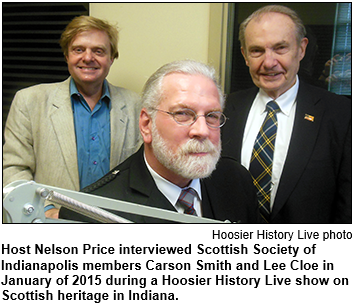 (Dec. 5, 2015 - encore presentation) - To kick off the merry month of December in high style - or should that be Highlands and Lowlands style? - we present one of our ethnic heritage shows.
(Dec. 5, 2015 - encore presentation) - To kick off the merry month of December in high style - or should that be Highlands and Lowlands style? - we present one of our ethnic heritage shows.
Scottish heritage in Indiana is the focus of this encore broadcast of one of the most popular programs in our Hoosier History Live archives. (Its original air date was Jan. 3, 2015). Scots became the fourth most numerous European heritage group in Indiana, according to Peopling Indiana: The Ethnic Experience (Indiana Historical Society Press, 1996). They were exceeded only by residents of German, Irish and English descent.
"A trait of Scots who are immigrants is the tendency to assimilate rather than cluster," says Dr. Lee Cloe, a Noblesville native and charter member of the Scottish Society of Indianapolis. "While in most large cities, one can find 'Chinatown,' 'Greektown' or other groupings, you will not see a 'Scottstown.' 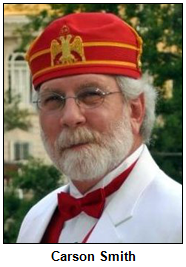 Normally after two generations, they did not refer to themselves as Scots, but Americans."
Normally after two generations, they did not refer to themselves as Scots, but Americans."
Dr. Cloe, a retired U.S. Air Force pilot, training officer and commander (he retired with the rank of major), joins Nelson in studio for this show.
So does Carson Smith, a past president of the Scottish Society of Indianapolis. Carson frequently was quoted by Indiana media during the referendum in his ancestral homeland in 2014 to break from the United Kingdom after more than 300 years. 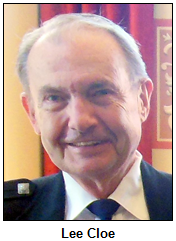 The move to secede was unsuccessful. Scotland accounts for one-third of the U.K.'s land, 8 percent of the population and 10 percent of the tax revenue, according to news reports at the time.
The move to secede was unsuccessful. Scotland accounts for one-third of the U.K.'s land, 8 percent of the population and 10 percent of the tax revenue, according to news reports at the time.
Ever wonder what the term Scotch-Irish means?
Our distinguished guests provide explanations, along with sharing insights about how and why a mix of people with Scottish heritage were among the first people to survey the early Virginia Colony and European heritage settlers to penetrate the Appalachian Mountain range in the 1780s.
Today, Scottish societies flourish in Hoosier cities such as Bloomington and Fort Wayne.
According to several sources, many Scots were recruited to help build railroads in the area around Columbus, which hosts a popular Scottish Festival every September. Even so, our guest Dr. Cloe notes that Scots did not tend to arrive in "waves" to Indiana, unlike some other ethnic heritage groups.
In our rotating series during our nearly eight years on the air, Hoosier History Live has explored a vast range of ethnic heritage groups in Indiana. Our series has included shows about the Irish, Russians, Cubans, Scandinavians and, most recently, Persian/Iranian immigration.
Learn more:
- Watch video by Matt Douglass, 2011 Indianapolis Scottish Highland Games.
Dan Wakefield on the home front during WWII
|
In the Broad Ripple neighborhood of Indianapolis, a boy who would grow up to be one of the state's best-known literary figures served as a junior air raid warden during World War II.
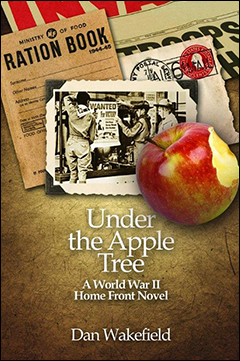 Dan Wakefield recalls "looking for enemy planes from the porch of my house" during his junior air raid warden stint.
Dan Wakefield recalls "looking for enemy planes from the porch of my house" during his junior air raid warden stint.
He shares details about that stint - as well as other insights about the home front in Indiana during the war, including anti-Japanese propaganda told to school children, backyard victory gardens and hunts for scrap metal to assist the war effort - as he makes a return visit as Nelson's studio guest.
Many of these aspects of home-front life are featured in the new re-release of Under the Apple Tree (Hawthorne Publishing), Dan's coming-of-age novel that originally was published in 1982. The central character is a boy who is not quite 11 years old when the plot begins in 1941.
Dan, whose other bestsellers include Going All the Way (1970), was named the "Lifetime Achievement Honoree" earlier this year as part of the NUVO Cultural Vision Awards. In 2012, he also received a lifetime achievement honor as part of the Indiana Authors Awards. And a proposal to name a Broad Ripple park in his honor is being considered by Indy city officials.
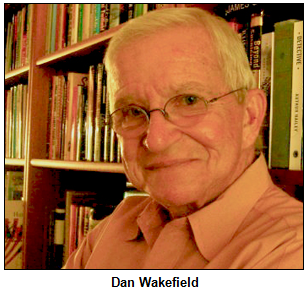 As a Boy Scout during World War II, Dan attended a summer camp where Gov. Henry Schricker described how Nazis tortured American soldiers (including former Boy Scouts) who refused to reveal secrets. The horrific details lingered for weeks with the campers, as they do in a scene involving a fictional politician in Under the Apple Tree, which is set in Illinois.
As a Boy Scout during World War II, Dan attended a summer camp where Gov. Henry Schricker described how Nazis tortured American soldiers (including former Boy Scouts) who refused to reveal secrets. The horrific details lingered for weeks with the campers, as they do in a scene involving a fictional politician in Under the Apple Tree, which is set in Illinois.
According to Dan, he learned only much later about the existence of internment camps for U.S citizens of Japanese heritage during the war.
In addition to discussing aspects of home-front life on our show, Dan explains why he did not set Under the Apple Tree in Indianapolis, unlike Going All the Way. The latter was made into a movie starring Ben Affleck that was filmed in Indianapolis in 1996.
Dan Wakefield, who graduated from Shortridge High School in 1950, returned to live in his hometown in 2011 after spending decades in Miami, New York City and Boston.
Since his return, he has been our guest for shows about Indy landmarks from the 1950s - the decade in which Going All the Way is set - as well as about Kurt Vonnegut. Dan, a close friend of the literary great, edited and wrote the introduction for Kurt Vonnegut Letters (Delacorte Press/Random House, 2012).
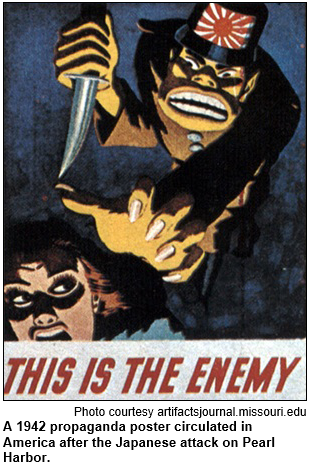 In Under the Apple Tree, a scene in the first chapter involves Artie, the main character, sipping a "rainbow Coke" (made from every kind of syrup at a soda fountain) on a Sunday - Dec. 7, 1941 - when he hears a radio broadcast about the bombing of Pearl Harbor.
In Under the Apple Tree, a scene in the first chapter involves Artie, the main character, sipping a "rainbow Coke" (made from every kind of syrup at a soda fountain) on a Sunday - Dec. 7, 1941 - when he hears a radio broadcast about the bombing of Pearl Harbor.
Before too long, Artie, like Dan Wakefield, is serving as a junior air raid warden. He also starts collecting scrap metal; according to Dan, children were told that "7,700 pans made a pursuit plane."
During our show, Dan shares details about how children pasted "defense stamps" over cartoon depictions of Japanese; "Slap the Jap Right Off the Map" was a slogan frequently emblazoned on the stamps.
Meanwhile, families who lost loved ones in war service placed blue and gold stars in their windows.
Other aspects of life on the home front featured in Under the Apple Tree include gas rationing stickers; the Green Hornet hero and Ovaltine, a popular hot beverage. Artie's older brother Roy, a high school student, quickly enlists in the Marines, as did a neighbor of the Wakefield family.
Dan grew up in the 6100 block of North Winthrop Avenue. The city park that may be named in his honor is nearby at Broadway and 61st streets.
In addition to writing Going All the Way and Under the Apple Tree, Dan is the author of three other novels and 15 non-fiction books, including memoirs. He also has had a long career as a journalist.History Mystery
|
At Shortridge High School in Indianapolis, classmates of our guest Dan Wakefield included another future famous Hoosier. Both were members of the Class of 1950. Both wrote for The Echo, the widely acclaimed daily newspaper at Shortridge.
Instead of becoming a writer, though, the classmate eventually enjoyed a long career in Indiana politics.
Question: Who is he?
The prize pack includes a two passes to the Eiteljorg Museum, two tickets to the Mind Tripping Show, a comedy club in downtown Indy, and two tickets to the NCAA Hall of Champions, all courtesy of Visit Indy.
Ask Nelson - and Indy Star's history reporter
(Nov. 21, 2015) - A couple of times every year at Hoosier History Live, we like to take full advantage of the fact that we are a live, call-in show. So we turn the tables on our host, author/historian Nelson Price, open the phone lines and give our listeners an opportunity to question the interviewer who calls himself "a garbage can of useless Hoosier trivia."
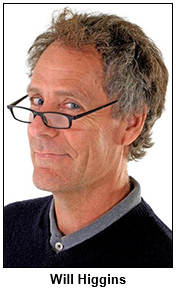 For these "Ask Nelson" shows, our host typically is joined by a media colleague who pitches in and shares history insights.
For these "Ask Nelson" shows, our host typically is joined by a media colleague who pitches in and shares history insights.
This time, Nelson's co-host is one of his former colleagues at The Indianapolis Star.
Will Higgins writes about local history and preservation for the state's largest newspaper; like Nelson, Will grew up in the Hoosier capital.
In between calls from listeners, the co-hosts typically interview each other.
Their topics include the history of Keystone at the Crossing, the bustling, upscale retail area on the northside of Indy.
Remember the anachronistic silo that served as a landmark to the shopping area during the 1970s and '80s? The silo stood tall during the era when the elegant Fashion Mall was co-existing with the Bazaar, an unusual, "open" concept in retailing that involved a lot of wicker and ramps.
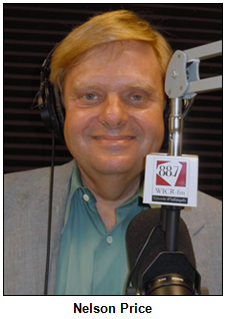 Both Nelson and Will have written about various aspects of the area's heritage, Nelson for a revised edition of his Indianapolis Then and Now visual history book that will be published early in the new year, and Will for stories in The Star about the late Oliver P. Daugherty, who left 16 wooded acres that became a public nature preserve near the mall. (Daugherty, who died in 2009, lived in a house that his great-grandfather built in the mid-1800s; even as retailing boomed around his land, Daugherty had refused to sell it to developers.)
Both Nelson and Will have written about various aspects of the area's heritage, Nelson for a revised edition of his Indianapolis Then and Now visual history book that will be published early in the new year, and Will for stories in The Star about the late Oliver P. Daugherty, who left 16 wooded acres that became a public nature preserve near the mall. (Daugherty, who died in 2009, lived in a house that his great-grandfather built in the mid-1800s; even as retailing boomed around his land, Daugherty had refused to sell it to developers.)
Other topics include the South Bend-based Studebaker Corp., which made automobiles, including the sleek Avanti, until the assembly line finally shut down in 1963.
According to recent news reports, entrepreneurs and city officials in South Bend hope to convert a sprawling, six-story former Studebaker building into a hub for high-tech businesses and maybe even condos, shops and restaurants.
Will has written about pioneering industrial engineer Raymond Loewy, who designed the Studebaker Avanti. In 1963, Loewy donated a rare Picasso to the Evansville Museum of Arts, History and Science, which forgot it owned the glass sculpture until it was uncrated three years ago; Will shares details during our show.
Also during our show, co-host Will shares details about notorious Morris Lynn Johnson, a bank robber who, as Will puts it, "was the scourge of Indianapolis from the 1950s to '70s."
According to Will, Johnson, who is in his late 70s, robbed far more banks than the much better-known John Dillinger and broke out of prison three times, compared to Dillinger's two. Will has interviewed Johnson, who is imprisoned at a federal penitentiary in Arkansas.
More broadly, Will also discusses what he calls "history chic" - "how millennials are much more interested in local history than previous generations."
Primarily, though, these all-call-in shows are an opportunity to call in and ask questions of - or share insights with - our Hoosier history-loving co-hosts. Media notables who have joined our host for previous "Ask Nelson" shows include gardening guru Jo Ellen Meyers Sharp, "Indiana's Weatherman" Paul Poteet and Sam Stall, who writes "The Hoosierist" column for Indianapolis Monthly magazine.
History Mystery
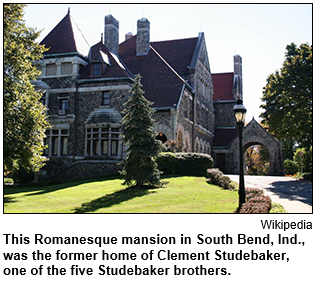 Clement Studebaker, the second-oldest of the five brothers whose business made wagons (and, later, cars) lived in a South Bend mansion built in the 1880s. Designed in the Romanesque style, the mansion was Clement Studebaker's home until his death in 1901.
Clement Studebaker, the second-oldest of the five brothers whose business made wagons (and, later, cars) lived in a South Bend mansion built in the 1880s. Designed in the Romanesque style, the mansion was Clement Studebaker's home until his death in 1901.
After that, the Studebaker mansion, which has a distinctive name, had a series of varied uses. For many years, though, the historic mansion has been a popular, upscale restaurant in South Bend. It has been designated a National Historic Landmark.
Question: What is the name of the Clement Studebaker mansion-turned-restaurant?
Hint: Clement Studebaker's close friend was Benjamin Harrison, the only president elected from Indiana. The mansion-turned-restaurant's name is derived from an event associated with Harrison's family.
The prize pack includes a gift certificate to Cadillac Ranch Restaurant, courtesy of Visit Indy, two admissions to Glow Golf, the miniature golf course at the Circle Centre Mall, courtesy of Glow Golf, and two tickets to Conner Prairie Interactive History Park, courtesy of Conner Prairie.
Roadtrip - Historic Lafayette
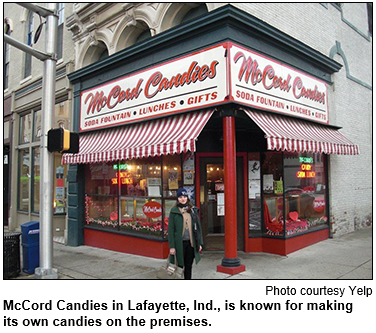 Guest Roadtripper and Film Historian Eric Grayson tells us: "Today's Roadtrip trip is to historic Lafayette, northwest of Indianapolis in Tippecanoe County."
Guest Roadtripper and Film Historian Eric Grayson tells us: "Today's Roadtrip trip is to historic Lafayette, northwest of Indianapolis in Tippecanoe County."
Says Eric: "First off, we go to Lafayette's Columbian Park Zoo. This is a rather small city zoo, but it's quite beautiful and well-cared-for. It dates back to the 1870s, but it's been updated a lot since then; you can still see a lot of old buildings there. From there, check out the Tippecanoe County Courthouse, which was built in 1881. If you're a sculpture fan, there's a Lorado Taft fountain on the corner, which is one of his earliest commissioned works."
For lunch, just down the street from the courthouse is McCord Candies, which is not just a wonderful candy shop but has a full lunch counter and a soda fountain. Bonus: you can watch a video of candy canes being made by hand at McCord's during the 2007 Christmas season.
We'll cap the Roadtrip off with a visit to the John H. Myers Bridge. This is an old bridge that, as in so many communities, has been converted into a pedestrian bridge. At the head of the bridge is the Big Four Depot, built in 1902.
"Out on the bridge, depending on the time of day, it's not hard to see blue herons," Eric says, "and there are a number of eagles who live nearby. Some people have reported seeing two or three at a time."
Kurt Vonnegut's siblings
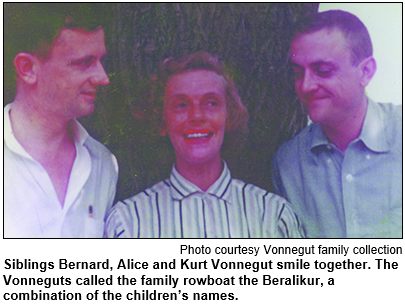 (Nov. 14, 2015) - The youngest sibling in a family from Indianapolis became an internationally known literary figure.
(Nov. 14, 2015) - The youngest sibling in a family from Indianapolis became an internationally known literary figure.
Another, who as a boy enjoyed experiments with his chemistry kit in the family's basement - became one of the world's foremost experts on climate control, particularly cloud seeding and other ways to enhance precipitation.
And another sibling became an artist but died young amid some family tragedies.
Kurt Vonnegut, beginning in childhood, adored his achievement-oriented older siblings, Bernard and Alice.
"The three siblings only grew closer as they aged," writes Ginger Strand, author of a new book, The Brothers Vonnegut (Farrar, Straus and Giroux).
Her book explores the relationships among Kurt Vonnegut (1922-2007), the author of Slaughterhouse-Five (1969), Cat's Cradle (1963) and other bestsellers, and his brother, who patented a series of "cutting-edge" technologies related to weather control, and his sister, who often served as the muse for Kurt's writing.
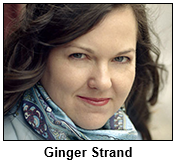 Fresh from appearances in Indianapolis as part of the annual Vonnegut Fest, Ginger is our guest to share insights about the siblings, whose grandfather and father were prominent Indiana architects.
Fresh from appearances in Indianapolis as part of the annual Vonnegut Fest, Ginger is our guest to share insights about the siblings, whose grandfather and father were prominent Indiana architects.
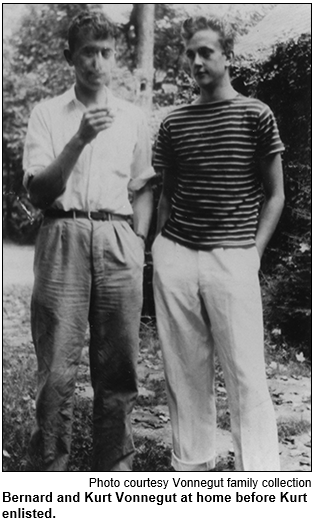 Their great-grandfather, Clemens Vonnegut, immigrated from Germany in the 1850s and founded a hardware store. By the time it sold in the mid-1960s, Vonnegut Hardware had expanded to a chain and had become the oldest family-owned business in the Hoosier capital.
Their great-grandfather, Clemens Vonnegut, immigrated from Germany in the 1850s and founded a hardware store. By the time it sold in the mid-1960s, Vonnegut Hardware had expanded to a chain and had become the oldest family-owned business in the Hoosier capital.
Alice Vonnegut Adams, who was born in 1917, became the first of the three siblings to pass away, succumbing to cancer in 1958, just two days after her husband was killed in a freak train accident. Kurt Vonnegut and his first wife, Jane, took in their orphaned sons and raised them with their own three children. (Years later, Kurt and his second wife, Jill, adopted a daughter.)
Bernard Vonnegut (1914-1997) earned a Ph.D. and, during World War II, worked in the Army's chemical warfare laboratory on secret ways to de-ice aircraft.
Kurt Vonnegut had been majoring in chemistry at Cornell University but was placed on academic probation and dropped out during the war. As a private in an Army infantry regiment, he was taken prisoner by the Nazis during the Battle of the Bulge. Along with other POWs, he was imprisoned in an underground meat locker in Dresden, an experience that later served as the basis for Slaughterhouse-Five.
That's a long way from the idyllic summers at Lake Maxinkuckee that the three Vonnegut siblings spent during their childhood and teen years at the family's cabin in Culver.
In Indianapolis, Bernard and Alice were "A" students at, respectively, Park School and Tudor Hall.
"He (Kurt) had learned early that the best way for a third child to be heard at the dinner table was to crack a joke," our guest Ginger Strand writes in The Brothers Vonnegut. "Being funny was the only way he got them to stop interrupting and listen to him. Besides, his brother was brilliant, and his sister was artistic and beautiful. 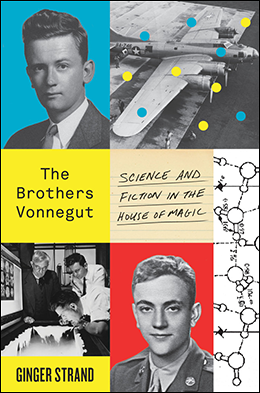 He couldn't compete on brains or glamour. So he nurtured his penchant for humor."
He couldn't compete on brains or glamour. So he nurtured his penchant for humor."
In an interview with Nelson, our host, Kurt Vonnegut once said, "I write with my sister in mind. The jokes are ones that she would enjoy."
Alice, like Bernard and Kurt, spent most of her adult life on the East Coast. After World War II, Kurt Vonnegut lived in Chicago for a while, though. He completed his college studies, majoring in anthropology at the University of Chicago, and then moved to upstate New York.
That's where, during the 1950s, both Vonnegut brothers worked for General Electric. In her book, Ginger describes how Bernard became a "leading scientist at what was called the House of Magic, GE's research lab ... the nation's oldest and most renowned industrial lab."
Kurt, meanwhile, worked in the PR department at GE. His stint in PR, although unlikely for a writer known for his irreverence, was one that Kurt Vonnegut thoroughly enjoyed, he later told interviewers, including Nelson.
In her book, Ginger describes how the central character in Cat's Cradle, an absent-minded scientist, is based on Bernard's favorite boss at GE. The plot involves "Ice-9," a more stable version of ice that melts only at a high temperature. When it comes into contact with water (including parts of the human body, which primarily is water), Ice-9 causes crystallization - and often, as a result, death.
History Mystery
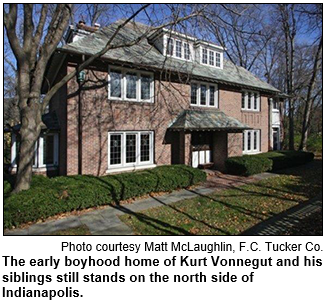 In the 1920s, Kurt Vonnegut Jr. lived with his two older siblings, Bernard and Alice, and their parents in an Arts and Crafts-style house on the northside of Indianapolis. With oak woodwork, built-in bookshelves and leaded-glass windows, the fashionable house was the family home while Bernard and Alice attended the exclusive, private Park School and Tudor Hall, respectively.
In the 1920s, Kurt Vonnegut Jr. lived with his two older siblings, Bernard and Alice, and their parents in an Arts and Crafts-style house on the northside of Indianapolis. With oak woodwork, built-in bookshelves and leaded-glass windows, the fashionable house was the family home while Bernard and Alice attended the exclusive, private Park School and Tudor Hall, respectively.
With the onset of the Great Depression, the Vonneguts endured significant financial setbacks. To economize, young Kurt Jr. was sent to public schools, and the family moved in the early 1930s into another house. Although only one or two blocks from the initial home - and located on the same street - the family's second house was less impressive.
Question: What is the street on the north side of Indianapolis where both houses were located?
The prize pack includes a gift certificate to Rick's Cafe Boatyard, courtesy of Visit Indy, two admissions to Glo Golf, the miniature golf course at the Circle Centre Mall, courtesy of Glo Golf, and two tickets to the Indiana State Museum, courtesy of the Indiana State Museum.
Epidemics in Indiana history
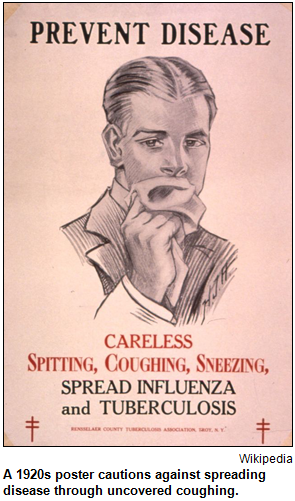 (Nov. 7, 2015 - encore presentation) - Flu season is upon us, and the Ebola panic of last year certainly hasn't been forgotten. So Hoosier History Live will explore epidemics in Indiana's past.
(Nov. 7, 2015 - encore presentation) - Flu season is upon us, and the Ebola panic of last year certainly hasn't been forgotten. So Hoosier History Live will explore epidemics in Indiana's past.
Did you know a malaria epidemic swept Indianapolis just as the Hoosier capital was getting under way in the 1820s? Some doctors blamed the epidemic on the swamps and marshland that were on the new city's site, chosen because of its central location.
The impact of that early epidemic, plus others that affected Indiana, is the focus of this encore broadcast (original air date: Nov. 15, 2014) featuring two Indianapolis-based medical historians as Nelson's studio guests.
The influenza epidemic of 1918, a cholera epidemic of the mid-1800s, the polio scare that prevailed for most of the first half of the 20th century and the AIDS epidemic that caused panic during the 1980s and '90s are among the crises explored during the show.
Nelson and his guests also explore the devastating impact of tuberculosis during the late 1800s and early 1900s - even though "epidemic" may not be the most accurate term to describe the widespread TB cases. (Tune in to the show for an explanation.)
Our studio guests are:
- Dr. William McNiece, president of the Marion County Historical Society. Dr. McNiece is an anesthesiologist at IU Health's Riley Hospital for Children.
- Bill Beck, an author and historian who has written dozens of business and institutional history books, including histories of Indiana hospitals. The founder of Lakeside Writers' Group, he is treasurer of the Marion County Historical Society.
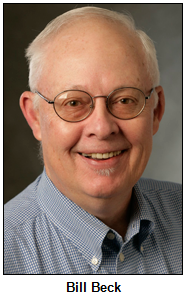 During the show, our guests share insights about the panic over potential epidemics, including a swine flu scare in 1976, when a vaccination program encountered various public relations problems. Fears of an epidemic proved unfounded.
During the show, our guests share insights about the panic over potential epidemics, including a swine flu scare in 1976, when a vaccination program encountered various public relations problems. Fears of an epidemic proved unfounded.
Time-traveling much farther back, outbreaks of cholera during the 1830s, '40s and subsequent decades caused extreme panic in many Indiana communities.
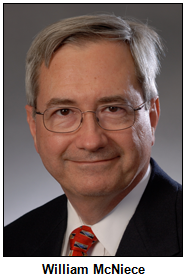 Take the town of Aurora on the Ohio River, which had a population of 2,000 in 1849. Fourteen deaths from cholera were reported in one day, according to a historical account supplied by Dr. McNiece, an associate professor at the IU School of Medicine. During the next three weeks in 1849, 51 other victims died in Aurora. As a result, 1,600 of the 2,000 residents fled the town.
Take the town of Aurora on the Ohio River, which had a population of 2,000 in 1849. Fourteen deaths from cholera were reported in one day, according to a historical account supplied by Dr. McNiece, an associate professor at the IU School of Medicine. During the next three weeks in 1849, 51 other victims died in Aurora. As a result, 1,600 of the 2,000 residents fled the town.
Also in 1849, the town of Madison reacted to outbreaks of cholera by creating a board of health with the power to quarantine residents and to impose fines on people who brought the disease into the city.
On Hoosier History Live, we have explored some epidemics on previous programs.
In 2009, Bill Beck was a guest for a show about the 1918 influenza epidemic and its Indiana impact. That horrific epidemic, which ravaged North America and Europe, is considered to have been the world's worst flu epidemic; it coincided with - then persisted after - World War I.
In 2012, Hoosier History Live explored various aspects of the polio epidemic, including the involvement of Eli Lilly and Co. in distributing the polio vaccine during the 1950s.
For this show, we broaden the focus and explore those epidemics, as well as several others.
Learn more:
- Black Cholera comes to Central Valley of America in 19th Century - Walter Daly, M.D.
- Flu lessons from history - Indianapolis Star.
- Polio epidemic during the 1940s and '50s - Hoosier History Live show.
- Centers for Disease Control and Prevention.
- The influenza epidemic of 1918 - National Archives.
- The Great Pandemic.
- 1821 Plague Cemetery, Indianapolis.
- Damien Center.
- Ancestry, Cholera Epidemic in Dearborn County, 1849-1851.
Race relations in 1950s Indy: rare perspectives
|
(Oct. 31, 2015) - While growing up in Indianapolis during the 1950s, one of our guests, a white youth, attended Shortridge High School and lived near Woodstock Country Club. But Dwight Ritter spent much of his time in black neighborhoods, befriending peers who went to Attucks High School.
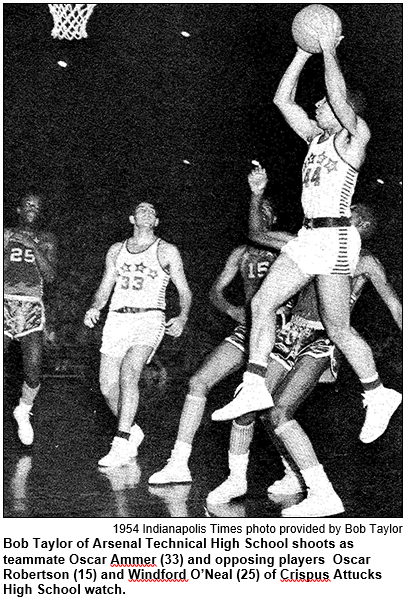 Our other guest grew up on the near-eastside and, in fall 1951, was among the small group of African-American students who attended Tech High School in the second year that school's student body was integrated. Bob Taylor became an outstanding basketball player at Tech but befriended - even though he played hoops against - many of the players on the legendary Attucks teams that won back-to-back state championships.
Our other guest grew up on the near-eastside and, in fall 1951, was among the small group of African-American students who attended Tech High School in the second year that school's student body was integrated. Bob Taylor became an outstanding basketball player at Tech but befriended - even though he played hoops against - many of the players on the legendary Attucks teams that won back-to-back state championships.
To share insights from their unusual perspectives of interacting extensively with the opposite race during an era in which much of the Hoosier capital was segregated, Dwight, now 74, and Bob, 78, are Nelson's studio guests.
Dwight, who eventually attended what was then the John Herron Art Institute, as well as Indiana University, became a writer, graphic designer and lyricist based in Cape Cod. He returned to his hometown in connection with the publication of his coming-of-age novel, Growin' Up White (Iron Press), which describes Indy as a "hotbed of bigotry" during the 1950s.
After graduating from Tech in the Class of '54 (which, with 740 students, was less than 5 percent black then), our guest Bob Taylor earned a degree in mechanical engineering from Purdue. He went on to a distinguished career as an engineer in the aerospace industry, followed by a 20-year career at Eli Lilly and Co. In 1990, he became the first African-American trustee at Purdue.
Growin' Up White describes several clashes between whites and blacks, ranging from the casual use of racial slurs to violent episodes in which popular students at Shortridge harassed black peers from Attucks. Although Dwight changed the names of most people and fictionalized some settings in his novel, he says many of the episodes are derived from incidents that occurred during his boyhood.
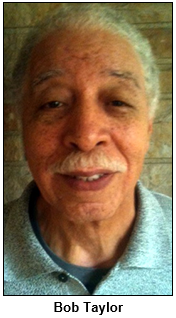 Names of several city landmarks and institutions - from Shortridge and Attucks to the long-gone Fox Burlesque Theater, the Golden Hill neighborhood and the former WFBM Radio - are sprinkled throughout the novel.
Names of several city landmarks and institutions - from Shortridge and Attucks to the long-gone Fox Burlesque Theater, the Golden Hill neighborhood and the former WFBM Radio - are sprinkled throughout the novel.
Like the book's protagonist, Dwight says he spent much time as a child and teen in black neighborhoods for several reasons.
His father was a doctor and civil rights activist who often came to the aid of black residents, including some injured in assaults by whites. And because his mother also worked (a classically trained pianist, she enjoyed a thriving career as a performer and teacher), young Dwight often was entrusted to the care of the family's African-American housekeeper. In her neighborhood, he developed friendships with black children and teens.
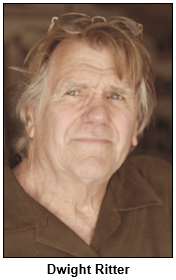 "I tried to 'hide' those friendships from my classmates at Shortridge," Dwight says. "Frankly, most of my Shortridge friends were racist."
"I tried to 'hide' those friendships from my classmates at Shortridge," Dwight says. "Frankly, most of my Shortridge friends were racist."
Our guest Bob Taylor attended an all-black elementary school because, he notes, in the 1940s Indianapolis Public Schools grade schools were not yet integrated. Even so, he interacted as a child with white peers because his family's home was in a "borderline" neighborhood near Brookside Park, where children of both races played - although, in Bob's recollection, seldom together.
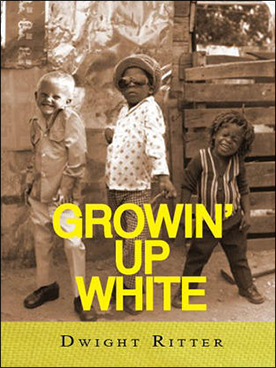 His oldest siblings attended Attucks, but Bob says he was given the choice of enrolling there or at Tech; he opted for the latter in part because of its proximity to his home.
His oldest siblings attended Attucks, but Bob says he was given the choice of enrolling there or at Tech; he opted for the latter in part because of its proximity to his home.
"For those of us who were basketball players, the (racial tension) wasn't too bad," he says. "We were excluded from the social life at Tech, which is why we went to parties with friends from Attucks and Shortridge."
The Tigers basketball teams at Attucks, led by future NBA star and Olympic gold medalist Oscar Robertson, became the first from an African-American high school in the country to win a state championship in any sport when they captured successive titles in 1955 and '56.
But Bob Taylor's team at Tech won the city championship in 1954, beating Attucks - even though several of the future state champion players were on that year's Attucks team.
Growin' Up White describes the range of reactions in Indy's white community to the ascendency of the Attucks teams.
Much of the novel, though, unfolds earlier in the 1950s, when the main character ages from 11 to 13; he poses disciplinary problems, which author Dwight Ritter says is a reflection of his own adolescence. His rebellious nature was another reason his parents entrusted much of his care to their beloved housekeeper, a strict disciplinarian.
After graduating from IU and marrying, Dwight left Indiana in 1964. As a lyricist, he has written music for the Sesame Street TV series; as a graphic designer and artist, he has done a vast range of work. He also produced and directed the PBS documentary Being Amish.
During his return visit to his hometown, Dwight has been teaching art to youth at Christamore House on the near-westside. After our show, he signed copies of Growin' Up White at Bookmamas in Irvington at 2 p.m. Saturday.
Learn more:
Roadtrip - You are There 1816: Indiana Joins the Nation
|
Guest Roadtripper Rachel Hill Panko, director of public relations at the Indiana Historical Society, recommends a visit to You Are There 1816: Indiana Joins the Nation at the Eugene and Marilyn Glick Indiana History Center in downtown Indianapolis.
Visitors are able to step through an image of the cover of the Indiana Historical Society's copy of the 1816 Indiana State Constitution projected on a very fine screen of mist. From there, visitors enter a room in Corydon where debates have been taking place between Hoosier delegates to the Constitutional Convention, and actors pull visitors into the conversation.
Discussion topics include the requirement of all young, able-bodied men to serve in a state militia, the creation of a state-supported system of education and the prohibition of establishment of private banks. The handwritten IHS copy of the original 1816 Constitution also is on display as you enter the exhibit.
Serving up Hoosier heritage food
|
(Oct. 24, 2015 - encore presentation) - Pork tenderloins and persimmon pudding are on the menu for this show.
So are sugar cream pie, beef Manhattan sandwiches, fried biscuits, apple butter and Van Camp's pork and beans.
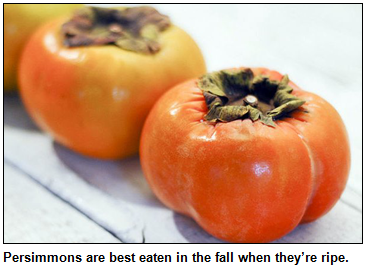 Also on the menu: the heritage of canning. It is intertwined with our Hoosier food history, thanks in no small part to the enterprising Ball brothers who came to Muncie in the 1880s.
Also on the menu: the heritage of canning. It is intertwined with our Hoosier food history, thanks in no small part to the enterprising Ball brothers who came to Muncie in the 1880s.
In this encore broadcast of one of the most popular shows in our Hoosier History Live archives (its original air date was Aug. 30, 2014), Nelson explores classic Hoosier foods - and topics related to the state’s traditional cuisine - with one of the state's best-known food journalists. Jolene Ketzenberger, the Indianapolis-based founder and editor of the local food website EatDrinkIndy, has covered the Hoosier culinary scene for more than 20 years.
Here's a taste of her take on the breaded pork tenderloin sandwich, which has been identified with Indiana for generations:
"I think it's clearly a cousin to the schnitzel, which seems reasonable, considering the German heritage of many Hoosiers."
During the show, Jolene and Nelson discuss Nick's Kitchen in Huntington, which claims to have invented the pork tenderloin sandwich. The restaurant's beginnings date to 1904, when founder Nick Frienstein began selling his wares from a street cart. 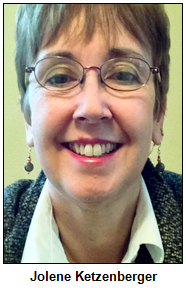 A few years later, Nick's brother started frying - and breading - pork cutlets to sell as sandwiches.
A few years later, Nick's brother started frying - and breading - pork cutlets to sell as sandwiches.
Some sandwiches served elsewhere have much more limited appeal, including one that Jolene calls a "southern Indiana classic": the brain sandwich.
Jolene, who enjoys shopping in farmers markets and trying new recipes, reports she felt compelled to make a brain sandwich so she could include it in her Cafe Indiana Cookbook (2010), which she co-authored with Joanne Raetz Stuttgen.Tune in to the show to savor the details about the brain sandwich.
During the show, Jolene also shares her research that indicates the Beef Manhattan sandwich may have originated in Indy.
Topics also include the national impact of Ball Corp.; its factory in Muncie was opened in 1888 by five Ball brothers, who achieved tremendous success, particularly with their famous Mason jars. The glass jars were used across the country for canning many homegrown products, including some, like tomatoes, that also have a long association with Indiana.
Here are Jolene's "Learn more" website picks:
- The Tenderloin Connoisseur - Rick Garrett's blog, which is devoted to the search for the perfect tenderloin sandwich.
- Hilltop Inn in Evansville - Home of the fried-brain sandwich.
- Beef Manhattan - A Hoosier original.
- Eat Drink Indy - Jolene's website covers the Indy food scene.
Persian/Iranian heritage in Indiana
|
(Oct. 17, 2015) - Iran has been in the headlines continually. So it is timely for our rotating series about the ethnic heritage of Indiana - which has explored a vast range from German, Irish and Scottish to Cuban, Colombian/Venezuelan and Russian immigration - to look at the Persian and Iranian heritage in the Hoosier state.
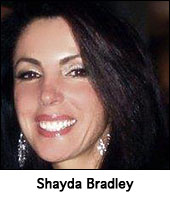 Nelson's studio guests include Cyrus Jafari, a Realtor and entrepreneur in Indianapolis who grew up in Iran and immigrated at age 24 in 2001. Cyrus, past president of the Society for the Preservation of Persian Culture, is the owner of Showcase Realty. He also owns the former Earth House (a historic structure that once housed the Lockerbie United Methodist Church) and eventually hopes to open a Persian coffeehouse there.
Nelson's studio guests include Cyrus Jafari, a Realtor and entrepreneur in Indianapolis who grew up in Iran and immigrated at age 24 in 2001. Cyrus, past president of the Society for the Preservation of Persian Culture, is the owner of Showcase Realty. He also owns the former Earth House (a historic structure that once housed the Lockerbie United Methodist Church) and eventually hopes to open a Persian coffeehouse there.
Nelson and Cyrus are joined by Shayda Bradley, the executive director of design and construction for IU Health. A native of Iran, she left the country at age 18 in 1978 following the overthrow of the shah. The assets of her family, which she described as "educated and middle class," were frozen. Like Cyrus, Shayda is a past president of the Society for the Preservation of Persian Culture.
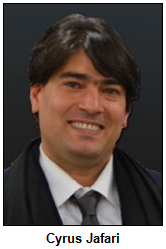 "Basically, people who have come from Iran are in one of two groups," Cyrus says. "The first group came before the revolution in 1977 and often were supporters of the shah. The newer group, people like me, grew up in Iran after that and never experienced what the country was like in the past."
"Basically, people who have come from Iran are in one of two groups," Cyrus says. "The first group came before the revolution in 1977 and often were supporters of the shah. The newer group, people like me, grew up in Iran after that and never experienced what the country was like in the past."
In addition to Cyrus and Shayda, our guests include Aline Swanson, international relocation specialist for the International Center. She describes various services offered by the center, as well as the challenges that typically confront immigrants, including Iranians. (A native of Brazil, Aline has become an American citizen.)
According to Peopling Indiana: The Ethnic Experience (Indiana Historical Society Press, 1996), few Iranians came to Indiana - or even to the United States - before 1900. During the last 50 years, though, many have come to study medicine, engineering and other fields at universities.
Although our guest Cyrus Jafari grew up in Iran, he was born in the United States because his father came to study electrical engineering.
During his youth in the historic Iranian city of Isfahan, Cyrus met his wife, Nasim. She immigrated several years after Cyrus and is a chef at the Eagle's Nest restaurant in downtown Indy.
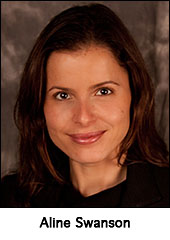 After leaving Iran, our guest Shayda Bradley eventually made her way to Purdue University. She earned degrees in engineering and construction technology and has lived in Indianapolis for more than 30 years. Before her current executive position with IU Health, Shayda and one of her sisters ran a boutique. Then they designed and marketed upscale, fashionable clothes for women.
After leaving Iran, our guest Shayda Bradley eventually made her way to Purdue University. She earned degrees in engineering and construction technology and has lived in Indianapolis for more than 30 years. Before her current executive position with IU Health, Shayda and one of her sisters ran a boutique. Then they designed and marketed upscale, fashionable clothes for women.
Because of the volatile relationship between Iran and the United States, Cyrus reports that some immigrants are reluctant to identify their heritage.
"If you are ashamed to be Iranian, you tend to call yourself Persian," he says.
Cyrus, who has dual citizenship, has been able to travel freely in and out of his homeland; he visited Iran last year.
Learn more:
- Columbia University, Center for Iranian Studies.
- Indianapolis, A City of Immigrants - by M. Teresa Baer, page 39, Indiana Historical Society.
- Statistics about Immigrants from Indianapolis - Immigrant Welcome Center.
- The Iranian Americans - PBS documentary.
Roadtrip - Valparaiso
Our Guest Roadtripper and public historian Glory-June Greiff tells us: "Valparaiso is an interesting city on the historic Lincoln Highway - both routes - in northern Indiana. That is, it's on the original 1913 route that ran through Goshen, Elkhart, South Bend and LaPorte, and also the straighter version rerouted in the 1920s that became (mostly) part of the original U.S. 30. 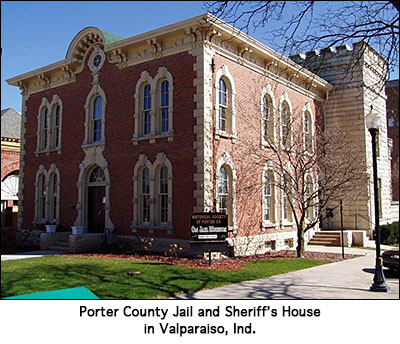 Tracking the above-ground archaeology remaining of this road is always a good excuse to head up that way!"
Tracking the above-ground archaeology remaining of this road is always a good excuse to head up that way!"
Valparaiso, which had become a bit sleepy, has really awakened in recent years. Its downtown, listed in the National Register of Historic Places, is buzzing with restaurants, coffee shops, art galleries and boutiques, many housed in cool historic buildings. I can recommend Bon Femme Cafe right on Lincolnway, which offers tasty food and an interesting atmosphere. Is your sweet tooth aching? The many cupcakes at Designer Desserts may soothe it! There are any number of other shops to explore as well."
Valparaiso is the seat of Porter County and boasts a historic courthouse with a checkered history. Built in 1885 (replacing an earlier brick structure on the same site), the current building suffered a severe fire in the 1930s that destroyed its tower. The courthouse was partly restored, forgoing its tower, so it remains a bit of an architectural oddity.
Immediately southeast of the courthouse is the Porter County Jail and Sheriff's House, built in 1860-1871, that today houses a museum and the Historical Society of Porter County, definitely worth checking out.
And the town is home to Valparaiso University, which boasts a wonderful collection of outdoor public sculpture on its campus.
History Mystery
A founding member of the International Center of Indianapolis is a well-known artist who was born in India. He was trained as an architect and came to the Hoosier capital during the 1960s to be a city planner for then-Mayor Richard Lugar.
 Eventually, he became a full-time artist who has won acclaim for his pen-and-ink drawings of landmarks including churches, monuments and memorials in Indiana, his homeland of India and elsewhere around the world. Although he was one of the first members of the Sikh faith (the world’s fifth largest religion) to settle in Indianapolis, the metro area now has several Sikh temples. The artist helped start the International Center in the early 1970s.
Eventually, he became a full-time artist who has won acclaim for his pen-and-ink drawings of landmarks including churches, monuments and memorials in Indiana, his homeland of India and elsewhere around the world. Although he was one of the first members of the Sikh faith (the world’s fifth largest religion) to settle in Indianapolis, the metro area now has several Sikh temples. The artist helped start the International Center in the early 1970s.
Question: Who is the well-known artist?
Hint: He has been a Hoosier History Live guest when we have explored the Sikh heritage in Indiana.
The prize pack includes a gift certificate to the Tin Roof in downtown Indy and two admissions to the Indianapolis Children's Museum, all courtesy of Visit Indy, and two passes to Glo Golf in the Circle Centre Mall in downtown Indianapolis, courtesy of Glo Golf.
Camp Chesterfield and Spiritualism history
|
(Oct. 10, 2015) - Just north of Anderson on the banks of the White River is a historic 34-acre enclave that has long been known as a "hub of Spiritualism."
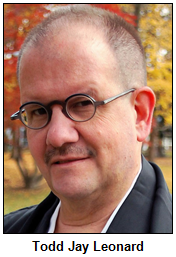 Camp Chesterfield, the home for more than 120 years of the Indiana Association of Spiritualists, consists of 65 buildings. They include historic cottages (such as cabins for mediums), two hotels, folk art shrines and the spacious Cathedral of the Woods.
Camp Chesterfield, the home for more than 120 years of the Indiana Association of Spiritualists, consists of 65 buildings. They include historic cottages (such as cabins for mediums), two hotels, folk art shrines and the spacious Cathedral of the Woods.
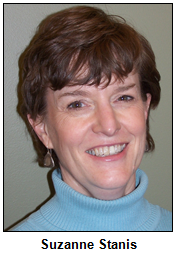 Spiritualism attracted a huge national following beginning in the mid-1800s; it grew particularly during eras of war - such as the Civil War, Spanish-American War and World War I - when, as the Indiana Preservationist puts it, "the bereaved sought communication with those they lost."
Spiritualism attracted a huge national following beginning in the mid-1800s; it grew particularly during eras of war - such as the Civil War, Spanish-American War and World War I - when, as the Indiana Preservationist puts it, "the bereaved sought communication with those they lost."
Indiana Landmarks has placed Camp Chesterfield on its "10 Most Endangered" list. That's because many of the camp's historic buildings, such as the Sunflower Hotel, built in 1914, stand vacant or, in the case of other structures, are underused.
Camp Chesterfield is listed on the National Register of Historic Places because of its significance as a spiritualist camp of the type that was widespread throughout the East and Midwest during the early 1900s.
To explore the history of Camp Chesterfield and of Spiritualism, which is defined in The Spirits of Lily Dale (Glade Press, 2010) as "the philosophy, science and religion of continuous life," Nelson is joined in studio by two guests:
- Rev. Todd Jay Leonard, an ordained Spiritualist minister and Camp Chesterfield's historian. Todd also is a university professor; he splits his time between Camp Chesterfield and Japan, where he teaches cross-cultural understanding and English.
- And Suzanne Stanis, Indiana Landmarks' director of heritage education and a board member of the Friends of Camp Chesterfield Foundation, a nonprofit formed to preserve and restore the historic camp.
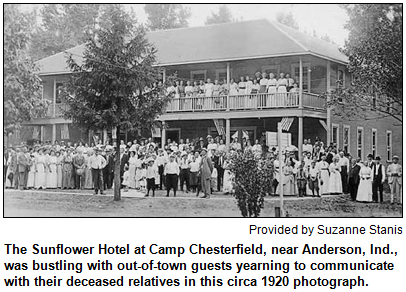 The camp includes a memorial dedicated to "the world's greatest religious leaders" that features limestone busts of Buddha, Jesus, Mohammed, Zeus and others. There also is a memorial to Native Americans, as well as "toad stools" - stone seating areas where mediums once gave outdoor readings.
The camp includes a memorial dedicated to "the world's greatest religious leaders" that features limestone busts of Buddha, Jesus, Mohammed, Zeus and others. There also is a memorial to Native Americans, as well as "toad stools" - stone seating areas where mediums once gave outdoor readings.
Seances have been conducted for generations at Camp Chesterfield. According to the Indiana Preservationist, Spiritualists believe it's possible to "communicate with the dead, especially with the aid of skilled mediums."
According to The Spirits of Lily Dale (the title refers to the center of the Spiritualist movement in western New York), many leaders of the anti-slavery, women's rights, temperance, prison reform and labor reform movements were involved in Spiritualism.
Camp Chesterfield began as a summer tent camp in the 1890s. In the beginning, according to Chesterfield Lives, a privately published history of the camp, visitors had to bring "their own camping equipment and hay for horses."
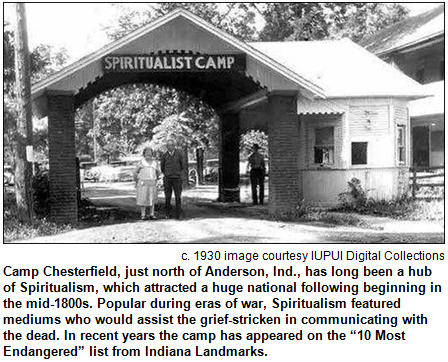 "Almost every town and area had a Spiritualist organization or group of people who gathered together for meetings," according to The Spirits of Lily Dale, referring to the late 19th and early 20th centuries. Sometimes thousands of people would gather at conventions and seasonal camp meetings.
"Almost every town and area had a Spiritualist organization or group of people who gathered together for meetings," according to The Spirits of Lily Dale, referring to the late 19th and early 20th centuries. Sometimes thousands of people would gather at conventions and seasonal camp meetings.
At Camp Chesterfield, a chapel in the woods serves as the setting for "message services" as well as weddings and funerals; in addition to the chapel, the spacious Cathedral of the Woods was built in 1954. Six years earlier, the Western Hotel opened to supplement the Sunflower Hotel.
"With a shrinking budget and congregation, the Indiana Association of Spiritualists struggles to maintain Camp Chesterfield," the Indiana Preservationist notes.
In addition to Camp Chesterfield, other historic sites on the "10 Most Endangered" list include the Indiana Medical History Museum and the once-lavish but long-deteriorating Rivoli Theater on the eastside of Indianapolis.
Learn more:
- A Brief History of Spiritualism in Indiana - Indiana Magazine of History.
- Camp Chesterfield - IUPUI Digital Collection.
- Photo gallery of Camp Chesterfield - Indiana Landmarks.
Roadtrip - Historic New Albany, Ind.
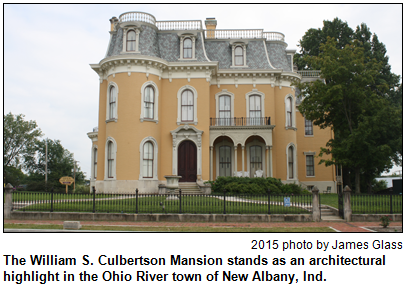 Our guest Roadtripper is the distinguished Dr. James Glass, principal of Historic Preservation & Heritage Consulting. Jim suggests a Roadtrip to New Albany in the southern part of Indiana along the Ohio River.
Our guest Roadtripper is the distinguished Dr. James Glass, principal of Historic Preservation & Heritage Consulting. Jim suggests a Roadtrip to New Albany in the southern part of Indiana along the Ohio River.
New Albany, he tells us, was the largest city in Indiana in 1850 with 8,181 people (Indianapolis had 8,012), and was also the second-largest city along the Ohio and Mississippi Rivers in the building of steamboats before the Civil War.
A few other quick facts:
- New Albany shipyards built 249 steamboats between 1817 and 1854.
- New Albany also was known for its plate glass (Washington DePauw ran one of the largest plate-glass factories in the United States) and fine wood veneers after 1865.
- Mansion Row along Main Street contains a superb collection of 19th-century mansions in a variety of architectural styles. The most impressive is the Culbertson Mansion, operated by the Indiana State Museum and State Historic Sites, a grand residence designed in the Second Empire Style.
- New Albany also was a center of the Underground Railroad, in which both freed African Americans and white citizens aided freedom-seeking enslaved people to cross the Ohio and find their way north to freedom. The Carnegie Center for Art and History contains exhibits on the Underground Railroad and contemporary art in the New Albany area.
- The Division Street School is a restored 1885 school in which African-American students were educated during the segregation era; visitors can experience the educational experience of the students.
- Jim also writes a monthly column about history for The Indianapolis Star; here is a link to his column New Albany's Rich History Shines Again.
History Mystery
Anderson, the city closest to Camp Chesterfield, was named after a Native American leader. Chief William Anderson was a widely admired leader of an Indian tribe that lived along the banks of the White River and in the woodland areas where such towns as Muncie, Noblesville and Anderson later were founded.
 In fact, the village of Anderson initially was known as Anderson Town in an even more specific reference to Chief William Anderson.
In fact, the village of Anderson initially was known as Anderson Town in an even more specific reference to Chief William Anderson.
In what has been described as a forced removal, the tribe left Indiana during the 1820s. Chief Anderson and the rest of the Native American tribe eventually ended up in Kansas.
Question: Name the tribe of Native Americans.
The prize pack includes a gift certificate to Iozzo's Garden of Italy in downtown Indy, courtesy of Visit Indy, two passes to Glo Golf in the Circle Centre Mall in downtown Indianapolis, courtesy of Glo Golf, and two tickets to the Indiana History Center featuring the new exhibit You Are There 1816: Indiana Joins the Nation, courtesy of the Indiana Historical Society.
Greensburg and Decatur County history
(Oct. 3, 2015) - Known far and wide as "the town with the tree growing out of its courthouse," Greensburg has a trove of other distinctions and folklore.
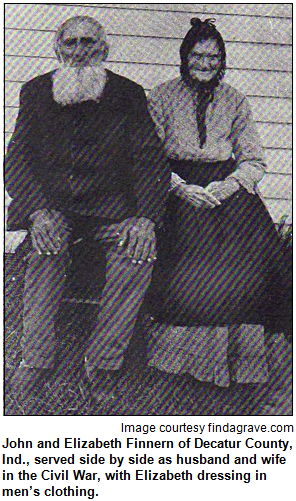 All of it is fodder as Hoosier History Live explores the heritage of Decatur County and Greensburg during a show in our rotating series about the heritage of Indiana towns and counties.
All of it is fodder as Hoosier History Live explores the heritage of Decatur County and Greensburg during a show in our rotating series about the heritage of Indiana towns and counties.
The Decatur County Courthouse was built in the 1850s. According to Magnificent 92 (IU Press, 1991), a visual history book about the state's courthouses, the first reports of a tree atop the 115-foot clock tower date to the early 1870s. No wonder Greensburg is nicknamed "Tree City."
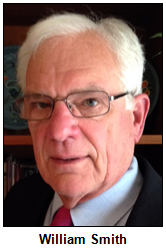 Fasten your seat belts, though, for aspects of the town's heritage that may surprise you, including its claim to fame as the birthplace in 1874 of flamboyant Carl Fisher, founder of the Indianapolis Motor Speedway.
Fasten your seat belts, though, for aspects of the town's heritage that may surprise you, including its claim to fame as the birthplace in 1874 of flamboyant Carl Fisher, founder of the Indianapolis Motor Speedway.
Greensburg, which is located about 45 miles southeast of Indianapolis, also was a stop on the fabled Chautauqua circuit that brought top cultural, artistic and political figures to towns across the country during the early 1900s. Chautauqua visitors to Greencastle included Helen Keller, John Phillips Sousa and William Jennings Bryan.
In recent years, one of Nelson's guests, John Pratt, a widely acclaimed history teacher at Greensburg High School, has been recreating the town's Chautauqua heritage. With his students, John puts together modern, semi-annual Chautauqua events featuring national and state public figures. Some of them (like Lech Walesa of Poland) have participated by Skype, while others have come to Greensburg. His next Chautauqua will be Nov. 5.
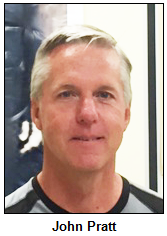 Nelson's guests also include William Smith, an attorney and former Decatur County prosecutor who has researched the county's Underground Railroad heritage. He is a board member of the Indiana Freedom Trails Association.
Nelson's guests also include William Smith, an attorney and former Decatur County prosecutor who has researched the county's Underground Railroad heritage. He is a board member of the Indiana Freedom Trails Association.
During the Civil War, Greensburg resident Elizabeth Finnern accomplished a distinction as unusual as a courthouse tree. Determined to fight for the Union cause alongside her husband, she cross-dressed as a soldier. Mrs. Finnern served in the military for about one year until her secret was discovered. Even after that, she remained with her husband's unit as a nurse. Our guests plan to share details.
Our guest John Pratt was born Jan. 2, 1963, making him the first baby born in Decatur County that year; he went on to graduate from Greensburg High. 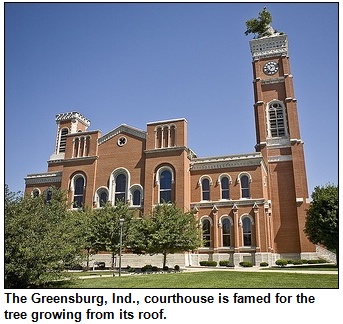 (In college, he wrote his first major paper about his hometown's best-known distinction; the paper was titled A Tree Grows in Greensburg.) Before his current job on the faculty at his alma mater, John taught at North Decatur High School for five years.
(In college, he wrote his first major paper about his hometown's best-known distinction; the paper was titled A Tree Grows in Greensburg.) Before his current job on the faculty at his alma mater, John taught at North Decatur High School for five years.
A few years ago, John and his students re-enacted a speech in 1968 by Bobby Kennedy in Decatur County; during our show, he will share insights about that event. (Also during his 1968 campaign for the Democratic presidential nomination, Bobby Kennedy made a historic speech in Indianapolis on the night that Rev. Martin Luther King Jr.was assassinated. The impact of that speech was the focus of a Hoosier History Live show in August.)
Regarding the Underground Railroad heritage, several accounts note that African-American families had moved into Decatur County by the 1840s. They became involved in local efforts to help fugitive slaves travel through Indiana en route to Canada.
And the courthouse tree? Since the 1870s, it has been considered a freak of nature. The current tree in the courthouse is at least the 13th.
Learn more:
- Chautauqua, Greensburg, Ind.
- DNR, Underground Railroad History in Decatur County.
- Hoosier History Live show audio about Carl Fisher, Greensburg native, with guest Glory-June Greiff.
- Decatur County Brick Houses, then/now - by Connie Zeigler.
Roadtrip - Historic eateries in Fort Wayne
"This week's Roadtrip is something a little different," says guest Roadtripper and film historian Eric Grayson. "You like history and you like eating on the road? Well, Fort Wayne is loaded with great historic eateries. A lot of people consider Fort Wayne as one of our premiere 'foodie towns,' so we're going to do a moveable feast this week."
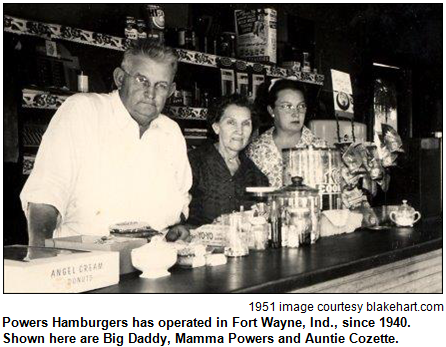 For breakfast, Eric recommends Cindy's Diner. It's small but with some great food, and it's a historic diner built in 1952. They're famous for their "Garbage," which is a blend of eggs, ham and potatoes.
For breakfast, Eric recommends Cindy's Diner. It's small but with some great food, and it's a historic diner built in 1952. They're famous for their "Garbage," which is a blend of eggs, ham and potatoes.
With a full belly, and being downtown in Fort Wayne, you can find plenty of historic buildings, from the restored courthouse to the Lincoln National Bank Building (which has a little snack bar inside, if it's open), and then you should be ready for lunch.
Eric continues: "I recommend Powers Hamburgers, which has been around since 1940. People confuse it with White Castle, because the buildings look similar, although the food is quite different. The burgers are grilled to order, with the most fragrant grilled onions, and guaranteed to clear your sinuses. Try the chili, too. Great old art deco building alone on a corner, hasn't changed in years."
After lunch, see if you can get in to tour the Embassy, which is one of Eric's favorite historic theaters, and don't miss the art museum.
For dinner, says Eric, you have to go to Coney Island, not to be confused with the one in New York. This is the kind of place you would normally find in New York, but it has been in Fort Wayne since 1914 and owned by the same family since 1916.
"The staple item here is the Coney Hot Dog, which is great," Eric says. "The baked beans are excellent, too, from a family recipe."
By the way, our Roadtripper also runs the popular Vintage Movie Night at Garfield Park Arts Center in Indianapolis. Coming up Saturday, Oct. 17, at 8 p.m. is the 1931 film Frankenstein.History Mystery
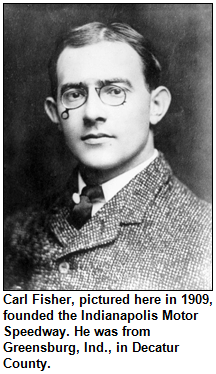 Greensburg native Carl Fisher, the founder of the Indianapolis Motor Speedway, always was driven to top himself. When the inaugural Indianapolis 500 in 1911 turned out to be a success - as did the race in subsequent years - Fisher decided to create a tourist resort far from Indiana.
Greensburg native Carl Fisher, the founder of the Indianapolis Motor Speedway, always was driven to top himself. When the inaugural Indianapolis 500 in 1911 turned out to be a success - as did the race in subsequent years - Fisher decided to create a tourist resort far from Indiana.
He developed swampland in the South into what he promoted as "the most beautiful little city in the world." Many critics were skeptical, but the resort city, like the Indianapolis 500, became a rousing success. Carl Fisher is still hailed as the "father" of the resort city, even though, for various reasons, he had lost much of his fortune by the time he died in 1939.
Question: What is the resort city that Carl Fisher founded?
The prize pack includes four tickets to the Indianapolis Scottish Highland Games on Oct. 10 in German Park in Greenwood, courtesy of Scottish Society of Indianapolis, two tickets to the Indiana History Center featuring the new exhibit You Are There 1816: Indiana Joins the Nation, courtesy of the Indiana Historical Society.
Mormon heritage in Indiana
|
(Sept. 26, 2015) - With the recent opening of the first Mormon temple in Indiana, we will explore the heritage of the faith in the Hoosier state. During our more than seven years on the air, Hoosier History Live has explored the heritage of Methodists, Amish, Quakers, Jews and even Sikhs.
Thousands of people attended ceremonies in August for the dedication in Carmel of the temple for Mormons, who are members of the Church of Jesus Christ of Latter-day Saints. Before the opening of the 34,000-square-foot building, the closest temples (the most sacred space of the Mormon faith) were in Chicago, Louisville and Columbus, Ohio.
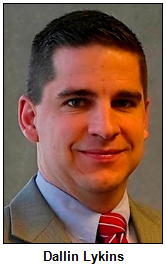 But there has been a Mormon presence in Indiana stretching back even before the 1840s. To share insights about the evolving heritage, Nelson is joined in studio by three guests:
But there has been a Mormon presence in Indiana stretching back even before the 1840s. To share insights about the evolving heritage, Nelson is joined in studio by three guests:
- Rick Hightower, a media relations specialist who is well-known for his former stints as an anchor/reporter at WISH-TV and WRTV 6. An Indianapolis native, Rick, 56, was a member of Washington High School's Class of 1977; he recalls being the only Mormon at the school then.
- Dallin Lykins, 34, an attorney for Lewis & Kappes in Indianapolis. A native of Columbus, Ind., Dallin has served as a full-time Mormon missionary in Costa Rica and today is a bishop, which is a lay leader of a Mormon congregation. He reports that his great-grandfather, grandfather, father and brother have served in similar capacities.
- And Ruth Ellen Homer, a sixth-generation Mormon who has extensively researched a range of aspects of religious history. The mother of five and grandmother of nine, Ruth Ellen has been active in helping start the new temple. Like Rick and Dallin, she is a graduate of Brigham Young University.
According to various news accounts, Indiana today ranks 26th among the states in Mormon population.
There are about 42,000 Mormons in the state today, with more than 3,600 in the Indianapolis area, according to reports when the temple opened. It is located at 116th Street and Spring Mill Road in Carmel.
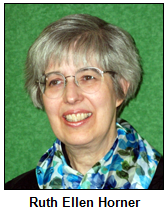 For many generations, though, Mormons across Indiana have worshipped in chapels, and congregations will continue to do so. In central Indiana, Latter-day Saints chapels can be found in Cumberland, Brownsburg, Plainfield, Fishers and other communities.
For many generations, though, Mormons across Indiana have worshipped in chapels, and congregations will continue to do so. In central Indiana, Latter-day Saints chapels can be found in Cumberland, Brownsburg, Plainfield, Fishers and other communities.
According to our guest Ruth Ellen Homer, Mormon founder Joseph Smith (1805-1844) spent some time in Indiana. In 1834, he led a group of Mormon men through the state on the National Road as they traveled west. They entered the state at Richmond, passed through Indianapolis, camped near an intersection of the National Road (today's U.S. 40) near Plainfield, and they crossed the Wabash River at Clinton.
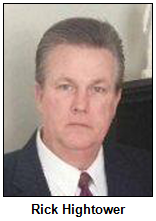 Ruth Ellen Homer, who was born in Salt Lake City, represents the Mormon church on the board of the Center for Interfaith Cooperation. She has lived in Indiana since 1972. During our show, she shares insights about the church's outreach programs, including humanitarian relief.
Ruth Ellen Homer, who was born in Salt Lake City, represents the Mormon church on the board of the Center for Interfaith Cooperation. She has lived in Indiana since 1972. During our show, she shares insights about the church's outreach programs, including humanitarian relief.
Our guest Rick Hightower served as a missionary in the Philippines and today is a high priest, an office in the church's lay priesthood. In addition to his previous work for TV stations, he also was a spokesman for the former ATA Airlines.
Our guest Dallin Lykins is a fluent Spanish-speaker whose specialties as an attorney include immigration law. He has ancestral ties to early Mormon families in the Columbus area.
According to an article in The Indianapolis Star, when plans for the temple were announced in 2011, the number of Mormons in the state has increased by at least 50 percent since 1990.
"There are about the same number of Mormons in Indiana as there are Jews," the Star article noted. "There are more Mormons here than Muslims, Buddhists and Hindus."
High-profile Mormons with Indiana connections include Austin Collie, the former wide receiver for the Indianapolis Colts.
Learn more:
- Big Crowds Expected for New Temple in Carmel - Indianapolis Business Journal
- Rare Look Inside a Mormon Temple - Indianapolis Star
- Family Search, free online genealogy website operated by LDS.
- Uncle Dale's Readings in Early Mormon History.
Roadtrip - 'Repurposed' Fort Benjamin Harrison in Indianapolis
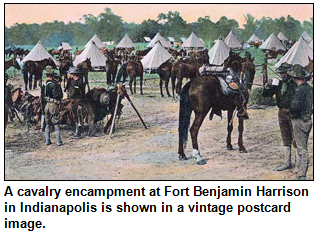 Guest Roadtripper Charles Braun, longtime central Indiana attorney and host of WICR's Legally Speaking radio show on Saturdays from 11 to 11:30 a.m., encourages us to visit Fort Harrison State Park on the northeast side of Indianapolis.
Guest Roadtripper Charles Braun, longtime central Indiana attorney and host of WICR's Legally Speaking radio show on Saturdays from 11 to 11:30 a.m., encourages us to visit Fort Harrison State Park on the northeast side of Indianapolis.
Fort Harrison was opened as a military base in 1906 and was named in honor of President Benjamin Harrison, Indiana's only U.S. president. The fort was a major military base during both World War I and World War II, and used for housing during the 1987 Pan Am Games.
Fort Harrison was decommissioned as a military base in 1991 and the site was thoughtfully converted to Fort Harrison State Park. The park features a former Citizens Military Training Camp, Civilian Conservation Corps camp, and a World War II prisoner-of-war camp.
There also are picnicking and walking and jogging trails with hilly terrains and spectacular views of Fall Creek. Old officers' quarters have been converted into an inn for guests, and dining facilities include the Garrison Restaurant and Cafe Aubrey. Adjacent is the beautiful 18-hole Fort Golf Course, designed by Pete Dye and one of the most challenging courses in the state.
History Mystery
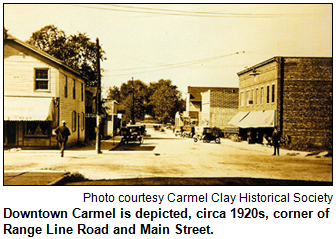 In addition to being the site of the state's first Mormon temple, which was dedicated in August, Carmel has deep connections to other faith traditions. The town was formed in 1837 by early setters, many of whom were members of a specific religious movement.
In addition to being the site of the state's first Mormon temple, which was dedicated in August, Carmel has deep connections to other faith traditions. The town was formed in 1837 by early setters, many of whom were members of a specific religious movement.
These families settled in the rural Hamilton County area that became Carmel following a significant migration to Indiana from North Carolina of members of the faith group.
Question: What is the faith tradition?
The prize pack includes two tickets to the Indianapolis Scottish Highland Games on Oct. 10 in German Park in Greenwood, courtesy of Scottish Society of Indianapolis, two tickets to the Indiana State Museum, courtesy of the Indiana State Museum, and a Family 4-Pack to Conner Prairie, including the 1859 Balloon Voyage, courtesy of Conner Prairie.
Lenape (Delaware) Indian heritage in Indiana
(Sept. 19, 2015 - encore presentation) - "I think in Indiana, as in many places, it's only been in the last 30 to 40 years that we've chosen to look outside of myth ... to truly understand the first peoples who lived in our state."
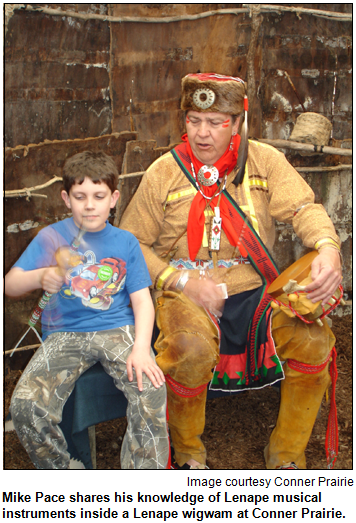 That comment from a historian introduces a documentary about the Lenape tribe of Native Americans. It's the tribe that was known as the Delaware Indians by white settlers. Watch the half-hour documentary here.
That comment from a historian introduces a documentary about the Lenape tribe of Native Americans. It's the tribe that was known as the Delaware Indians by white settlers. Watch the half-hour documentary here.
The Lenape lived in the woodlands of east central Indiana from the 1790s into the early 1820s; during that time, they founded villages or trading posts that evolved into towns, including Anderson, Muncie and Strawtown.
Under the terms of the Treaty of St. Mary's negotiated in 1818, the Lenape gave up their claims to Hoosier soil and, as part of what has been called a "forced migration," moved a few years later to Kansas.
Eventually, the Lenape were moved again, this time to Oklahoma, the tribe's home state in modern times.
Considering that the Lenape had lived in New York, New Jersey, Pennsylvania and Delaware for generations even before being relocated to the Indiana Territory, is it any wonder that one expert in the documentary calls them "possibly the most moved group in American history"?
In this encore broadcast of one of the most popular shows in our Hoosier History Live archives (its original air date was Aug. 16, 2014), Nelson is joined in studio by two guests who share insights about the Lenape tribe's life on Hoosier soil and impact here. The guests are:
- Chris Flook, a Ball State Universitytelecommunications instructor who is one of the executive producers of the documentary, titled The Lenape on the Wapahani River. It has been shown on PBS TV stations in Muncie, in Oklahoma and elsewhere across the country.
- Mike Pace, a descendant of the Lenape who once lived in Indiana; he helped create the Lenape village at Conner Prairie Interactive History Park.
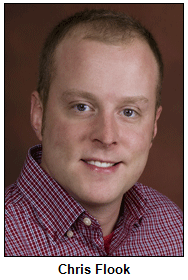 For several months of the year, Mike lives in Bartlesville, Okla., but he spends summers at Conner Prairie, where he is an interpreter specialist. Mike is among the experts interviewed on-camera in The Lenape on the Wapahani River.
For several months of the year, Mike lives in Bartlesville, Okla., but he spends summers at Conner Prairie, where he is an interpreter specialist. Mike is among the experts interviewed on-camera in The Lenape on the Wapahani River.
In the early 1800s, Lenape leaders in Indiana included Chief William Anderson, for whom the largest city in Madison County is named. The Lenape who moved to Kansas included Anderson's daughter, Mekinges, who became the first wife of frontier entrepreneur and fur trader William Conner, namesake of Conner Prairie. They had six children, all of whom moved with their mother to Kansas. Conner remained in Indiana, remarried (a white woman) and had more children with his second wife.
Our guest Mike Pace, a former assistant chief of the Delaware Tribe, has spoken across the country - and even overseas - about aspects of Native American heritage.
Learn more:
- The Unami Language.
- Indiana Magazine of History, Moravian Mission on the White River.
- Miller, J. (1994). The 1806 purge among the Indiana Delaware: sorcery, gender, boundaries, and legitimacy. Ethnohistory, 245-266.
- Ghosts of the Delaware - Beth McCord.
- In Search of the Delaware Lenape, Jessica Yann.
- Conner Prairie, Native Americans in Indiana.
Wendell Willkie, unlikely presidential candidate of 1940
|
(Sept. 12, 2015) - In a recent article in The New York Times headlined "Before Trump or Fiorina, There Was Wendell Willkie," esteemed presidential historian Michael Beschloss wrote:
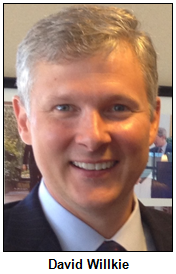 "If either Donald Trump or Carly Fiorina receives the 2016 Republican presidential nomination, it will be a rare achievement. Only once in American history has a major political party granted its prize to someone whose principal qualification was to have served as a chief executive."
"If either Donald Trump or Carly Fiorina receives the 2016 Republican presidential nomination, it will be a rare achievement. Only once in American history has a major political party granted its prize to someone whose principal qualification was to have served as a chief executive."
That "someone" was a colorful Hoosier. Elwood native Wendell Willkie, whose rollicking presidential crusade was headquartered in Rushville, was a maverick Republican in 1940 when he took on Franklin D. Roosevelt in his quest for a third term.
Last month, commemorative events celebrated the 75th anniversary of an August 1940 rally in Elwood for Willkie that drew a crowd of 215,000. That makes it the largest political gathering in Indiana history. By the time Willkie wound down on the sweltering, 102-degree afternoon, nearly 360 people needed to be treated for heat-related disorders.
Amid the anniversary and the presidential nomination season underway, David Willkie is Nelson's studio guest to share insights about his grandfather, who died suddenly of heart disease in 1944 at age 52.
David, who grew up in Rushville and has worked as a staff member for former U.S. Sen. Richard Lugar, is in his 40s and never personally knew his grandfather. He has fond memories, though, of his grandmother, Edith Willkie, who almost became the nation's first lady.
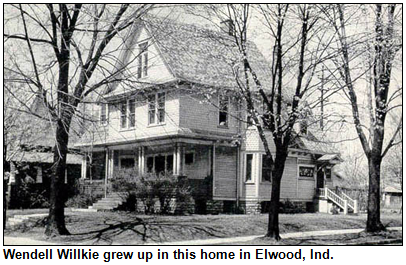 Wendell Willkie, a utility company executive and attorney who never had held elective office of any kind, was the dark horse nominee of the Republican Party. The chant "We want Willkie! We want Willkie! We want Willkie!" swept delegates to the GOP national convention in Philadelphia, which had been deadlocked on more traditional candidates. Willkie won on the sixth ballot.
Wendell Willkie, a utility company executive and attorney who never had held elective office of any kind, was the dark horse nominee of the Republican Party. The chant "We want Willkie! We want Willkie! We want Willkie!" swept delegates to the GOP national convention in Philadelphia, which had been deadlocked on more traditional candidates. Willkie won on the sixth ballot.
Although Willkie lost in the general election, President Roosevelt eventually designated the Hoosier to be his personal representative to the Allied nations in Europe. Regarded as socially progressive, a champion of civil rights and an internationalist, Willkie also became the author of a bestselling book titled One World.
A note about that historic speech in Elwood: According to David Willkie, family folklore is that his grandfather inadvertently forgot his speech when he arrived at the massive rally, which jammed roads for miles far beyond Madison County. So squad cars had to be dispatched to weave among the bumper-to-bumper traffic and fetch the speech.
David shared that anecdote when he was our guest for a show in 2012. Much of that program, though, focused on an unrelated event: The 20th anniversary of David Willkie's highly publicized fund-raising stunt in 1992 to save the Athenaeum in downtown Indy. 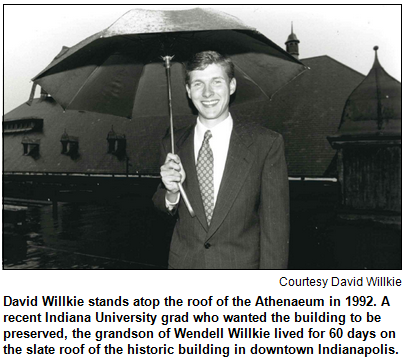 (David camped on the slate roof of the historic structure for 60 days.)
(David camped on the slate roof of the historic structure for 60 days.)
For this show, the full focus will be on his grandfather, who took Indiana - and the entire country - on an unforgettable ride 75 years ago.
Born in 1892, Lewis Wendell Willkie was the son of two attorneys. (His mother, Henrietta Willkie, is considered to have been among the first women admitted to the Indiana bar.) When the family's finances declined with the end of the natural gas boom in east central Indiana, Wendell held down a series of jobs. They included working as a short-order cook and driving a bakery wagon.
At Indiana University, where Willkie was a member of the Class of 1913, he met his lifelong rival, future Indiana Gov. Paul McNutt, a Democrat. (If FDR had not sought a third term, McNutt was considered a likely Democratic presidential nominee - meaning the 1940 race for the White House could have been a battle between two Hoosiers.)
Eventually, Willkie became a prosperous attorney, then one of the country's top utility executives. He tangled with FDR over the government's new Tennessee Valley Authority, which Willkie regarded as competing with his electric company's holdings in Tennessee.
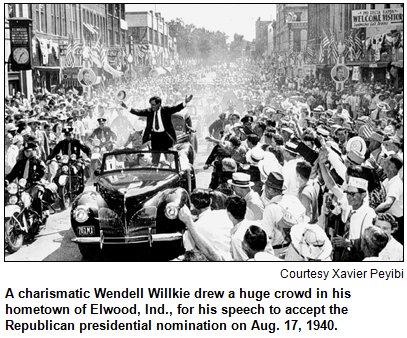 During the 1940 presidential campaign, Willkie made a show of turning down the support of religious and social leaders whom he considered bigots.
During the 1940 presidential campaign, Willkie made a show of turning down the support of religious and social leaders whom he considered bigots.
"I don't have to be president of the United States," he said, "but I do have to live with myself."
His grandson, our guest David Willkie, was an economic adviser to the U.S. Senate's Foreign Relations Committee when he was on Lugar's staff. Before that, he was a business industry expert for the TV show 60 Minutes.
Learn more:
- Video of Wendell Willkie 1940 campaign speech.
- Tim Walker, usfamily.net.
- Michael Beschloss, New York Times.
- C-SPAN, Wendell Willkie, Presidential Contender.
- Madison County Historical Society.
- American Presidency Project: Transcript.
- Bio from the Indiana Historical Society.
Roadtrip - New butterfly garden in Marion
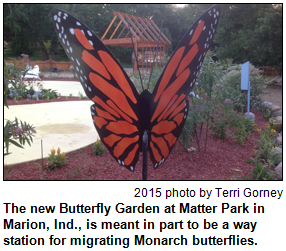 Guest Roadtripper and volunteer naturalist Terri Gorney of Fort Wayne suggests the new Butterfly Garden at Matter Park in Marion in Grant County as a place to take a relaxing walking trail along the Mississinewa River.
Guest Roadtripper and volunteer naturalist Terri Gorney of Fort Wayne suggests the new Butterfly Garden at Matter Park in Marion in Grant County as a place to take a relaxing walking trail along the Mississinewa River.
The new butterfly garden was created by the Marion Garden Club and the Marion Parks Department. It is intended in part to be a way station for Monarchs as they migrate across America. Monarchs do have very interesting lives; perhaps Terri will tell us more!
While in Marion, don't forget to visit the Quilter's Hall of Fame, the home of renowned quilter Marie Daughtery Webster, whose granddaughter bought the home when it was condemned in 1993 and donated it to the Quilters Hall of Fame as its permanent home.
Also stop by the Hostess House, which was designed by African-American architect Samuel Plato. Marion is about halfway between Indianapolis and Fort Wayne.
History Mystery
|
During his 1940 presidential campaign, Wendell Willkie delivered a rousing speech from the balcony of a landmark building in downtown Indianapolis. Among the thousands of Hoosiers who gathered on Monument Circle to hear Willkie's speech was 8-year-old Richard Lugar. The future U.S. senator has said that he was inspired by Willkie and in awe of the majestic building with the balcony.
By the end of the 1940s, though, the landmark building had been demolished. Constructed in phases in during the late 1880s, the ornate building included a hotel and a theater with the largest stage in the city. Famous actors and singers often waved to the public from the exterior balcony where Willkie spoke in 1940.
Question: Name the bygone building.
The prize pack includes a gift certificate to Brics ice cream station in Broad Ripple, and two and two tickets to the NCAA Hall of Champions, courtesy of Visit Indy, as well as two tickets to the Indiana State Museum, courtesy of the Indiana State Museum.
Bicentennial projects across Indiana, both upcoming and completed
|
(Sept. 5, 2015) - In Spencer County, where young Abe Lincoln and his family moved in 1816, Boy Scouts have been collecting seeds descended from squash apparently grown by the Lincolns. Local residents are planning to plant and harvest the squash with a link to the "Great Emancipator."
In Crawfordsville, the tower on the Montgomery County Courthouse was struck by lightning in 1941; its bell was donated to the World War II effort. A new courthouse bell has been obtained and will be installed in the tower, which is being restored.
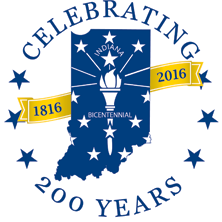 And in Centerville, a creative project involving a nature park will unfold at the Cope Environmental Center.
And in Centerville, a creative project involving a nature park will unfold at the Cope Environmental Center.
They are among the dozens of projects planned for next year in counties and towns when Indiana celebrates its 200th birthday. To share details about what to expect, Perry Hammock, executive director of the Indiana Bicentennial Commission, is Nelson's studio guest.
He also shares insights about projects that already have occurred in counties and towns that were organized before Indiana achieved statehood - and, as a result, have already had local bicentennial celebrations.
In historic Orleans in southwestern Indiana, for example, the town's original fire truck- with wooden wheels and its original engine (circa 1924) - was restored by local firefighters.
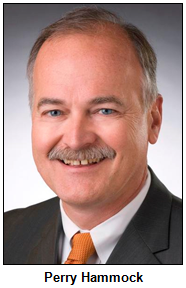 Perry and Nelson primarily focus on local, grassroots projects involved with the Bicentennial, rather than the major state projects. The 2016 Bicentennial Celebration includes the construction of a $25 million building for the Indiana State Archives (Hoosier History Live explored the archives - and the dismal condition of the current facility - in a radio show on May 16) and the creation of a Bicentennial Plaza at the Indiana Statehouse.
Perry and Nelson primarily focus on local, grassroots projects involved with the Bicentennial, rather than the major state projects. The 2016 Bicentennial Celebration includes the construction of a $25 million building for the Indiana State Archives (Hoosier History Live explored the archives - and the dismal condition of the current facility - in a radio show on May 16) and the creation of a Bicentennial Plaza at the Indiana Statehouse.
The $55 million allocated by the state for the Bicentennial also includes the cost of a torch relay to all 92 counties.
Last month, the Bicentennial Commission chose a design for the commemorative medal of the 200th birthday. The winning design, selected from submissions by 60 artists, features a page being turned in Indiana history, with representations of the Civil War, farming and medical research. The design was created by Donna Weaver, an artist in Switzerland County; the commemorative medal with her design is expected to be available to the public in November, according to the Associated Press.
In December 1816, the same month that Indiana became the 19th state, seven-year-old Abe Lincoln moved with his family from Kentucky to southwestern Indiana.
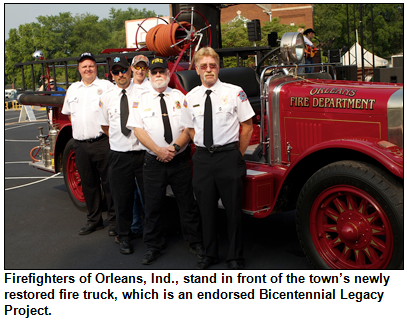 How, though, do the local folks know that the squash seeds truly are descended from those grown by the Lincolns? That's among the questions Nelson asks Perry Hammock, whose commission has endorsed nearly 500 Bicentennial projects and events.
How, though, do the local folks know that the squash seeds truly are descended from those grown by the Lincolns? That's among the questions Nelson asks Perry Hammock, whose commission has endorsed nearly 500 Bicentennial projects and events.
The Lincoln Boyhood National Museum is coordinating the squash project and has been distributing seeds. Their goal is to have every Spencer County and Perry County garden "growing the 'Lincoln squash' in 2016"; that year's harvest will feature contests recognizing the largest squash, best pie and other accomplishments.
Other Bicentennial projects include, in White County, the creation of a statue of the county's namesake, Isaac White, a soldier who was killed in the Battle of Tippecanoe in 1811. The statue will be erected on the courthouse lawn in Monticello.
Our guest Perry Hammock became director of the Indiana Bicentennial Commission in March 2014. Before that, he spent 33 years on the staff of Ivy Tech Community College.
His predecessor at the Bicentennial Commission, former executive director Chris Jensen, joined Nelson and distinguished historian James Madison, a Bicentennial Commission board member, for a show in June 2013 that explored the Centennial in 1916, including the challenges then, as well as the celebrations.
Learn more:
- Hoosier History Live - Centennial in 1916, bicentennial in 2016.
- Hoosier History Live - What's in our State Archives?
- Hoosier History Live - Abe Lincoln's parents: Thomas, Nancy Hanks and stepmom Sarah.
Roadtrip - Simple delights await in Starke County in northern Indiana
Guest Roadtripper and public historian Glory-June Greiff tells us to "head on up U.S. 35 out of Logansport - a road largely developed and routed by the Works Progress Administration (WPA) in the 1930s, by the way - to Starke County, where many simple delights await you.
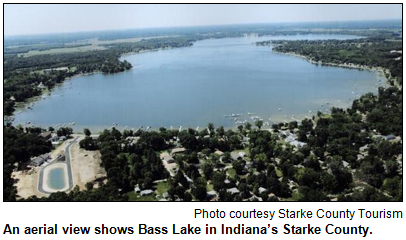 The hamlet of Bass Lake, on the southwestern corner of one of Indiana's largest natural lakes, is just off 35; it boasts one of the state's few remaining drive-in theaters, the Melody. (Interestingly, during Christmas season, it is the site of a living Nativity put on by a local church.) Try to make it before winter (they are closed then) so you can stop at Fingerhut's Bakery, located in what was once a bank building. Great doughnuts, but good food, too. Bass Lake once was a state park - or technically, a state beach - that was deaccessioned some years ago and is now run by the county.
The hamlet of Bass Lake, on the southwestern corner of one of Indiana's largest natural lakes, is just off 35; it boasts one of the state's few remaining drive-in theaters, the Melody. (Interestingly, during Christmas season, it is the site of a living Nativity put on by a local church.) Try to make it before winter (they are closed then) so you can stop at Fingerhut's Bakery, located in what was once a bank building. Great doughnuts, but good food, too. Bass Lake once was a state park - or technically, a state beach - that was deaccessioned some years ago and is now run by the county.
If you miss Fingerhut's at Bass Lake, do not despair, for their mother location is only a few miles to the west (take SR10) in North Judson, and that one is open year-round. North Judson is home to the annual Mint Festival on Father's Day weekend, celebrating the crop ubiquitous to that area, although mint farming is not as widespread as it once was. (Indiana is still among the top 10 producers of mint, though!)
Did we mention the WPA? Right in the middle of town is Norwayne Field, today a park but built as a baseball field in a natural depression with bleachers up the sides. Note the unusual concrete track along the side of the bleachers; it was intended as a snow slide in winter for sledders. North Judson also boasts the Hoosier Valley Railroad Museum, which on Saturdays offers train rides.
Before heading home, you might want to head up Ind. 39 a few miles and turn east to Toto, an odd little place that must be seen to be appreciated. The tiny town in the middle of nowhere is old, but it attracts thousands of people each year to its huge discount stores and odd shops. There's a great little grocery store that in spring stocks a huge array of wonderful plants, and places to eat as well.
Continue east on the county road and you'll soon find yourself back on Highway 35.
History Mystery
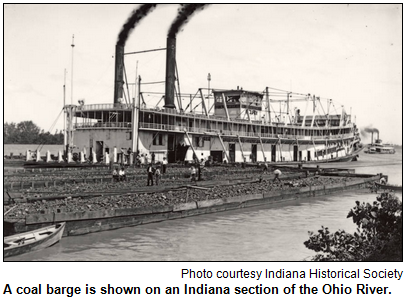 One of Indiana's first counties to be organized celebrated its bicentennial in 2013. Located in far-southwestern Indiana, the country was organized in 1813.
One of Indiana's first counties to be organized celebrated its bicentennial in 2013. Located in far-southwestern Indiana, the country was organized in 1813.
Its county seat is a town to which a teenage Abe Lincoln walked so he could sit in courtrooms and observe cases argued by a local lawyer, who mentored him. (The bicentennial county is located next to Spencer County, where the Lincoln family lived.)
Another town in the county is known for its historic Main Street and scenic, "river village" ambience; the town is nestled on the Ohio River. Some of the county is considered to be part of the metro area of Evansville, which is located in another bordering county, Vanderburgh County.
Question: Name the far-southwestern county that celebrated its bicentennial in 2013.
Hint: It often is listed among the 10 fastest-growing counties in the state.
The prize pack includes two tickets to the Hoosier Hops & Harvest Festival at Story Inn in Brown County on Sept. 12, courtesy of Story Inn, as well as two tickets to the Indianapolis Children's Museum, courtesy of Visit Indy.
Impact of Bobby Kennedy's speech in 1968
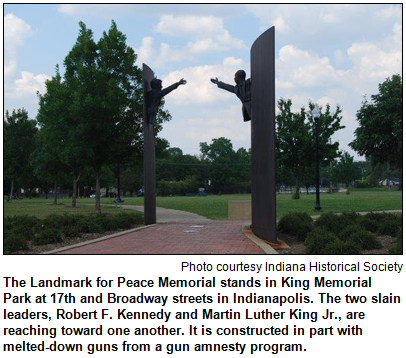 (Aug. 29, 2015) - On April 4, 1968, when Loraine Morris showed up for a speech at an Indianapolis park, she was an 18-year-old senior at Tech High School.
(Aug. 29, 2015) - On April 4, 1968, when Loraine Morris showed up for a speech at an Indianapolis park, she was an 18-year-old senior at Tech High School.
She witnessed an historic event. At the rally, Bobby Kennedy announced the assassination of Dr. Martin Luther King Jr. with an impromptu talk that now is regarded as one of the best American speeches of the 20th century.
As the Indiana Repertory Theatre prepares for the debut of a play about the impact on Hoosiers of what unfolded that night, Loraine, now a mother of three adult children and the grandmother of seven, is among Nelson's studio guests. So is James Still, the award-winning playwright-in-residence at the IRT. His play, titled April 4, 1968 and described as "an intimate look at an Indianapolis family's collision with history," debuts at the IRT on Oct. 20.
Our studio guests also include Marion County Superior Court Judge David Dreyer, who has helped organize commemorative events at the site of the famous speech, which now has a Landmark for Peace Memorial honoring Bobby Kennedy and Martin Luther King Jr.
Members of the Kennedy and King families have visited the sculpture at what is now Dr. Martin Luther King Jr. Park at 17th and Broadway streets.
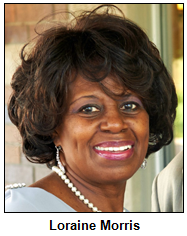 "My family was living at 19th and Park (Avenue), so we weren't that far away from the park," Loraine Morris recalls. "I vividly remembered President Kennedy's assassination, and I always was interested in history. So a classmate at Tech and I were allowed to leave school early. We were the first two people to show up for Bobby Kennedy's speech."
"My family was living at 19th and Park (Avenue), so we weren't that far away from the park," Loraine Morris recalls. "I vividly remembered President Kennedy's assassination, and I always was interested in history. So a classmate at Tech and I were allowed to leave school early. We were the first two people to show up for Bobby Kennedy's speech."
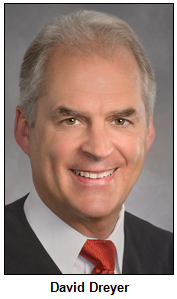 Bobby Kennedy, who would be assassinated two months later, was campaigning for the Democratic nomination for U.S. president. His talk, during which he spoke publicly for the first time about his brother's assassination, often is credited with preventing racial violence in Indianapolis.
Bobby Kennedy, who would be assassinated two months later, was campaigning for the Democratic nomination for U.S. president. His talk, during which he spoke publicly for the first time about his brother's assassination, often is credited with preventing racial violence in Indianapolis.
As James Still has researched the event and its aftermath, including the impact of Dr. King's assassination on Hoosiers, he has done oral interviews with residents who attended the rally in 1968.
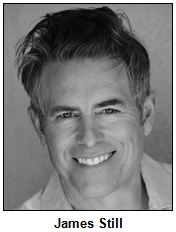 James has been a guest on previous Hoosier History Live shows when he has written other plays that have touched on aspects of Indiana's heritage. They have included a look at Abraham Lincoln (who was the focus of his play The Heavens Are Hung in Black) and pioneer entrepreneur William Conner (who was explored in the play Interpreting William).
James has been a guest on previous Hoosier History Live shows when he has written other plays that have touched on aspects of Indiana's heritage. They have included a look at Abraham Lincoln (who was the focus of his play The Heavens Are Hung in Black) and pioneer entrepreneur William Conner (who was explored in the play Interpreting William).
Although James grew up in Kansas and lives on the West Coast, he has been the IRT's playwright-in-residence for 13 years.
Our guest Loraine Morris is retired after a 23-year career with Indianapolis Public Schools that included working as a counselor and classroom assistant.
Judge David Dreyer, our third guest, is a board member of the Kennedy King Memorial Initiative, a non-profit that has been developing educational programs and community events at the park.
In May 1968, one month after Bobby Kennedy's speech at the park, he pulled off an upset victory in the Democratic presidential primary in Indiana. His crusade is described in the book Robert F. Kennedy and the 1968 Indiana Primary (Indiana University Press, 2008) by frequent Hoosier History Live guest Ray Boomhowerof the Indiana Historical Society.
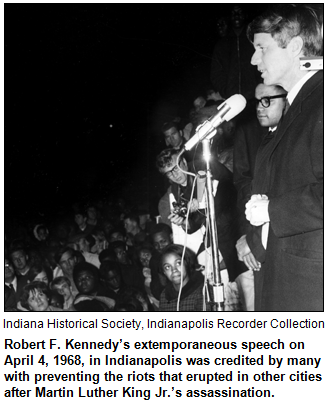 About 2,500 people attended Kennedy's speech at 17th and Broadway. He had been urged to cancel by city leaders, including then-Mayor Richard Lugar. They were concerned about racial tension in the wake of the assassination earlier that day of Dr. King, who had won the Nobel Peace Prize.
About 2,500 people attended Kennedy's speech at 17th and Broadway. He had been urged to cancel by city leaders, including then-Mayor Richard Lugar. They were concerned about racial tension in the wake of the assassination earlier that day of Dr. King, who had won the Nobel Peace Prize.
Instead of canceling, Bobby Kennedy stood on a flatbed truck and broke the news of Dr. King's assassination in Memphis.
The audience for Kennedy's talk ranged from members of the Black Panthers to teenagers like our guest Loraine Morris and Teresa Lubbers, now Indiana Commissioner for Higher Education. Other future civic leaders in attendance included former Indiana Supreme Court Justice Theodore Boehm, former State Rep. Bill Crawford and the late Julia Carson, who became a member of the U.S. Congress.
Initially, Kennedy's five-minute talk received little attention. Local media coverage was minimal. In addition, the speech was overwhelmed by reports about King's assassination and funeral, plus rioting that ensued in more than 110 U.S. cities.
Learn more:
- Television coverage of Bobby Kennedy's poignant impromptu speech in Indianapolis announcing the assassination of Martin Luther King.
Roadtrip - Multitrip-worthy Greenfield
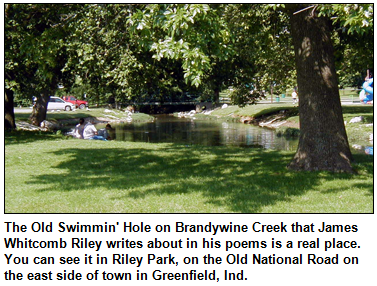 Guest Roadtripper and film historian Eric Grayson, who many of you know as the guy who runs Vintage Movie Night at Garfield Park, suggests a visit to Greenfield just east of Indianapolis.
Guest Roadtripper and film historian Eric Grayson, who many of you know as the guy who runs Vintage Movie Night at Garfield Park, suggests a visit to Greenfield just east of Indianapolis.
It's a place with so much history that it's good for several trips. James Whitcomb Riley grew up in Greenfield, and for a good walk, Eric recommends Riley Park, where you can visit the real Old Swimmin' Hole that Riley wrote about.
It's right off U.S. 40, the National Road, and the Works Progress Administration worked in this park during the New Deal years. There's a shelter house, a remnant of rock garden, and the log cabin may have been moved there by the WPA. If you're sports-minded, the park includes a skate park, basketball courts and a sledding hill.
For dinner, try Carnegie's, located in Greenfield's old Carnegie library, with an upscale menu.
If you're still up for dessert, Eric recommends Litterally Divine Chocolates. The name is not a misspelling; it's a play on words with the owner's last name, Litteral. The location is in a historic building on U.S. 40, just down the street from Riley's boyhood home.
History Mystery
|
In 1985, a road in Indianapolis was renamed Dr. Martin Luther King Jr. Street. The 3.5-mile stretch runs from Michigan Street downtown to West 38th Street. According to an account in The Indianapolis Star, the Hoosier capital is one of about 700 cities across the country with a street that has been renamed in honor of the civil rights leader.
Question: What was the previous name of the road in Indianapolis? Hint: It was not called Michigan Road, which remains the name for the thoroughfare north of West 38th Street.
The prize pack includes two tickets to the Hoosier Hops & Harvest Festival at Story Inn in Brown County on Sept. 12, courtesy of Story Inn, as well as Family 4-Pack to Conner Prairie, which includes for tickets for the 1859 Balloon Voyage, courtesy of Conner Prairie.
Plainfield and Brownsburg town histories
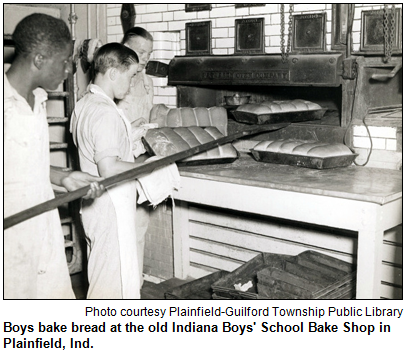 (Aug. 22, 2015) - Historic cemeteries, the Indiana Boys' School, folklore about an incident involving former President Martin Van Buren and early settlers of the two Hendricks County towns.
(Aug. 22, 2015) - Historic cemeteries, the Indiana Boys' School, folklore about an incident involving former President Martin Van Buren and early settlers of the two Hendricks County towns.
Those captivating topics are explored as we delve into the histories of Plainfield and Brownsburg, next up in our rotating series that looks at the heritage of towns across Indiana.
According to Plainfield (Arcadia Publishing, 2012), abolitionist Quakers from North Carolina settled in the area in the 1820s and '30s. To this day, Plainfield High School's nickname is the Quakers.
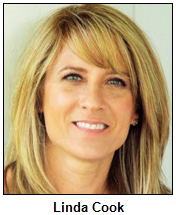 According to Brownsburg (Arcadia Publishing, 2015), when early settler James Brown arrived at what would become Brownsburg, much of the land was swampy and full of water at least part of the year.
According to Brownsburg (Arcadia Publishing, 2015), when early settler James Brown arrived at what would become Brownsburg, much of the land was swampy and full of water at least part of the year.
The authors of both books, which are part of Arcadia's "Images of America" visual history series, are among Nelson's three guests, who are genealogists and librarians.
Linda Cook, a longtime Brownsburg resident and the author of the new book about the town, works at the Brownsburg Public Library and is a volunteer for the Indiana Pioneer Cemeteries Restoration Project.
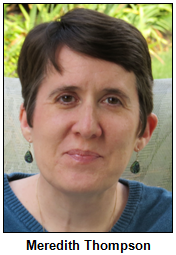 Reann Poray, the author of the Plainfield book, manages the Indiana Room at the Plainfield-Guilford Township Public Library, where our third guest, Meredith Thompson, also works. Meredith is a volunteer for the Indiana Genealogical Society.
Reann Poray, the author of the Plainfield book, manages the Indiana Room at the Plainfield-Guilford Township Public Library, where our third guest, Meredith Thompson, also works. Meredith is a volunteer for the Indiana Genealogical Society.
At the Plainfield library, Reann and Meredith have been digitizing information about the Indiana Boys' School, which had an impact on life in Plainfield for generations.
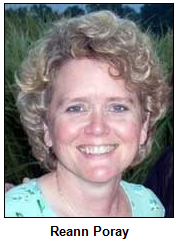 "What is interesting is that the town helped support the institution and vice versa," Reann notes. "The (school's) bakery supplied bread to sell locally, the garden shop sold vegetables, the ice shop sold ice, the print shop took outside orders (and) the sports teams competed with Plainfield and other Hendricks County teams."
"What is interesting is that the town helped support the institution and vice versa," Reann notes. "The (school's) bakery supplied bread to sell locally, the garden shop sold vegetables, the ice shop sold ice, the print shop took outside orders (and) the sports teams competed with Plainfield and other Hendricks County teams."
In 2005, the Indiana Boys' School was closed after 130 years as a reform school as part of a restructuring to become the Plainfield Re-Entry Educational Facility.
In the Brownsburg area, many early settlers and civic leaders were buried in Greenlawn Cemetery, which our guest Linda Cook has been researching. Her book notes that many of the earliest graves have identifying tombstones, "though graves of Quakers, Native Americans and the poor were sometimes marked with fieldstones."
Elm trees have been proliferous in Plainfield and Brownsburg, with one bygone elm in particular becoming the focus of folklore known by many Hoosiers. 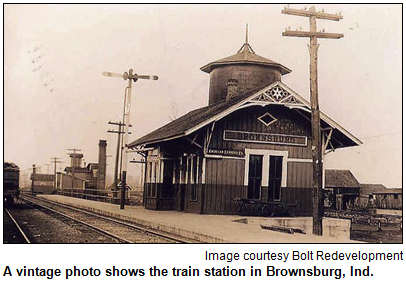 In 1843, Martin Van Buren, who had objected to funds to upgrade the National Road, was "ceremoniously tossed" (as Reann puts it in her book) from his stagecoach into the muddy road. An elm tree on the site became famous. But it was extensively damaged by lightning in 1928, and the remains eventually were removed.
In 1843, Martin Van Buren, who had objected to funds to upgrade the National Road, was "ceremoniously tossed" (as Reann puts it in her book) from his stagecoach into the muddy road. An elm tree on the site became famous. But it was extensively damaged by lightning in 1928, and the remains eventually were removed.
Hoosier History Live explored the heritage of the National Road (which runs through Plainfield and now is known as U.S. 40), as well as the heritage of the Lincoln Highway in northern Indiana, during a radio show in September 2013.
The creation of another road - Crawfordsville Road on the westside of Indy - was a key factor in the evolution of Brownsburg.
The town also was enhanced in 1918 with the opening of a Carnegie Library, although it was closed in 1981 with the creation of the current library. The architect for the Carnegie Library, Merritt Harrison, later designed the Coliseum at the Indiana State Fairgrounds.
Plainfield residents also were served by a Carnegie Library, which opened in 1913. That historic building today houses the Triangle Fraternity, a social and academic organization of architects, engineers and scientists. (History fact: During the early 1900s, more Carnegie Libraries were built in Indiana than in any other state.)
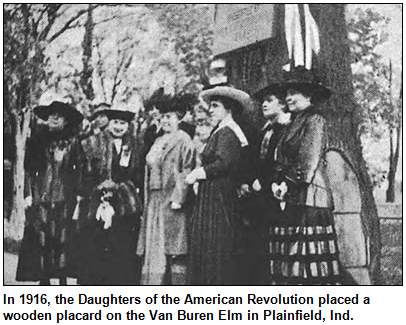 According to our guest Reann Poray's book, the early Quaker settlers inspired the name Plainfield because of their "plain and simple lifestyle." She notes that Quakers (also known as the Society of Friends) opened Central Academy, an early school.
According to our guest Reann Poray's book, the early Quaker settlers inspired the name Plainfield because of their "plain and simple lifestyle." She notes that Quakers (also known as the Society of Friends) opened Central Academy, an early school.
During the late 1800s and early 1900s, Plainfield also was the site of the Keeley Institute, an early drug and alcohol rehabilitation facility.
For decades beginning in 1913, a large Van Camp Packing Company plant in Plainfield employed town residents. Workers at Van Camp (which merged with Stokely Company in 1933) packed tomatoes grown by Hoosier farmers.
Both Plainfield and Brownsburg are growing quickly. According to the 2010 U.S. Census, the population of Plainfield was 27,631, up substantially from 19,439 in 2000. Comparable census figures for Brownsburg are 21,285, up from 14,520.
Learn more:
Roadtrip - State Fair: The Indiana Musical
|
Guest Roadtripper Daina Chamness tells us to catch State Fair: The Indiana Musical at the Pioneer Village Opry House at this year's 2015 Indiana State Fair. Final performances are Friday, Aug. 21, and Saturday, Aug. 22 at 6 p.m. Admission is free with fair admission.
This whimsical musical will take you back from the 1930s through the 1960s with a sugar cream pie contest, clog dancers, singing, a champion boar, favorite fair food and, of course, a State Fair romance!
The musical is directed by one of Indy's favorites, Mac Bellner of Hogeye Navvy.
History Mystery
 Brownsburg is the adopted hometown of the twin brother of a famous race driver. The twin brother settled in Brownsburg more than 35 years ago. As a teenager and young man, he also had been a race driver. After two near-fatal accidents, though, he left the sport.
Brownsburg is the adopted hometown of the twin brother of a famous race driver. The twin brother settled in Brownsburg more than 35 years ago. As a teenager and young man, he also had been a race driver. After two near-fatal accidents, though, he left the sport.
Meanwhile, his brother enjoyed a legendary career in several auto racing circuits before retiring in 1994; the brother never has been an Indiana resident but often is considering an "honorary Hoosier" because of his impact at the Indianapolis Motor Speedway.
Question: Name both of the twin brothers: the Brownsburg resident, as well as his much more famous sibling. The first names of both brothers must be provided.
The prize pack includes two tickets to the Hoosier Hops & Harvest Festival at Story Inn in Brown County on Sept. 12, courtesy of Story Inn, as well as a gift certificate to Iozzo's Garden of Italy, courtesy of Visit Indy.
Postcards from Indiana
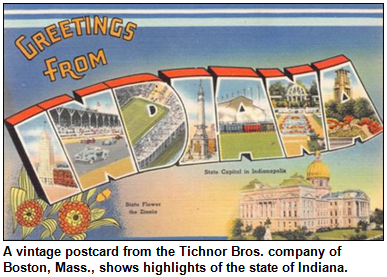 (Aug. 15, 2015) - Here's a dispatch worthy to send far and wide: Beginning in the late 1800s and early 1900s, almost every small town in Indiana had its own postcard.
(Aug. 15, 2015) - Here's a dispatch worthy to send far and wide: Beginning in the late 1800s and early 1900s, almost every small town in Indiana had its own postcard.
So did landmark buildings and institutions. Not just hotels, spas, restaurants and drug stores, but sanitariums, prisons and asylums, as well.
Also during that era, one of the country's most popular postcard artists was based in Indianapolis.
"In the century before Twitter, text messaging and Snapchat, people who wanted to send a short and concise message simply picked up a postcard at the newsstand or drugstore and dropped it in the mail," notes Indianapolis attorney Libby Cierzniak in a recent article for historicindianapolis.com. 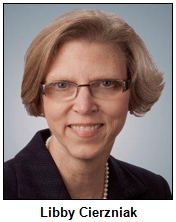 Libby, a partner at Faegre Baker & Daniels, collects vintage photos, postcards, advertising and other memorabilia about the Hoosier capital.
Libby, a partner at Faegre Baker & Daniels, collects vintage photos, postcards, advertising and other memorabilia about the Hoosier capital.
She has written a profile of Cobb X. Shinn, an Indy-based artist of the early 1900s who designed nationally distributed postcards. Although her research indicates Shinn was creating more than 400 different designs annually by 1912, he specialized in postcards that depicted frogs dressed in formal attire.
Libby, a board member of the Old Northside Neighborhood Association, is among Nelson's studio guests as we explore vintage postcards across Indiana.
Other guests are two members of the Indianapolis Postcard Club:
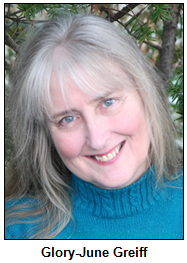 Glory-June Greiff, a public historian and author who uses Indiana postcards (Glory estimates that she owns more than 2,000) for her research about Indiana state parks, outdoor sculptures, roads and roadside attractions. Her books include People, Parks, and Perceptions: A History and Appreciation of Indiana State Parks (Trafford Publishing, 2009) and Remembrance, Faith and Fancy: Outdoor Public Sculpture in Indiana (Indiana Historical Society Press, 2005).
Glory-June Greiff, a public historian and author who uses Indiana postcards (Glory estimates that she owns more than 2,000) for her research about Indiana state parks, outdoor sculptures, roads and roadside attractions. Her books include People, Parks, and Perceptions: A History and Appreciation of Indiana State Parks (Trafford Publishing, 2009) and Remembrance, Faith and Fancy: Outdoor Public Sculpture in Indiana (Indiana Historical Society Press, 2005).- And Dr. Chuck Hazelrigg, a dentist and pharmacist who collects vintage Indiana postcards of small towns, drug stores, sanitariums, asylums and even prisons. Chuck, who lives in Carmel, does history presentations about the former Central State Hospital in Indianapolis, where he was the in-house dentist for many years. He was a guest on a Hoosier History Live show about that topic in 2010.
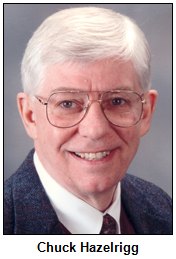 According to the Smithsonian Institution, the postcard era began in the early 1870s with the debut of government-produced, pre-stamped postal cards. (During earlier eras, so-called "mailed cards" were sent by some people who wrote notes on them.)
According to the Smithsonian Institution, the postcard era began in the early 1870s with the debut of government-produced, pre-stamped postal cards. (During earlier eras, so-called "mailed cards" were sent by some people who wrote notes on them.)
In Libby's article, she notes that the popularity of postcards boomed to such an extent that, by 1912, the U.S. Postal Service was processing an average of 8 million postcards daily.
Shinn, who was born in 1887 and studied at what was then called the John Herron Art Institute, designed thousands of the postcards. Many of his designs, according to Libby's article, appeared in a series of four to 16 cards that were sold as sets. They included a "Tin Lizzy" series that featured Model T Ford. Shinn's small studio was at the corner of Ohio and Alabama streets.
Lavish buildings in Indiana that were promoted with postcards included the two world-famous resort hotels in southwestern Indiana, the French Lick Springs Hotel and the West Baden Springs Hotel. Some postcards even were devoted exclusively to promoting the mineral waters available at the hotels, including Pluto water sold at French Lick.
Our guest Chuck Hazelrigg owns postcards from the early 1900s of Indiana towns including Mexico, Milroy and Topeka.
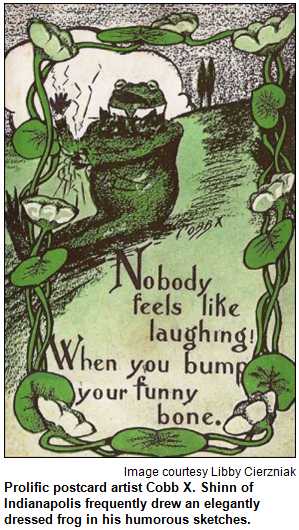 "Typically," he says, "a postcard of a small town from that era is a photo of the town's main street, usually a dirt road, with a telephone pole and a general store. It might have a sign that says "Fresh Meat'."
"Typically," he says, "a postcard of a small town from that era is a photo of the town's main street, usually a dirt road, with a telephone pole and a general store. It might have a sign that says "Fresh Meat'."
Prisons, asylums and other institutions often used postcards as a way for superintendents and other staff members to communicate with families of patients and prisoners, Chuck says. His collection includes postcards of Central State and another mental health institution, Logansport State Hospital.
Referring to the mountains of postcards of small towns more than 100 years ago, Chuck notes, "Remember, not everyone had a telephone in 1902 or 1904. In fact, many people didn't. So mailing a postcard was a quick, efficient way of communicating then, even between people who lived in the same community."
A flurry of other history facts:
- Despite the name of the Indianapolis Postcard Club, our guest Glory-June Greiff reports that active members hail from Kosciusko County in northern Indiana, as well as from Lafayette, Danville, Morgan County and a range of other Hoosier counties, cities and towns.
- In addition to his postcard collection of Indiana towns, drug stores, hospitals and other institutions, Chuck Hazelrigg collects World War I postcards.
- The Indiana Historical Society has a collection of about 15,000 vintage postcards. They depict towns ranging from LaPorte, Elkhart and Monticello to Rushville, Vincennes and Terre Haute.
- According to the Historical Society, nearly 678 million postcards were mailed across the country in 1908 - even though the U.S. population then was only 88.7 million.
Learn more:
- Tichnor Brothers Postcard Collection, Indiana cards.
- Smithsonian Institution.
- Indiana Historical Society.
Roadtrip: Restored lakeside resort near Pokagon
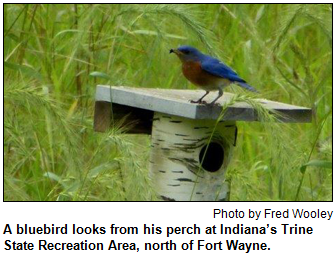 Guest Roadtripper and volunteer naturalist Terri Gorney of Fort Wayne tells us to "turn right rather than left" when driving north from Fort Wayne on I-69 and take the Pokagon State Park exit. When you turn right, you reach the Trine State Recreation Area at 145 W. Feather Valley Road, Fremont.
Guest Roadtripper and volunteer naturalist Terri Gorney of Fort Wayne tells us to "turn right rather than left" when driving north from Fort Wayne on I-69 and take the Pokagon State Park exit. When you turn right, you reach the Trine State Recreation Area at 145 W. Feather Valley Road, Fremont.
Trine is separated from Pokagon by I-69 (turn left for Pokagon). Much of the land at Trine, in the Seven Sisters Lakes area, was a lakeside resort called Wing Haven, which was operated as a lakeside resort by from 1948 to the 1970s by Ben and Helen Swenson, "refugees" from Chicago who formerly had served as innkeepers at the Potawatomi Inn at Pokagon.
Trine was acquired by the Department of Natural Resources in 2007 and is open to the public. You can rent old cabins from the property's Wing Haven era, and fish, hike and rent canoes to explore the glacier-formed natural lakes in the area.
Hungry? Try nearby Timbuktoos or two nearby wineries, Satek and Briali.
By the way, Terri also serves as unofficial social media director for Hoosier History Live for northwestern Indiana; she shares our Facebook posts all over the state!
History Mystery
During the yuletide season more than 60 years ago, postcards of an Indianapolis landmark were distributed that depicted a gigantic replica of Santa Claus. The replica, called "Santa Colossal," had been erected at the historic structure during the Christmas season of 1949.  Towering more than 50 feet tall, Santa Colossal was made of Styrofoam and, thanks to a sound system, "sang" holiday greetings.
Towering more than 50 feet tall, Santa Colossal was made of Styrofoam and, thanks to a sound system, "sang" holiday greetings.
Even though "Santa Colossal" later was chopped up and used for insulation, he had been so popular at the landmark building - where he was seen by tens of thousands of people - that his image was distributed on postcards about the structure for several subsequent years during the Christmas holidays.
Question: What was the well-known building in Indianapolis that once housed "Santa Colossal" and spawned countless postcards with his image?
Hints: The structure, which was constructed in 1888, still stands. It is listed on the National Register of Historic Places.
The prize pack includes two tickets to the Hoosier Hops & Harvest Festival at Story Inn in Brown County on Sept. 12, courtesy of Story Inn, as well as two passes to the Indiana State Museum, courtesy of the Indiana State Museum.
Natural gas boom of 1880s and '90s
(Aug. 8, 2015 - encore presentation) - An entire region in east central Indiana became the setting in the 1880s and '90s for, as one of our guests puts it, "one of the great natural resource discoveries of American history." 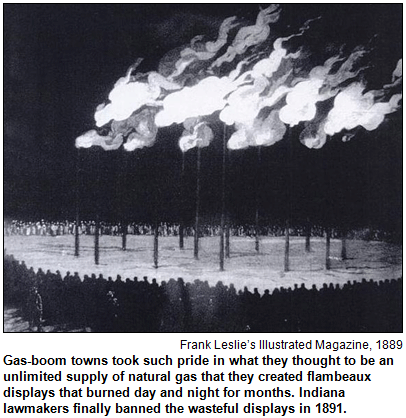 The natural gas boom in Indiana also is regarded as one of the most dramatic eras in the state's history.
The natural gas boom in Indiana also is regarded as one of the most dramatic eras in the state's history.
Alas, the boom - which significantly affected cities such as Muncie, Kokomo, Anderson, Marion, Elwood, Gas City and Fairmont - did not last, even though many civic leaders, businesses and residents assumed the plentiful natural gas would never run out. For most industries, businesses and homeowners, the era was over by 1910 or much earlier.
In this encore broadcast of one of the most popular shows in our Hoosier History Live archives (its original air date was June 7, 1014), we explore what unfolded with the natural gas boom and bust.
Indiana became one of the country's top glass-producing states during the natural gas boom. Nelson is joined in studio by two guests:
- James Glass, a well-known historic preservationist and the co-author of The Gas Boom of East Central Indiana (Arcadia, 2005). Jim, who writes the "Culture Watch" column for The Indianapolis Star, is principal of Historic Preservation and Heritage Consulting.
- And Dave Broman of Kokomo, executive director of the Howard County Historical Society. The society is located in the Sieberling Mansion, a historic residence built by a prominent figure in the gas boom.
According to our guest Jim Glass, Indiana's "gas belt" covered 2,500 square miles, making it the largest gas field in the country in the 1890s.
A range of industries requiring large quantities of fuel were attracted to east central Indiana as a result. They included glass (Muncie became the country's No. 2 glass-producing city after Pittsburgh, Jim writes), brick, wire and nail, iron and strawboard, an early type of cardboard.
So why did the natural gas boom end so quickly?
"No effort to conserve," Jim writes. "No one wanted to believe the gas would run out, despite plenty of scientific evidence."
Learn more:
- Our guests recommend watching this video, Fueling a Region: Indiana's Gas Boom, which was produced in 2013 by WIPB Public TV in Muncie.
History of women's voting rights
(Aug. 1, 2015) - With the 95th anniversary of women's voting rights, Hoosier History Live explores how the suffrage movement unfolded, both in Indiana and across the country.
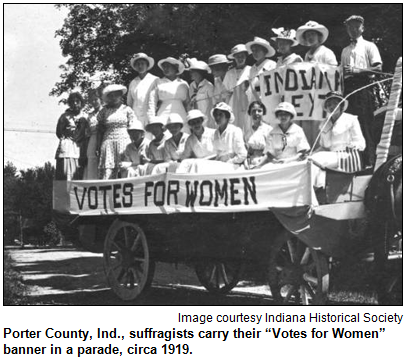 The 19th Amendment to the U.S. Constitution - extending voting rights to women - was ratified in August 1920. Alas, some of the early suffrage leaders did not live long enough to cast a ballot in the November 1920 election, the first presidential race in which women could vote.
The 19th Amendment to the U.S. Constitution - extending voting rights to women - was ratified in August 1920. Alas, some of the early suffrage leaders did not live long enough to cast a ballot in the November 1920 election, the first presidential race in which women could vote.
Nelson is joined in studio by two guests:
- Jill Chambers, president of the Indiana Women's History Association and a member of the Indianapolis Propylaeum. Jill is a key organizer of SheVotes, an Aug. 26 celebratory event of the 95th anniversary that involves more than a dozen women's and history organizations.
- And Laura Merrifield Albright, an assistant professor of political science at the University of Indianapolis. She has researched the historic roles of women in politics.
With Jill and Laura, we explore the formation of the Indiana Woman's Rights Association and the lives of pioneers such as Amanda Way (1828-1914), a native of Randolph County who became known as the "mother of women's suffrage" in Indiana.
A historic marker for Amanda Way was dedicated a few years ago in her hometown of Winchester. A teacher, minister and a battlefield nurse during the Civil War, she organized a pivotal convention in 1851 in Dublin, Ind.; it is considered a milestone in women's rights movement.
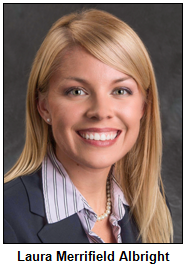 The upcoming SheVotes event will be at the Propylaeum, in Indianapolis at 1410 N. Delaware St. The Propylaeum was founded by May Wright Sewall, an Indianapolis-based suffragist who died in 1920, just before the 19th Amendment was ratified.
The upcoming SheVotes event will be at the Propylaeum, in Indianapolis at 1410 N. Delaware St. The Propylaeum was founded by May Wright Sewall, an Indianapolis-based suffragist who died in 1920, just before the 19th Amendment was ratified. 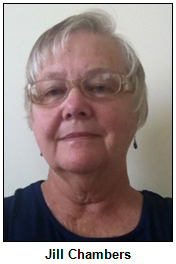 (We explored her life during a radio show in March 2012.) Much of the SheVotes event is free and open to the public, but reservations are required. For questions, e-mail SheVotescommittee@gmail.com; event details are at www.propindy.org.
(We explored her life during a radio show in March 2012.) Much of the SheVotes event is free and open to the public, but reservations are required. For questions, e-mail SheVotescommittee@gmail.com; event details are at www.propindy.org.
The ratification of the 19th Amendment occurred after decades-long crusades, both in Indiana and nationally. To plan strategies, women often met secretly or under the guise of "playing cards" and other social activities.
The National Women's Party was formed in 1916 and was led by Alice Paul (1885-1977), an activist whose life we also explore. She helped draft an early version of the Equal Rights Amendment, which was first introduced in Congress in the 1920s. In 1977, Indiana became the 35th - and last - state to ratify the ERA. (To make the ERA a constitutional amendment, 38 states needed to ratify it.)
Our guest Laura Albright notes that women continue to be underrepresented in state legislatures and the U.S. Congress.
Women account for under 30 percent of state legislators across the country. According to statistics Laura has shared, Indiana ranks 34th among the 50 states, with women constituting 20.7 percent of the Indiana General Assembly.
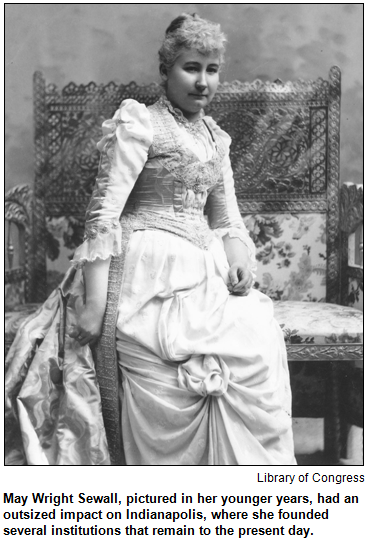 About 22 percent of the U.S. Congress is female. Currently, two of Indiana's nine members of Congress are women.
About 22 percent of the U.S. Congress is female. Currently, two of Indiana's nine members of Congress are women.
Even before women achieved success nationally by winning the right to vote in 1920, some states opened up voting in statewide races. Laura says this "limited form of suffrage" primarily prevailed in Western states, including Wyoming. Those who objected to suffrage expressed several concerns, including predictions that women would be "monolithic," voting as a massive bloc, Laura says.
To celebrate the victory in 1920 over that kind of opposition, organizations involved in the upcoming SheVotes event include the Indiana and Indianapolis chapters of the League of Women Voters, the National Organization for Women and the American Association of University Women, along with the IU School of Law-Indianapolis. Suffragist re-enactors and a brass band playing music of the era also will be featured during the Aug. 26 event.
Learn more:
- Library of Congress, Women's Suffrage.
- National Archives, Women's Suffrage.
- Center for American Women in Politics.
- Indiana Historical Society, Indiana Women's Suffrage Association (originally known as Woman's Rights Association of Indiana).
- Indiana Historical Bureau, Indiana Sites along the Women's History Trail.
- Hoosier History Live, Indiana's Remarkable Suffragist.
- Rutgers University, Center for American Women and Politics.
Roadtrip: Riding the rails in style
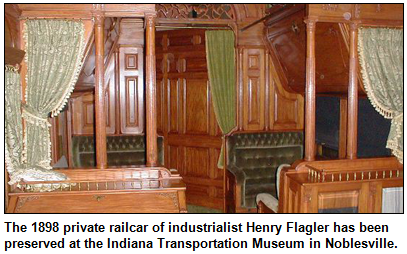 Can you imagine flying down the track as a young girl in the 1950s in wealthy industrialist Henry Flagler's 1898 private railcar, with its carved and inlaid mahogany interior?
Can you imagine flying down the track as a young girl in the 1950s in wealthy industrialist Henry Flagler's 1898 private railcar, with its carved and inlaid mahogany interior?
Guest Roadtripper Margaret Smith, now a retired professor of biology from Butler University, recalls exciting trips as a child on the Flagler railcar, which became known as the "Duchess".
Margaret tells us that her enigmatic uncle, Ike Duffey, had purchased the railcar in 1951, using it to entertain family and friends. Her uncle had organized a professional basketball team, the Anderson Packers, and owned and ran a large meatpacking company. He was also the president of the Indiana Central Railroad.
"I have many memories of trips taken on this elegant, luxurious private car with family and other friends of my uncle," Margaret tells us. "I remember once Gov. Harold Handley was a guest on a trip. We were often invited to go on trips to South Bend to attend Notre Dame football game and Cincinnati for baseball games. Meals and drinks were served in the fancy wood-paneled dining room, and guests would visit in the comfortable living room late into the evening. I remember being particularly fascinated with the three bedrooms; so tiny but with every amenity."
Margaret tells us that she is pleased that the Flagler car has been preserved at the Indiana Transportation Museum in Noblesville. It is not generally open to the public, but private tours may be arranged. Margaret also tells us that she is very proud of the fact that both sides of her family have been in Indiana for more than 150 years.
History Mystery
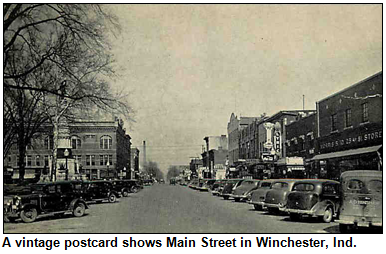 The town of Winchester in far-eastern Indiana - in addition to being the hometown of 19th-century women's rights activist Amanda Way - is known for a food product. The world's largest maker of a type of food is located in Winchester.
The town of Winchester in far-eastern Indiana - in addition to being the hometown of 19th-century women's rights activist Amanda Way - is known for a food product. The world's largest maker of a type of food is located in Winchester.
The food is often associated with Hoosiers. The business that produces it in Winchester has been a family-owned operation for more than 65 years.
Question: What is the food product?
The prize pack includes a family 4-Pack to Conner Prairie, including four tickets for the 1859 Balloon Voyage, courtesy of Conner Prairie, as well two passes to ComedySportz and two passes to a tour of Lucas Oil Stadium (this does not include admission to an event; just the tour) courtesy of Visit Indy.
Appearances
Want to meet Nelson in person?
|
(July 2015) - Our intrepid host Nelson Price will be doing a couple of upcoming appearances that are free and open to the public. He'll be doing his presentation about famous people from Indiana, both historic Hoosiers and contemporary notables whom he has interviewed, at two public libraries in Columbus and Greenfield.
His presentation is accompanied by an extensive display of photos and illustrations featured in Nelson's books, including Indiana Legends: Famous Hoosiers from Johnny Appleseed to David Letterman.
Nelson will be at the Bartholomew County Public Library in Columbus at 6:30 p.m. on Monday, July 27, and at the Greenfield Public Library at 7 p.m. on Wednesday, July 29.
In addition to hosting Hoosier History Live, Nelson does give professional presentations and tours. For booking information, costs and availability, he may be contacted directly.
Jeanne White-Ginder, Ryan's mom
(July 25, 2015) - In the mid-1980s, when her son, Ryan White, was crusading to attend school, she was a single parent working at a factory in Kokomo.
Since then, Jeanne White-Ginder has become an international advocate for AIDS education and prevention. A few months after Ryan died at age 18 in 1990, President George H.W. Bush signed the Ryan White Care Act; in 2009. 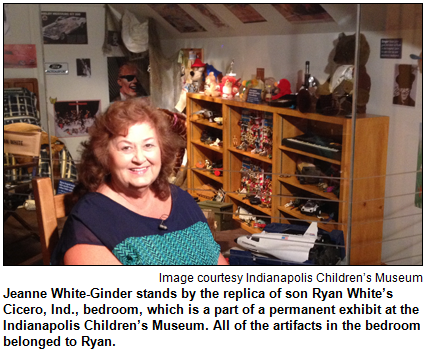 President Obama signed an extension of the act in a ceremony at the White House with Jeanne at his side.
President Obama signed an extension of the act in a ceremony at the White House with Jeanne at his side.
On July 24, 2015, she was named a Living Legend by the Indiana Historical Society; on the following day, she was Nelson's guest on our show. Nelson is the author of The Quiet Hero: A Life of Ryan White (Indiana Historical Society Press), a new biography of the teenager, a hemophiliac who contracted AIDS from a contaminated blood-clotting product.
"I could not be more proud to be his mother," says Jeanne, who moved to Leesburg, Fla., in the late 1990s with her husband, Roy Ginder.
Telling the "mom's story," Jeanne speaks overseas, around the country and across Indiana - including, most recently, in Scott County, which has been grappling with an epidemic of HIV, the virus that causes AIDS.
Ryan White was barely past his 13th birthday when he was diagnosed with AIDS at Riley Hospital for Children in Indianapolis. Despite pockets of intense community opposition, he crusaded to attend Western Middle School in Russiaville. As a newspaper reporter, Nelson covered various aspects of the story, including the White family's eventual move to Cicero, where Ryan is buried.
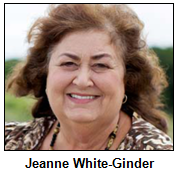 Celebrity supporters of the Whites included rock stars Elton John and Michael Jackson, as well as Olympic diving champion Greg Louganis, who joined Jeanne and Nelson for events in April in connection with the 25th anniversary of Ryan's death.
Celebrity supporters of the Whites included rock stars Elton John and Michael Jackson, as well as Olympic diving champion Greg Louganis, who joined Jeanne and Nelson for events in April in connection with the 25th anniversary of Ryan's death.
During our show, Jeanne discusses the impact, then and now, of Ryan's crusade on her family members. They include Ryan's younger sister, Andrea, who had been a state rolling-skating champion at age 12 in Kokomo; today, Andrea is a 6th-grade teacher in Florida.
Jeanne graduated from Kokomo High School in 1965; shortly afterward, she began work at Delco Electronics Corporation, which produced auto engines and electronics. At the factory, she met Wayne White, who became her first husband. The Whites were divorced by the time Ryan was diagnosed with AIDS during the Christmas season of 1984. (Wayne White died several years ago.)
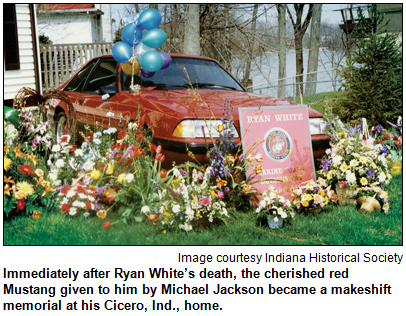 When Ryan crusaded to attend school, the opposition took several forms, ranging from lawsuits and petitions to repeated, regular trash dumps on the White family's lawn. Some parents set up a private school so their children would not be in the same building with Ryan.
When Ryan crusaded to attend school, the opposition took several forms, ranging from lawsuits and petitions to repeated, regular trash dumps on the White family's lawn. Some parents set up a private school so their children would not be in the same building with Ryan.
In 1987, the family moved to Cicero, where Ryan attended Hamilton Heights High School. By then, he had become a national celebrity with his appearances on talk shows and speeches to teacher conventions, groups of children and even a presidential commission (that included members of the Cabinet and of the U.S. Congress) on Capitol Hill in Washington D.C.
Since her son's death, Jeanne has carried on his advocacy work, serving, for example, on the advisory board of the AIDS Institute. She frequently speaks at the Children's Museum of Indianapolis, where the furniture from Ryan's bedroom is displayed in a permanent exhibit that honors three inspirational young people.
In addition to Ryan, the exhibit, titled "The Power of Children: Making a Difference", salutes Holocaust victim Anne Frank and Ruby Bridges, an African-American girl who helped integrate schools in the Deep South during the early 1960s.
Hoosiers named Living Legends - in addition to Jeanne - were Jack Everly, pops conductor of the Indianapolis Symphony Orchestra; Evansville-based philanthropists Dick and Rita Eykamp, and civic leaders Jerry and Rosie Semler of Indianapolis.
|
Roadtrip: Cats on patrol at the Boone County Courthouse
Guest Roadtripper and history enthusiast Bonnie Carter of Zionsville suggests we visit the town of Lebanon, about 25 miles northwest of Indianapolis.
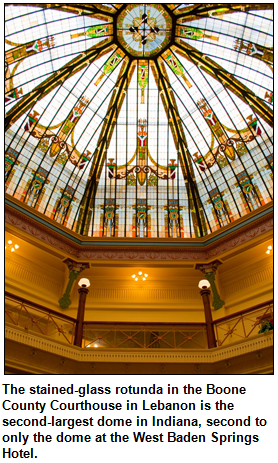 At the heart of Lebanon's downtown stands the 1912 Beaux-Arts Boone County Courthouse. The columns at the north and south entrances to the courthouse stand 35 feet tall, and they're made entirely from local Indiana limestone.
At the heart of Lebanon's downtown stands the 1912 Beaux-Arts Boone County Courthouse. The columns at the north and south entrances to the courthouse stand 35 feet tall, and they're made entirely from local Indiana limestone.
When you walk inside; look up at the beautiful stained-glass rotunda. Chances are you will see either "Boone" or "Panda," the two cats who call the courthouse their home.
Courthouse Maintenance Director Mike Miller says it is the job of Boone and Panda to look out the window for pigeons and scare them off. The maintenance crew says it is working, not only for the courthouse and the dome, but also for all of downtown Lebanon as well.
"The mess was falling in front of the entrance door, and we were having to clean that up on a daily basis," said Miller. "We did not want that."
Hungry? Check out the Bijou Restaurant, just south of the Boone County Courthouse, which offers French dining in a beautifully restored late-1800s building. Just a stroll away is the specialty shop Mount's Flowers & Gifts.
And do take a look at the Theatre at the Milk Building, home of a local theater troupe whose site is the repurposed Condensed Milk Co. building.
History Mystery
During the historic 1987 Pan American Games in Indianapolis, legendary diver Greg Louganis won both gold medals in his sport and gave one of them to Ryan White.
The lavish opening ceremony for the Pan Am games featured 6,500 performers, including hundreds of Hoosier gymnasts, dancers, musicians, aerialists and athletes. Ryan's sister, Andrea, who had been a state-champion roller skater at age 12, was among the skaters who performed during the opening ceremony, a multi-sensory spectacle that was produced by Disney.
Question: What venue in Indianapolis was used for the opening ceremony for the 1987 Pan Am Games?
The prize pack includes a gift certificate to the Tin Roof, A Live Music Joint, courtesy of Visit Indy, and a family 4-pack to Conner Prairie, including the 1859 Balloon Voyage, courtesy of Conner Prairie.
Two sensational murders in the 1920s
|
(July 18, 2015) - One murder case involved a bootlegger who killed his wife - and attempted to pin the crime on their chauffeur.
The other case involved a woman, called a "feminine Bluebeard" by journalists in the 1920s, who poisoned her husband. Make that two husbands. She probably poisoned one of her fathers-in-law as well.
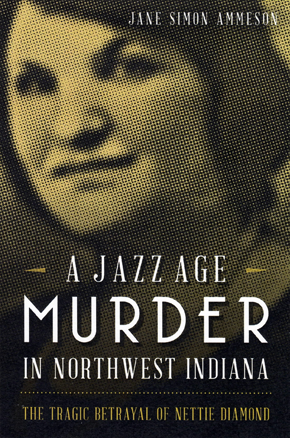 The setting for the first case during the Roaring '20s was urban: East Chicago, which was a boom town in 1923. That's when handsome bootlegger Harry Diamond shot his wife, Nettie Herskovitz Diamond, who had been a wealthy widow when she married him.
The setting for the first case during the Roaring '20s was urban: East Chicago, which was a boom town in 1923. That's when handsome bootlegger Harry Diamond shot his wife, Nettie Herskovitz Diamond, who had been a wealthy widow when she married him.
The setting for the other crimes was much more rural: Hancock County. That's where Clara Carl poisoned her husband, Frank Carl, when the couple was living in the small Indiana town of Philadelphia. She probably also poisoned Frank's father, 85-year-old Alonzo Carl, as well as her first husband, Robert Gibson.
To explore the murders that drew national attention to Indiana during the early 1920s, Nelson is joined in studio by two guests who have researched the lurid crimes:
- Jane Ammeson, the author of the new book A Jazz Age Murder in Northwest Indiana: The Tragic Betrayal of Nettie Diamond (Arcadia Publishing). Jane grew up in East Chicago near several sites associated with the Diamond family. In fact, Jane's mother once dated the son of Nettie Herskovitz Diamond, whose past remains mysterious. It's unclear whether Nettie (who became a pharmacist, a rarity for women during the era) was married three or four times.
- Brigette Cook Jones, the Hancock County historian. Brigette began researching the Clara Carl case after inquiries from a cable TV show that broadcast a program about the murders. After the death in 1921 of Frank Carl by arsenic poisoning, the bodies of his father and Robert Gibson were exhumed. Both of them also were found to have shockingly high levels of arsenic in their systems.
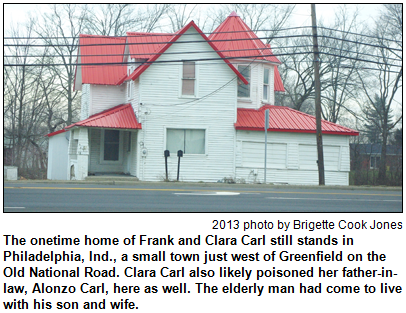 As a speaker about historic topics, Brigette has been doing presentations about the murders and subsequent trial of Clara Carl.
As a speaker about historic topics, Brigette has been doing presentations about the murders and subsequent trial of Clara Carl.
Both Jane and Brigette have been popular guests on previous Hoosier History Live shows.
Most recently, Jane was a guest on a show last November about Jennings County and the historic town of Vernon. As the co-author of the visual history book Brown County (Arcadia Publishing, 2010) Jane also was a guest on a show about the history of that scenic county.
Brigette was a guest last fall for a Hoosier History Live show about the early years of famous poet James Whitcomb Riley. (You can listen to that show's audio.)
Brigette also was the guest on a program about the real-life girl who inspired Riley's classic poem Little Orphant Annie.
That's a far cry from the "tabloid fodder" (to use a phrase in Jane’s book) that resulted from the murder cases we explore. 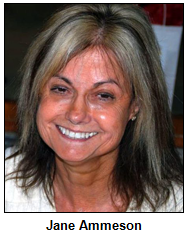 When Nettie Diamond was shot and savagely beaten on Valentine's Day 1923 by her husband in their Hudson sedan, some newspapers described it as "the most famous murder case in the history of Lake County."
When Nettie Diamond was shot and savagely beaten on Valentine's Day 1923 by her husband in their Hudson sedan, some newspapers described it as "the most famous murder case in the history of Lake County."
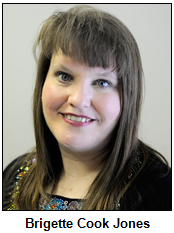 Despite her horrific wounds, Nettie lived long enough to identify Harry as her assailant. He eventually was held in Valparaiso on the day of a massive Ku Klux Klan march in front of the jail; Harry, who was of Russian Jewish heritage, feared for his safety. Nettie's heritage was Romanian, one of the dominant ethnic groups in East Chicago during the era.
Despite her horrific wounds, Nettie lived long enough to identify Harry as her assailant. He eventually was held in Valparaiso on the day of a massive Ku Klux Klan march in front of the jail; Harry, who was of Russian Jewish heritage, feared for his safety. Nettie's heritage was Romanian, one of the dominant ethnic groups in East Chicago during the era.
With both of the murder cases that we explore, sensational trials followed the crimes. During the trial of Clara Carl, the Hancock County prosecutor referred to her as "rotten to the core."
She received a life sentence at the Indiana Women's Prison and was assigned to feed chickens in the prison yard. In 1925, she made a daring escape by scrambling onto the roof of the chicken house, then climbing over the prison wall.
Tune in to our show to hear Nelson's guests describe the eventual outcomes of both cases.
Roadtrip: Kokomo, the 'City of Firsts'
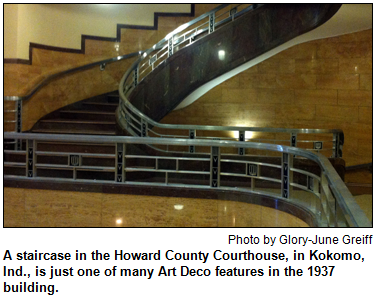 Public historian Glory-June Greiff suggests a Roadtrip to Kokomo, the self-proclaimed "City of Firsts," which she reports has undergone a renaissance.
Public historian Glory-June Greiff suggests a Roadtrip to Kokomo, the self-proclaimed "City of Firsts," which she reports has undergone a renaissance.
"Oh, you can still go to Highland Park southwest of downtown and see some of the most bizarre artifacts in Indiana; that would be Old Ben, the huge stuffed bull, and the gigantic sycamore tree stump," says Glory. "And Kokomo still has several wonderful museums and attractions; the Gilded Age Seiberling Mansion, home of the Howard County Historical Society, and the Elwood Haynes (inventor of the first car in America) Museum have always been favorites. But stroll around downtown and sample some of its delights. There are lots of fascinating shops. And walk through the jaw-dropping Art Deco courthouse (you can't miss it!)."
Hungry? Glory recommends the Main Street Cafe at Main and Mulberry. There's also Jamie's Soda Fountain for your ice cream habit, just to the north on Main Street.
Kokomo was and is an industrial city. The Industrial Heritage Trail, which runs through downtown, lies on a former railway line. Not all industry is gone, though; check out Kokomo Opalescent Glass, the nation's oldest art glass company, at 1310 South Market. They have a gift shop full of stunning glassware, and you can arrange to take a tour, which is very cool. Although, Glory tells us, "not in terms of temperature!"
History Mystery
Prohibition prevailed during the 1920s, when the sensational murders in East Chicago and Hancock County occurred. During that era, speakeasies were thriving in an Indiana city that had a population of more than 60,000 people then.
 This Indiana city had a German beer-making district that flourished before Prohibition. Even though the beer business was associated with the German heritage of the city, the town's name is derived from a French phrase.
This Indiana city had a German beer-making district that flourished before Prohibition. Even though the beer business was associated with the German heritage of the city, the town's name is derived from a French phrase.
After Prohibition, the beer-making industry in the city never fully recovered, although some nationally distributed beers continued to be brewed there for many years. The city's population declined after the 1920s but has climbed back to about 60,000 people today.
Question: What is the Indiana city with a French name and a German heritage of beer-making?
Hint: A university is located in its downtown.
The prize pack includes a gift certificate to Burgerhaus restaurant, right on the Central Canal in downtown Indy! and two admissions to the Indiana Experience at the Indiana History Center, all courtesy of Visit Indy.
Vinyl records and albums: play 'em again
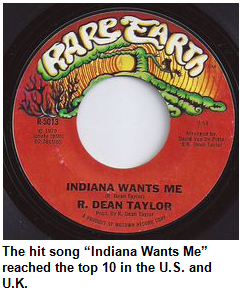 (July 11, 2015) - Not too long ago, vinyl records and albums seemed to be a chapter (albeit a bulging one) in history.
(July 11, 2015) - Not too long ago, vinyl records and albums seemed to be a chapter (albeit a bulging one) in history.
Stop the music. A comeback is under way for singles and albums on vinyl - the way hit songs performed by entertainers from Frank Sinatra, the Beatles and the Rolling Stones to the Jackson Five, Linda Ronstadt and John Mellencamp were introduced.
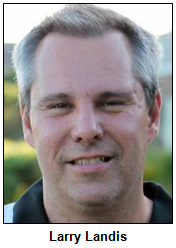 To explore the heyday, decline and recent re-rise of vinyl records and albums, Nelson is joined in-studio by three Hoosier guests. They include a record collector/seller who has an inventory of more than 250,000 albums and 80,000 singles. He is Larry Landis, who operates Legend Records inside the Main Street Shoppes in Westfield.
To explore the heyday, decline and recent re-rise of vinyl records and albums, Nelson is joined in-studio by three Hoosier guests. They include a record collector/seller who has an inventory of more than 250,000 albums and 80,000 singles. He is Larry Landis, who operates Legend Records inside the Main Street Shoppes in Westfield.
One of our other guests, Rick Wilkerson, reports that sales of vinyl records have been increasing by 50 percent annually in recent years. Rick, the owner of Irvington Vinyl, says vinyl records now account for 6 percent of total music sales, so it's still a relatively small portion.
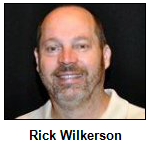 For about 70 years during the 20th century, though, vinyl was king. Record players and turntables could be found in almost every home. The hi-fi eventually became a standard furnishing, as well.
For about 70 years during the 20th century, though, vinyl was king. Record players and turntables could be found in almost every home. The hi-fi eventually became a standard furnishing, as well.
So our guests also include John Scot Sheets, the owner of Affordable Hi Fi, who repairs and sells record players and turntables. John also is a musician and songwriter.
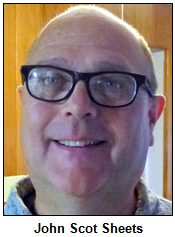 According to an article in Senior Life, a monthly newspaper serving the over-50 set in central Indiana, our guest Larry Landis' collection includes "bootleg albums, mint pressings, limited editions and albums that still contain all of the posters, stickers and freebies originally included."
According to an article in Senior Life, a monthly newspaper serving the over-50 set in central Indiana, our guest Larry Landis' collection includes "bootleg albums, mint pressings, limited editions and albums that still contain all of the posters, stickers and freebies originally included."
The heyday of vinyl music is now more than 25 years in the past. By the late 1980s, digital media was making significant inroads, with compact discs (CDs) starting to take over.
Despite the continual technological advances, some folks still prefer to listen to albums and records the old-fashioned way; increasing numbers of young people, even teenagers, are joining the crowd. Nelson and his guests explore why.
His guests also share insights about which vintage albums and records are in demand. And which are not.
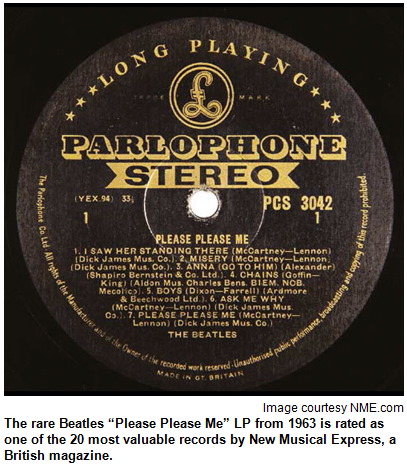 FYI: "LP" is an abbreviation for "long play." Music historians credit Columbia Records with introducing LP albums on vinyl in 1948. LP quickly became the standard format for vinyl albums; it typically allows at least 10 recordings on a single disc.
FYI: "LP" is an abbreviation for "long play." Music historians credit Columbia Records with introducing LP albums on vinyl in 1948. LP quickly became the standard format for vinyl albums; it typically allows at least 10 recordings on a single disc.
Some vinyl-records trivia connected to the Hoosier state:
- A group called Indiana Vinyl is trying to document every vinyl record or LP album released by a Hoosier musician from 1950 to 1990.
- Hoosiers who won Grammy Awards for albums during that era include Wes Montgomery, the star of the Indiana Avenue jazz scene in Indianapolis. His album, "Goin' Out of My Head," won a Grammy in 1965. Three years later, as he was preparing to tour Japan, Montgomery died of a heart attack at age 45.
- Our guest Rick Wilkerson is involved in efforts to create an Indiana Music and Entertainment Museum to document and preserve the state's music heritage.
Learn more:
Roadtrip: Works of African-American contractor and architect Samuel Plato
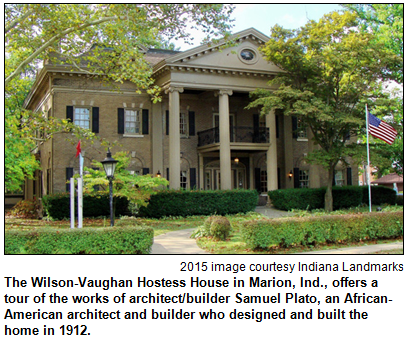 Guest Roadtripper Kisha Tandy of the Indiana State Museum suggests a Roadtrip to learn more about African-American contractor and architect Samuel Plato, who lived and built homes in and around Marion, Ind., from 1902 to 1921.
Guest Roadtripper Kisha Tandy of the Indiana State Museum suggests a Roadtrip to learn more about African-American contractor and architect Samuel Plato, who lived and built homes in and around Marion, Ind., from 1902 to 1921.
Born in 1882 in Alabama, Plato graduated from State University Normal School in Louisville in 1902 and then completed a mail-order program in architecture with International Correspondence Schools. Plato left a structural legacy of churches, homes and United States Post Offices not only in Marion but also in Louisville, Ky., where he moved after leaving Marion. He died in 1957.
On Saturday, July 25, you'll have an opportunity to explore the architectural works of Plato at a daylong tour in Marion hosted by Indiana Landmarks' African American Landmarks Committee. The program is based at the Plato-designed Wilson-Vaughan Hostess House. Tickets are $40 per person, $25 per member of Indiana Landmarks. Lunch is included. Register online at https://platoexperience.eventbrite.com or call Chris DellaRocco, (800) 450-4534 or (317) 822-7923.
Learn more:
- Some National Register details about the Wilson-Vaughan Hostess house.
- Images and info about the Broadway Temple AME Zion Church in Louisville.
History Mystery
In 1977, a singer who grew up in Wabash, Ind., and graduated from Wabash High School had a cross-over hit with a tune that topped both the pop and country charts. She won a Grammy Award for the song, which remains her biggest claim to fame.
She also has recorded music composed by Indiana native Hoagy Carmichael.
Question: Who is she?
Hint: She has an older sister who also is a famous singer - but who did not grow up in Indiana.
The prize pack includes a gift certificate to Iozzo's Restaurant, courtesy of Visit Indy, and two tickets to the Indiana State Museum, courtesy of the Indiana State Museum.
Colorful Indiana-born baseball players
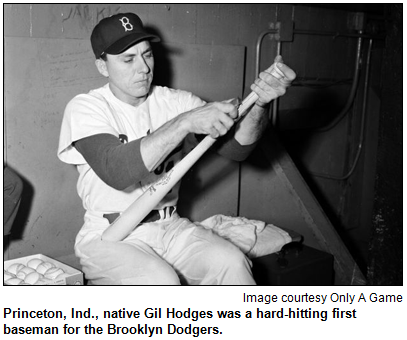 (July 4, 2015) - A Hoosier from Michigan City pitched the only "perfect game" in a World Series. Another major league baseball player from Indiana, a superstar for the New York Yankees, wore a number on his uniform (23) that symbolized a family tragedy.
(July 4, 2015) - A Hoosier from Michigan City pitched the only "perfect game" in a World Series. Another major league baseball player from Indiana, a superstar for the New York Yankees, wore a number on his uniform (23) that symbolized a family tragedy.
And an obscure infielder from South Bend was the answer to a trivia question posed in the popular Peanuts comic strip by Charles Schulz.
They are among the baseball figures we explore as Nelson is joined by Indianapolis-based sports historian Pete Cava, the author of an upcoming, definitive book titled Indiana-Born Major League Baseball Players: A Biographical Dictionary, 1871-2014 (McFarland Publishing).
So many native Hoosiers have excelled in the major leagues (10 natives of Indiana are enshrined in the Baseball Hall of Fame in Cooperstown, N.Y.) that we can't cover all of the stars in a single show. Instead, we focus on some of the most colorful anecdotes associated with pro baseball players during our program with Pete, who has had an extensive career writing about baseball and Olympic sports.
His new book, which will be published in the fall, includes an entry about Tommy John from Terre Haute, the former pitcher who underwent a pioneering type of elbow operation that ever since has been known by his name. "Tommy John surgery" has saved the careers of many pitchers, Pete notes.
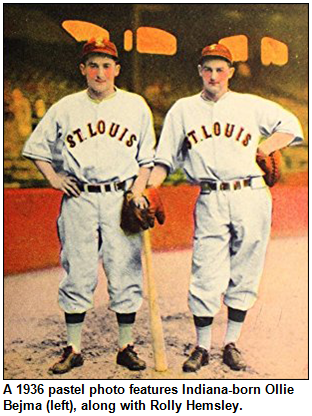 The player whose uniform number symbolized a family tragedy was Evansville native Don Mattingly, who created a sensation with his stellar play as a Yankees first baseman during the 1980s.
The player whose uniform number symbolized a family tragedy was Evansville native Don Mattingly, who created a sensation with his stellar play as a Yankees first baseman during the 1980s.
Southern Indiana also was the home turf of a first baseman who Pete contends has been unfairly neglected by the Hall of Fame. Princeton native Gil Hodges (1924-1972) was a hard-hitting first baseman for the Brooklyn (and later Los Angeles) Dodgers. 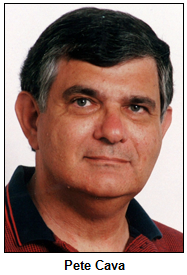 Then, Hodges managed the New York Mets to a shocking upset in the 1969 World Series. The team has gone down in history as the "Miracle Mets."
Then, Hodges managed the New York Mets to a shocking upset in the 1969 World Series. The team has gone down in history as the "Miracle Mets."
During the 1956 World Series, Michigan City native Don Larsen of the Yankees pitched a "perfect game" that, to this day, is the only one in the history of the World Series.
So who inspired the Peanuts trivia question? A shortstop named Ollie Bejma (1907-1995), a South Bend native who captivated spectators in the 1930s on a short-lived major league team from St. Paul, Minn. More than 35 years later, he was saluted in Peanuts by Schulz, a Minnesota native.
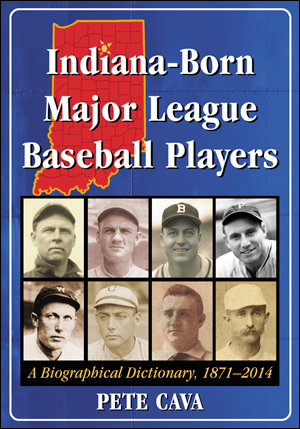 During our show, Pete also shares insights about an outfielder and manager in the early 1900s who committed suicide in French Lick. The unexpected death of Charles "Chick" Stahl, who killed himself in 1907, has been shrouded in mystery for more than a century. He grew up in Fort Wayne and played for - and managed - Boston-based teams.
During our show, Pete also shares insights about an outfielder and manager in the early 1900s who committed suicide in French Lick. The unexpected death of Charles "Chick" Stahl, who killed himself in 1907, has been shrouded in mystery for more than a century. He grew up in Fort Wayne and played for - and managed - Boston-based teams.
Other major league baseball players that we explore include:
- George Crowe (1921-2011), the brother of the late Ray Crowe, who coached Attucks High School to back-to-back basketball championships in the mid-1950s. The Crowe brothers grew up in Franklin. George Crowe graduated from the University of Indianapolis (then Indiana Central College) and went on to play for pro baseball teams in Boston, Milwaukee, Cincinnati and other cities. Pete describes George Crowe as "Indiana's version of Jackie Robinson," referring to the legendary player who broke the color barrier in the major leagues.
- Bob Anderson of East Chicago. Anderson (1935-2015), a pitcher, has the distinction, as Pete puts it, of being "on the mound the only time in big league history when two baseballs were in play at the same time." Pete shares details about this bizarre occurrence, which happened in 1959 at Wrigley Field in Chicago.
- And Mattingly, who was born in Evansville in 1961 in a family of athletes. Since retiring as a Yankee player in 1995, Mattingly has remained in the headlines. He currently is the manager of the Los Angeles Dodgers.
Learn more:
Roadtrip: Mary Gray Bird Sanctuary in Connersville
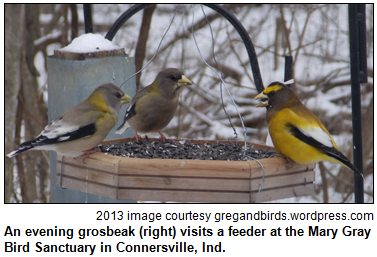 Guest Roadtripper Terri Gorney of Fort Wayne suggests a visit to the Mary Gray Bird Sanctuary. Owned and operated by the Indiana Audubon Society, the sanctuary is located in Connersville in Fayette County.
Guest Roadtripper Terri Gorney of Fort Wayne suggests a visit to the Mary Gray Bird Sanctuary. Owned and operated by the Indiana Audubon Society, the sanctuary is located in Connersville in Fayette County.
Alice Green Gray gave the initial 264-acre property to the Indiana Audubon Society in 1943 as a living memorial to her daughter Mary, who preceded her in death. Congressman Finley H. Gray willed additional property to the society in 1947, bringing the total to more than 600 acres.
Interestingly, the Grays offered the "Canal House," the headquarters of the Whitewater Canal that passed through Connersville, to the Indiana Audubon Society to sell in order to generate funds for the sanctuary.
Ongoing research at the sanctuary includes three decades of turtle studies, graduate-student research looking for relations between forest plant species and breeding birds, plant populations, Monitoring Avian Populations and Sustainability (MAPS) with bird banding, and hummingbird banding during migrations and breeding seasons. More than 107 ruby-throated hummingbirds have been banded this year at the Mary Gray Bird Sanctuary.
Girl Scouts and Boy Scouts are active with projects at the sanctuary. Projects include bridge building, chimney swift towers for nesting, invasive plant eradication, erosion control and bluebird box installations.
The bird sanctuary is open 365 days a year during daylight hours. There is no set fee; a donation box is located next to the parking lot.
History Mystery
 A long-retired Major League Baseball pitcher from Indiana is known for playing the harmonica. He has played Take Me Out to the Ballgame and other tunes at concerts and sporting events.
A long-retired Major League Baseball pitcher from Indiana is known for playing the harmonica. He has played Take Me Out to the Ballgame and other tunes at concerts and sporting events.
Born in 1926, he played in the Major Leagues from the late 1940s through the late 1950s. He pitched in five World Series, retired at age 32 and moved back to his hometown in Indiana. Last year, he was a guest on Hoosier History Live.
Question: Who is he?
The prize pack includes two tickets to any Indianapolis Indians games this season, courtesy Visit Indy.
YMCA heritage
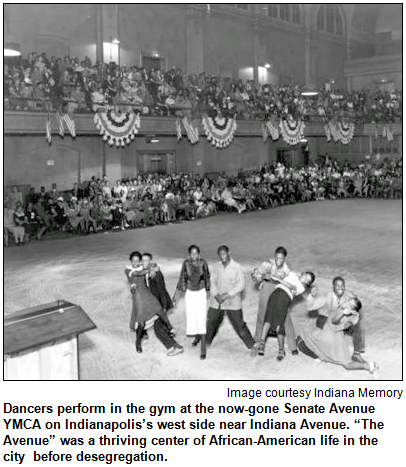 (June 27, 2015) - With a flurry of new YMCAs opening recently or anticipated soon in the Indianapolis area, it's easy to forget that the Y's roots stretch back more than 160 years in the Hoosier capital.
(June 27, 2015) - With a flurry of new YMCAs opening recently or anticipated soon in the Indianapolis area, it's easy to forget that the Y's roots stretch back more than 160 years in the Hoosier capital.
Amid the attention focused on new or expected YMCAs in the CityWay area of downtown Indy, the Avondale Meadows neighborhood long described as "struggling," Pike Township and even an unusual Indy Bike Hub YMCA, Hoosier History Live explores the heritage of the Y in central Indiana and elsewhere in the state.
It's a story that begins in 1854 in the Hoosier capital, just 10 years after the first Y opened in England.
Early civic leaders involved in the YMCA included Eli Lilly and future U.S. president Benjamin Harrison.
Wealthy entrepreneur Madam Walker became an important supporter of the Senate Avenue YMCA, which opened in 1912 as the first Y for African-Americans in Indianapolis. (The building, now long demolished, was dedicated by Booker T. Washington.)
Nelson is joined in studio by Eric Ellsworth, president and CEO of the YMCA of Greater Indianapolis, which includes YMCAs in Avon, Fishers and the former Fort Harrison.
Other guests include Dr. Stanley Warren, the author of The Senate Avenue YMCA for African-American Men and Boys (Donning Company Publishers) and a retired college and high school history teacher. (Last year, Dr. Warren was a Hoosier History Live guest for a show about Attucks High School; he was a student and, later, a teacher at the school.)
 A potpourri of YMCA heritage facts:
A potpourri of YMCA heritage facts:
- In 1902, the first summer camp for boys in the Indy-based Y was held. The setting was the Lake Wawasee estate of J.K. Lilly, son of Eli and the then-president of the Y board in the Hoosier capital.
- In 1946, the YMCA purchased 103 acres on the Flatrock River and opened a summer camp there the next year.
- According to a recent story in The Indianapolis Star, the CityWay YMCA currently under construction will be 87,000 square feet. Among other features, it will have three full-sized basketball courts, a running track "with sweeping views of the city skyline," two swimming pools and a yoga studio. The $24 million health and fitness facility is expected to open in December in CityWay, which is on the south side of downtown Indy.
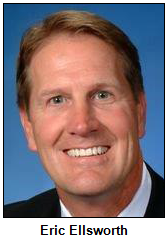 In northern Indiana, Camp Tecumseh has become a beloved site, with a heritage of more than 90 years. Established in 1924 by the YMCA and northern Indiana residents, Camp Tecumseh is on the banks of the Tippecanoe River near the towns of Brookston and Delphi.
In northern Indiana, Camp Tecumseh has become a beloved site, with a heritage of more than 90 years. Established in 1924 by the YMCA and northern Indiana residents, Camp Tecumseh is on the banks of the Tippecanoe River near the towns of Brookston and Delphi.
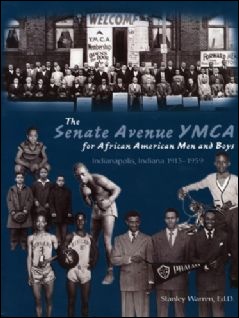 According to the camp's history, the name of Camp Tecumseh was suggested in the 1920s by an 11-year-old boy from the town of Battle Ground, Ind.; he wanted to honor the legendary Shawnee leader. Today, Camp Tecumseh is visited annually by more than 35,000 people for summer camps, field trips, meetings and retreats.
According to the camp's history, the name of Camp Tecumseh was suggested in the 1920s by an 11-year-old boy from the town of Battle Ground, Ind.; he wanted to honor the legendary Shawnee leader. Today, Camp Tecumseh is visited annually by more than 35,000 people for summer camps, field trips, meetings and retreats.
Some trivia about Camp Tecumseh: During the first summer, campers slept in tents. Subsequently, cabins were built during the mid-1920s; one of the original cabins remains as a historical monument. (In the early 1970s, summer campers included future movie and TV actor Greg Kinnear, a native of Logansport.)
In contrast to the rural setting of Camp Tecumseh, the Senate Avenue YMCA was in an urban part of downtown Indy. According to the book by our guest Dr. Warren, the idea for the Senate Avenue Y began in 1901 with a gathering of African Americans known as the Young Men's Prayer Band.
Although the Senate Avenue YMCA eventually was closed (as were its successor, the Fall Creek YMCA, and the massive Central YMCA, which had been a longtime landmark at West New York and North Illinois streets), several YMCAs have been opened since the 1990s or are planned for downtown Indy. They include a Y that opened in 1993 in the historic Athenaeum building.
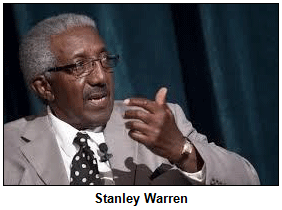 In the Indy suburbs, the Fishers Y opened in 2002 as the first all-new YMCA facility in the metro area in more than 40 years.
In the Indy suburbs, the Fishers Y opened in 2002 as the first all-new YMCA facility in the metro area in more than 40 years.
The CityWay Y under construction is expected to be the largest Y in central Indiana, both in size and membership. In addition to the pools, basketball courts, running track and yoga studio, it will include a teaching kitchen, a cycling studio and a working garden on the roof.
Learn more:
Roadtrip: Seven Pillars and Miami Nation of Indiana
Guest Roadtripper Andrea Neal, a teacher and writer, suggests we visit the Seven Pillars southeast of Peru in Miami County along the Mississinewa River. Seven limestone pillars jut from the water, creating the appearance of a cliff with rounded buttresses and alcoves. In the Miami language, this place is called aašipehkwa waawaalici, meaning "caves in the cliff," and continues to be a site of importance for the Miami Nation of Indiana, which owns a 37-acre parcel of land on the other side of the river.
To the extent Indiana is still "land of the Indians," the Seven Pillars formation is its spiritual center.
Since 1897, however, the Miami have been fighting to gain back their political identity. An administrative decision by assistant attorney general Willis Van Devanter - since conceded by the federal government to have been based on erroneous application of the law - cost the Miami of Indiana their status as a federally recognized tribe. They've tried almost every legal avenue to to get it back.
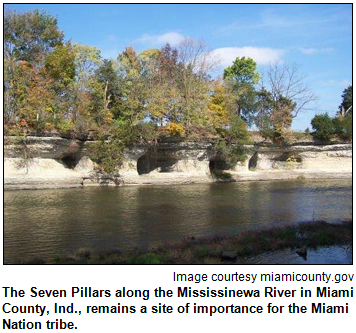 "We're not giving up," declares Chief Brian Buchanan. "Our people are as upset now as they were 100 years ago."
"We're not giving up," declares Chief Brian Buchanan. "Our people are as upset now as they were 100 years ago."
In 1978, the Department of the Interior set up a new process for acknowledging Indian tribes. The Miami applied for recognition but were denied on grounds there was a gap in proof of the existence of a continuous tribal community with functioning political system since the 1940s. The Miami challenged the ruling in court without success. They've also asked Congress for legislation restoring their tribal rights but so far have not found enough members of the Indiana delegation to champion the cause.
Buchanan says members will continue to do what they can through the political system to win back their tribal recognition. Just as important are the cultural activities that distinguish them as Native Americans. One recent effort has been to revive the dormant Miami language. Also, their annual powwow near Rockville gives the public a chance to experience native customs and music. As Indiana celebrates its bicentennial, the Miami want Hoosiers to know they are alive and well and dedicated to preserving their culture into the future.
The Seven Pillars is accessible to the public and is stewarded by Acres Land Trust. Here are the directions for getting to this landmark on foot, and please be respectful, as this is a sacred place.
You can also follow Andrea Neal's "Indiana at 200" on social media at https://www.facebook.com/IndianaAt200 or at @IndianaAt200.
History Mystery
|
In 1894, the YMCA in Crawfordsville may have been the setting for a historic "first" in Indiana. That is, the first event of its kind in the state.
Recently, research by some historians has questioned the accuracy of this "first" claim in terms of Crawfordsville.
They contend the "first" may have happened at a YMCA in Indianapolis or Evansville. But for generations of Hoosiers, the Y in Crawfordsville has been associated with the historic "first" for Indiana that happened in 1894.
Question: What was it?
The prize pack includes a family 4-Pack to Conner Prairie, including four tickets for the 1859 Balloon Voyage, courtesy of Conner Prairie, as well as coupon for Bee Coffee Roasters, courtesy of Visit Indy.
Insects and Indiana
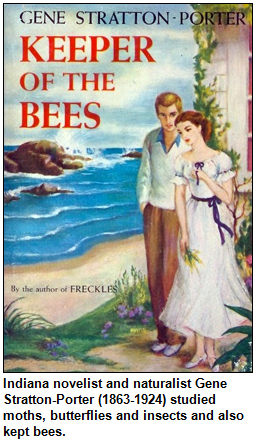 (June 20, 2015) - With summer in full swing, Hoosier History Live will cover the waterfront regarding our insect heritage in a show certain to create plenty of buzz.
(June 20, 2015) - With summer in full swing, Hoosier History Live will cover the waterfront regarding our insect heritage in a show certain to create plenty of buzz.
Topics for this show range from which insects were here - and which ones were not - when pioneers arrived in the 1800s to advice related to the increasing popularity of beekeeping in urban and suburban neighborhoods.
We also explore the invasive beetle that has been decimating ash trees across the state.
Our expert guest is none other than the founder of the annual Bug Bowl at Purdue University.
He is Tom Turpin, a professor of entomology and a popular, witty public speaker. In his talks, Dr. Turpin shares tips about:
- How to avoid irritating insects.
- The insect that Native Americans called "the white man's fly."
- And whether moths, cockroaches, hornets, wasps, gnats, spiders and other such critters were native to Indiana.
His Bug Bowl, which Dr. Turpin began as a creative activity for his students in 1990, has drawn international media coverage and has expanded to include the general public in the West Lafayette area and far beyond.
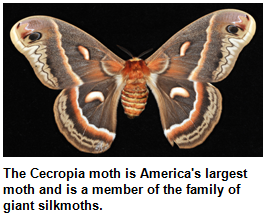 Events include cockroach racing and cricket spitting contests. (The cockroaches compete on a ramped track with Plexiglas. Their racetrack is known as Roach Hill Downs.) The Bug Bowl also features exhibits of honey bees, food cooked with insects and an insect petting zoo.
Events include cockroach racing and cricket spitting contests. (The cockroaches compete on a ramped track with Plexiglas. Their racetrack is known as Roach Hill Downs.) The Bug Bowl also features exhibits of honey bees, food cooked with insects and an insect petting zoo.
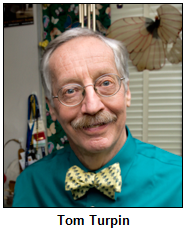 On a more serious note, Dr. Turpin shares insights during our show about the emerald ash borer, a beetle that has been killing ash trees across Indiana and elsewhere.
On a more serious note, Dr. Turpin shares insights during our show about the emerald ash borer, a beetle that has been killing ash trees across Indiana and elsewhere.
Recent news reports have described extensive damage to ash trees in Logansport and surrounding areas of Cass County. But ash trees in all areas of the state have been affected by the beetle, which is not native to Indiana.
"Unfortunately, a lot of the 'pest insects' are ones that have been introduced over the decades," Dr. Turpin reports.
During our show, Dr. Turpin also discusses the opposite situation: insects that may be vanishing from Indiana.
He recently explored that issue in a column, titled "On Six Legs," that he writes for the Purdue Extension. His recent column focused on questions from Hoosiers who have been wondering why they no longer see large, colorful moths - commonly known as giant silkworm moths - that they recall from childhood. Unlike many moths, giant silkworm moths are brightly colored and have "conspicuous eye spots," Dr. Turpin notes.
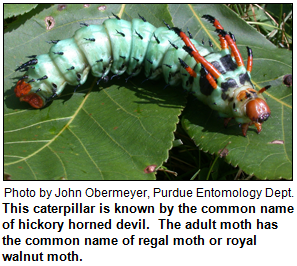 During our show, he shares insights about whether the distinctive moths are indeed less populous in Indiana. He also discusses which spiders found in Indiana are dangerous and which are harmless.
During our show, he shares insights about whether the distinctive moths are indeed less populous in Indiana. He also discusses which spiders found in Indiana are dangerous and which are harmless.
In addition, Dr. Turpin assesses the early studies of moths in Indiana by naturalist Gene Stratton-Porter, the author of best-selling books including The Girl of the Limberlost (1909). Her collections of moths are displayed at her Limberlost Cabin, an Indiana State Historic Site in northeastern Indiana.
Dr. Turpin, a native of Kansas, has lived in Indiana since the early 1970s.
Teaser alert: He says most insects with stinging capabilities are not deliberately aggressive with people. Tune in to find out how to avoid angering them.
Learn more:
- Purdue Extension, "On Six Legs" Podcast archive.
- Purdue Press, Tom Turpin, "Flies in the Face of Fashion, Mites Make Right, and other Bugdacious Tales".
- Purdue Press, Tom Turpin, "What's Buggin' You" .
- Purdue Extension, Tom Turpin, "Vanishing Moths".
History Mystery
 A famous Hoosier was trained as a zoologist and started his career by studying wasps. Some of his research focused on their mating habits.
A famous Hoosier was trained as a zoologist and started his career by studying wasps. Some of his research focused on their mating habits.
Later, he became a household name for a different kind of research, some of it quite controversial. He died in 1956.
Question: Who was he?
The prize pack includes a gift certificate to the Rathskeller, courtesy of Visit Indy, and two passes to the IMAX Theater, courtesy of the Indiana State Museum.
Roadtrip:Pine Hills Nature Preserve
|
Our guest Roadtripper and film historian Eric Grayson tells us that "this Saturday's Roadtrip is a little off the beaten path, on purpose." It's Pine Hills Nature Preserve, near Waveland, Ind.
Pine Hills is part of Shades State Park, but it has some special Indiana history to it. Eric recommends going early in the morning to take in the scenery, with the birds, creeks and cliffs.
"The cliffs are spectacular, and the trails take you over each one," Eric tells us. "The most famous is The Devil's Backbone. This is a rock formation about six feet wide, but on either side is a sheer dropoff of more than 100 feet. At the top, you'll find graffiti from as far back as the 1840s."
Eric continues: "After hiking around for a long day, you'll probably be hungry. If you're in the mood for some home-town cooking, try going to the Cozy Corner in Waveland, which is a great little place. Waveland is also the boyhood home of artist T.C. Steele."
If you're more in the mood for a State Park experience, Shades doesn't have an Inn, but nearby Turkey Run does, and the food there, says Eric, is excellent.
Flag of Indy, anthem, 'Indiana' movie and other symbolism
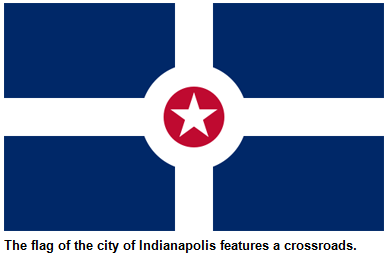 (June 13, 2015 - encore presentation) - With Flag Day about to unfold on June 14, here's a timely question: Did you know the city of Indianapolis has an official flag?
(June 13, 2015 - encore presentation) - With Flag Day about to unfold on June 14, here's a timely question: Did you know the city of Indianapolis has an official flag?
You won't confuse it with the official state of Indiana flag, which has a torch and a burst of 19 stars symbolizing the Hoosier state as the 19th to enter the Union. Gold and dark blue are the predominant colors on the state flag, which is well known.
The obscure flag representing the Hoosier capital has a white cross and a lighter shade of blue, with a white star in the middle of a red circle. To explore the city and state flags as well as other symbols, Nelson is joined on this show by a beloved historian who occasionally wears a lapel pin depicting the Indy flag. On this encore broadcast of one of the most popular shows in our Hoosier History Live archives (its original air date was June 21, 2014), our guest is George Geib, who retired in 2014 after a long career as a distinguished professor of history at Butler University.
During our show, Professor Geib and Nelson explore products created to tout the Hoosier state and its capital city, in addition to the seldom-seen city flag. If you want to catch the flag of Indianapolis in action - flapping in the summer breeze - visit the City-County Building. Along with the American flag, the city flag flies on a pole in the courtyard on the south side of the 28-story office tower.
Professor Geib and Nelson also share details about a silent movie, titled Indiana, produced in 1916 in connection with the celebration of the Centennial of Indiana's statehood.
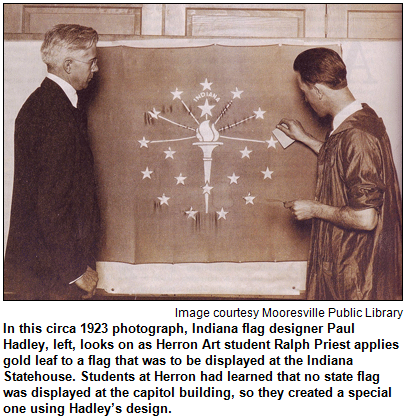 The state flag also was an outgrowth of the Centennial. As part of the celebrations in 1916, the General Assembly called for the adoption of a state flag. The Daughters of the American Revolution sponsored a contest to select the winner. Mooresville artist Paul Hadley created the winning design.
The state flag also was an outgrowth of the Centennial. As part of the celebrations in 1916, the General Assembly called for the adoption of a state flag. The Daughters of the American Revolution sponsored a contest to select the winner. Mooresville artist Paul Hadley created the winning design.
The flag for the city of Indy, on the other hand, was created in 1962 by Roger Gohl, then an 18-year-old freshman at the Herron School of Art.
In addition to discussing the flags during our show, Professor Geib shares insights about a song that some sources used to claim was an official anthem of Indianapolis.
As for Indiana, the silent movie made in 1916: It featured footage of Hoosier poet James Whitcomb Riley surrounded by children on the lawn of the Lockerbie residence now known as the James Whitcomb Riley Museum Home. Riley, who was in declining health during the filming, died later in 1916.
Learn more:
- "Indiana 1916" footage (watch).
- "More Indiana 1916" footage (watch).
- "Lockerbie Street 1916" (watch and listen).
- Indiana State Symbols.
This and that
Meet host Nelson Price on June 16
(June 2015) - Our host, Nelson Price, will kick off the Indiana Historical Society summer author series with a presentation at noon on Tuesday, June 16, about his newest book, The Quiet Hero: A Life of Ryan White. The talk is free and open to the public. The Eugene and Marilyn Glick Indiana History Center is at 450 W. Ohio Street in Indianapolis and has its own parking lot just north of the building.
People are encouraged to bring their own lunches - or to purchase food from the Stardust Terrace Cafe - for the presentation. No RSVP is needed. And if you have another of Nelson's books, feel free to bring it for him to sign.
![]()
Hoosier History Live wishes to thank our new Tweeter, Robin Knop! Don't forget to follow us on Facebook and Twitter. Our intrepid producer Molly has (sort of) figured out Facebook, but she says learning one social media platform per decade is quite enough!
Quilting heritage
(June 6, 2015) - Quilts have been part of the fabric of Hoosier heritage since the state's beginnings nearly 200 years ago.
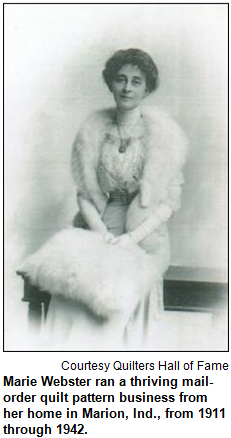 So it's high time Hoosier History Live explored all aspects of quilting, from the influences of pioneers, Amish and Mennonite groups to myths about the Underground Railroad and quilts; appraising and storing quilts, and the modern and art quilt movements.
So it's high time Hoosier History Live explored all aspects of quilting, from the influences of pioneers, Amish and Mennonite groups to myths about the Underground Railroad and quilts; appraising and storing quilts, and the modern and art quilt movements.
During our show, we also explore revivals of the quilting that unfolded during the 1920s - a Hoosier entrepreneur became known as the top national expert of quilting then - as well as a revival under way in connection with Indiana's upcoming Bicentennial in 2016. At the Indiana State Museum, a special exhibit, 19 Stars: Quilts of Indiana's Present and Past, opens June 13. It features a collection of contemporary and historic quilts, including some that date to the late 1830s or early 1840s.
Nelson is joined in studio by Mary Jane Teeters-Eichacker, curator of social history at the state museum, where she oversees a collection of more than 700 quilts. They include an internationally known collection of Amish quilts from Indiana called the David Pottinger Collection.
Other guests on our show include Elizabeth Bollinger Braun, a professional quilt appraiser and quilt collector. Although Elizabeth lives in Indianapolis, she grew up on a farm in northern Indiana near Amish communities. She attributes her interest in quilts to her German, Pennsylvania Dutch and Mennonite family heritage.
In addition to Mary Jane and Elizabeth, Nelson is joined by Judy Pleiss of Indianapolis, who has created one of the quilts that will be exhibited at the state museum. Judy describes herself as "hooked" on quilting since the U.S. Bicentennial in 1976; she has taken classes from renowned quilters and has studied fabric-art techniques.
As many quilting enthusiasts across the country know, the Quilters Hall of Fame can be found in Indiana. It's in Marion - specifically, in the restored home of 1920s quilting entrepreneur Marie Webster, who drew widespread acclaim for her innovative designs. The author of the first book about American quilting history, Marie Webster (1859-1956) ran a mail-order quilting business from her home, which is a National Historic Landmark. She is credited with inspiring a national revival in quilting during the 1920s.
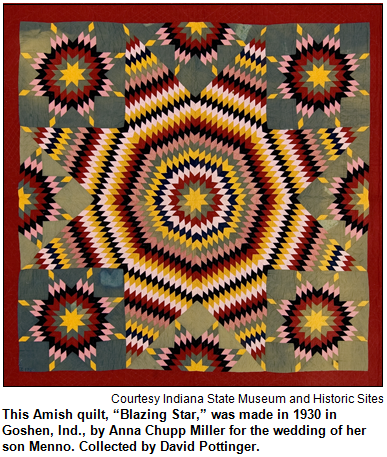 Today, many Hoosier quilt artists have been inspired by the upcoming Indiana Bicentennial to create quilts with themes featuring 19 stars. That's because Indiana became the 19th state in 1816.
Today, many Hoosier quilt artists have been inspired by the upcoming Indiana Bicentennial to create quilts with themes featuring 19 stars. That's because Indiana became the 19th state in 1816.
According to our guest Mary Jane Teeters-Eichacker, the inclusion of stars in patterns also was a favorite of quilters during the 1800s and 1900s.
Contemporary quilters represented in the state museum's upcoming exhibit live in such Indiana cities as Crawfordsville, Anderson, Noblesville, Gas City, Newburgh and Indianapolis.
At the National Quilt Museum in Paducah, Ky., our guest Elizabeth Braun has studied quilt dating and appraisal; we explore both topics during our show. Elizabeth, a clinical nurse specialist and a legal nurse consultant, was taught to sew by her mother, a professional tailor. She has won several state and local awards for needle crafts.
Our guest Judy Pleiss, who formerly worked at a quilt shop in Carmel, reports that she keeps informed about developments in quilting via the Internet. Over the years, she has developed her own style and techniques.
"I continue to love traditional quilts, but am not really interested in making them in the traditional way," she says. "I love bright and exuberant color, am inspired by the beauty of the natural world, and find improvisational work exhilarating."
Learn more:
History Mystery
 Amish residents account for about 12 percent of the population of a county in northern Indiana.
Amish residents account for about 12 percent of the population of a county in northern Indiana.
The county has such a deep Swiss heritage that some of its best-known towns were named in honor of cities in Switzerland. The population of Amish in the county - which is not LaGrange or Elkhart counties - is growing because of the large size of Amish families, which have an average of seven children.
In recent years, a glockenspiel (clock tower) has been built in the county, modeled after Swiss clock towers.
Question: What is the county in northern Indiana?
Hint: The northern Indiana county also has an Indiana State Historic Site. It's the historic home of a famous author, naturalist and photographer who died in 1924.
The prize pack includes a family 4-Pack to Conner Prairie, including four tickets for the 1859 Balloon Voyage, courtesy of Conner Prairie, as well as two discounted tickets to Segway of Indiana White River State park tours, courtesy of Visit Indy.
Roadtrip: Knightstown
|
Guest Roadtripper William Selm suggests a quick trip east of Indianapolis on the Old National Road to the town of Knightstown, which is perhaps most famous its Hoosier Gym, which served as the home court for the Hickory Huskers in the movie 1986 movie "Hoosiers".
Jubilee Days in Knightstown occurs in mid-June, and the Hoosier Fall Fest is in September. Hear more on Saturday!
Roadside motels: bygone Americana
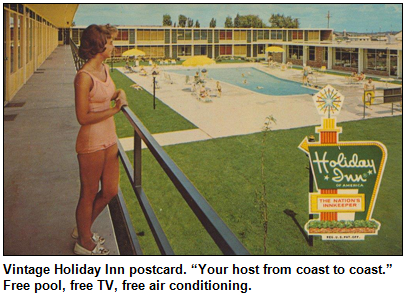 (May 30, 2015) - Remember the motels, cabin courts and other lodging spots that were so familiar on pre-interstate highways?
(May 30, 2015) - Remember the motels, cabin courts and other lodging spots that were so familiar on pre-interstate highways?
Many bit the dust long ago, but Hoosier History Live explores their heyday - as well as their decline - just as many folks hit the road for vacations. During our show, we even explore still-familiar chains such as Holiday Inn. But our focus is on the bygone style and architecture familiar to motorists from the 1940s through the '70s, rather than the type operated by the international conglomerate today.
Our studio guests include Jeff Kamm, who recently shared insights about former roadside Holiday Inns in the Indy metro area in an article for Historic Indianapolis.
Jeff, a graduate of Purdue's hospitality and tourism management program, worked for 10 years managing various hotels in the Indy area; today, he is the operations manager for the International Center.
Jeff and Nelson are joined by Joan Hostetler, founding director of the Indiana Album, who also collaborated with Nelson on the visual history book Indianapolis Then and Now and related projects; aspects of our heritage that Joan has extensively researched include roadside architecture.
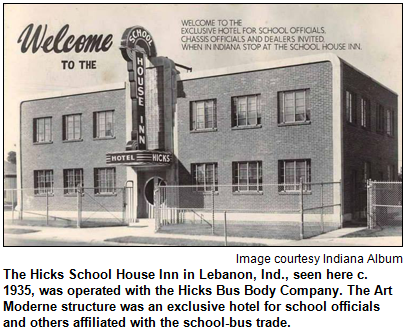 Certainly the design of many roadside motels and hotels was distinctive, such as the orange and blue appearance associated with Howard Johnson Motor Lodge chain. According to our guest Jeff Kamm, the first Howard Johnson Motor Lodge opened in 1954 in Savannah, Ga.
Certainly the design of many roadside motels and hotels was distinctive, such as the orange and blue appearance associated with Howard Johnson Motor Lodge chain. According to our guest Jeff Kamm, the first Howard Johnson Motor Lodge opened in 1954 in Savannah, Ga.
About 30 years before that, towns during the 1920s began establishing free "auto camps" as Americans took to the roads with the boom in car ownership, Jeff notes.
Prior to - and sometimes simultaneously with - the evolution of the roadside motel came lodging spots that consisted of cabins for overnight guests clustered around a check-in office. They were known as tourist cabins or cabin courts.
According to Jeff's research, by 1956 about 500 roadside motels were scattered across Indiana. Along U.S. 40 across Indiana that year, there were 120 of the motels.
Jeff's track record in the hospitality industry includes managing properties in the Marriott and Radisson families of hotels.
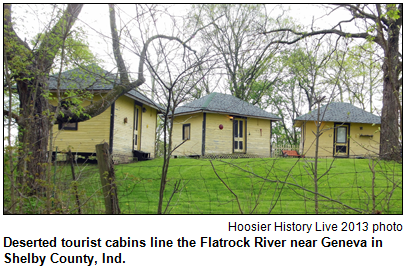 The first Holiday Inn in the Indy area opened in 1960 "across from the main gate of the area's biggest attraction, the Indianapolis Motor Speedway," Jeff writes in his historicindianapolis.com article. The Holiday Inn in Speedway featured the neon green sign that became such a common sight across Indiana and the rest of the country.
The first Holiday Inn in the Indy area opened in 1960 "across from the main gate of the area's biggest attraction, the Indianapolis Motor Speedway," Jeff writes in his historicindianapolis.com article. The Holiday Inn in Speedway featured the neon green sign that became such a common sight across Indiana and the rest of the country.
His article notes that the oversized neon signs and some other once-standard features of Holiday Inns have vanished as the chain evolved.
"Drivers may recently have noticed a pile of rubble on U.S. 31 immediately south of the I-465 interchange," Jeff writes. "This is the last reminder of the Holiday Inn in the Circle City in its traditional incarnation."
In recent years, many former roadside motels across Indiana - particularly those that were locally owned - have been converted into apartments or lodging spots with extended-stay occupancies.
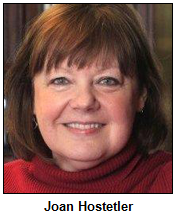 Remnants of a few auto camps or tourist cabins remain across Indiana, including in Hendricks County, according to our guest Jeff Kamm, who grew up in Plainfield.
Remnants of a few auto camps or tourist cabins remain across Indiana, including in Hendricks County, according to our guest Jeff Kamm, who grew up in Plainfield.
Early auto camps sprang up along the Lincoln Highway in northern Indiana during the 1920s near cities such as Elkhart and Columbia City.
 Along the National Road (U.S. 40), the cabins could be found near cities such as Richmond and Cambridge City.
Along the National Road (U.S. 40), the cabins could be found near cities such as Richmond and Cambridge City.
According to Jeff, developers began building connected cabins (thereby saving on materials), which kicked off the era of the motel as the most popular roadside lodging spot. In 1946, Best Western created a "membership association" of motels.
After the opening in Indianapolis of the first Holiday Inn on West 16th Street near the speedway, the chain quickly built several other motels in the Hoosier capital. By 1967, Jeff reports, there were seven Holiday Inns in Indy, including one on Pendleton Pike and another near the site then of the city's airport.
Some of these original Holiday Inn buildings became a Motel 6 or a Classic Motor Inn before being razed. The former Holiday Inn site near the old airport, Jeff reports, "now operates as the more upscale Crowne Plaza."
Learn more:
- Cabin Camp Project, Indiana Lincoln Highway.
- Jim Grey, National Road in Western Indiana.
- Jeff Kamm, Historic Indianapolis, At Your Leisure, a Lost Roadside Beacon.
- National Road to Route 40.
- 1934 classic movie "It Happened One Night" with Clark Gable and Claudette Colbert, great auto camp scenes.
- Motelpostcardsblogspot.
History Mystery
It was not a roadside motel. Instead, it was a historic hotel with a heritage in Rushville that dated to the 1800s. For several generations in the 1900s, it become one of the best-known lodging spots in Indiana.  In 1940, the hotel even served as the headquarters for Indiana native Wendell Willkie's presidential campaign against Franklin D. Roosevelt.
In 1940, the hotel even served as the headquarters for Indiana native Wendell Willkie's presidential campaign against Franklin D. Roosevelt.
Owned beginning in the 1920s by generations of a family in Rushville, the hotel - which took on the family's name - became a popular overnight spot for motorists traveling between Indianapolis and Cincinnati. Sugar cream pie served in the hotel's dining room had scores of enthusiasts across the state. For many decades, the hotel also served as a major social venue for events in Rush County and surrounding counties.
Although the hotel in Rushville eventually was converted into apartments, the building is listed on the National Register of Historic Places.
Question: Name the former hotel.
The prize pack is a gift certificate to Cunningham Restaurant Group and two tickets to the Indianapolis Zoo, courtesy of Visit Indy.
Roadtrip: Concerts on the Canal in downtown Indy
|
Guest Roadtripper Katie Keesling of the Indiana Historical Society tells us that Thursday nights are heating up in downtown Indianapolis for another exciting summer of Concerts on the Canal, presented by MainSource. The 2015 lineup on the Kruse Family Stardust Terrace includes Endless Summer Band, Gregg Bacon and Living Proof.
All shows are from 6 to 8 p.m., with the Fourth of July Celebration from 5 to 9:30 p.m. Free and reserved seating is available. The Indiana Historical Society will be setting up cornhole bag-toss games across the canal for the grass sitters!
And, thanks to Citizens Energy Group, the History Center is free all day Thursdays until 8 p.m. during concert season.
Ernie Pyle and John Bartlow Martin, journalists
|
(May 23, 2015) - One of the most acclaimed war correspondents of the 20th century was killed 70 years ago. Another journalist became the dominant writer for the popular "big slick" magazines of the 1940s and '50s.
Both Ernie Pyle, a native of the tiny town of Dana in far western Indiana, and John Bartlow Martin, who grew up in Indianapolis, also wrote about Hoosiers.
During our show about the lives and careers of these two iconic journalists, Hoosier History Live focuses on what they wrote about their home state. 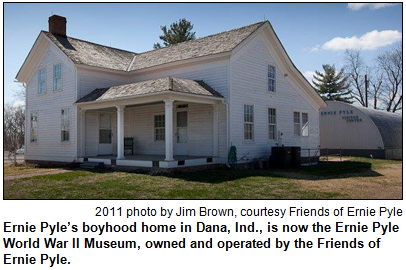 Particularly in the case of Martin (1915-87), it wasn't always flattering.
Particularly in the case of Martin (1915-87), it wasn't always flattering.
Nelson is joined in studio by two authors of books about the journalists:
- Owen Johnson of Bloomington, an IU associate professor emeritus who spoke last month at a ceremony commemorating the 70th anniversary of Pyle's death. The ceremony was in Honolulu, where Pyle's remains were taken after he was assassinated by a Japanese sniper during the final days of WW II. Next winter, IU Press will publish a book, At Home with Ernie Pyle, that Owen edited; it will include all of Pyle's columns about Indiana and Hoosiers.
- And Ray Boomhower of the Indiana Historical Society. He's the author of a new biography, John Bartlow Martin: A Voice for the Underdog (IU Press). Ray, a frequent guest on Hoosier History Live, has written several other books, including The Soldier's Friend: A Life of Ernie Pyle (IHS Press, 2006) and Robert F. Kennedy and the 1968 Indiana Primary (IU Press, 2008).
After his career as a magazine writer, Martin became a speechwriter and close adviser to Democratic politicians, including Bobby Kennedy.
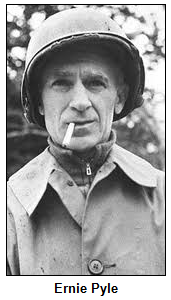 Pyle, a Pulitzer Prize winner, rotated among the various branches of the military during WWII, shivered in foxholes and joined U.S. troops fighting in North Africa, Europe and the Pacific. He had attended IU, where he was editor of the campus newspaper, but he dropped out before graduating to work at a newspaper in LaPorte.
Pyle, a Pulitzer Prize winner, rotated among the various branches of the military during WWII, shivered in foxholes and joined U.S. troops fighting in North Africa, Europe and the Pacific. He had attended IU, where he was editor of the campus newspaper, but he dropped out before graduating to work at a newspaper in LaPorte.
Martin, who endured what he described as an unhappy childhood, attended DePauw University and was expelled after wild behavior. Eventually, he returned to earn his diploma and went on to be a star writer for the Saturday Evening Post, Life, Harper's, Look and other magazines.
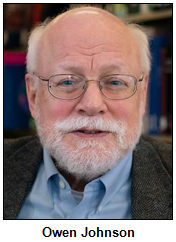 Martin's books included Indiana: An Interpretation (1947), which, according to Ray's biography, some conservative bookstores in the Hoosier state refused to sell.
Martin's books included Indiana: An Interpretation (1947), which, according to Ray's biography, some conservative bookstores in the Hoosier state refused to sell.
Pyle, on the other hand, almost always enjoyed huge, popular success with his writing. His columns were appearing in 400 daily newspapers and 300 weeklies when he was killed. He was portrayed by Burgess Meredith in the movie The Story of G.I. Joe (1945).
The only child of sharecroppers, Pyle was born near Dana, where the Ernie Pyle World War II Museum celebrates his achievements. During our show, Owen Johnson shares insights about Pyle's days at IU, where he was a manager of the football team and crusaded to get smoking permitted on campus.
Owen also discusses Pyle's attendance at the Indianapolis 500 and his various return visits to his home state after he became famous. Before World War II, Pyle was a roving, human-interest columnist for the Scripps-Howard newspaper syndicate. 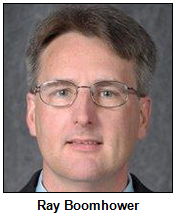 Often filing stories as "The Hoosier Vagabond," he reported everywhere from Chesapeake Bay in Maryland to Good News Bay in Alaska.
Often filing stories as "The Hoosier Vagabond," he reported everywhere from Chesapeake Bay in Maryland to Good News Bay in Alaska.
As for John Bartlow Martin: He grew up in a hard-scrabble neighborhood on the near eastside of Indianapolis and graduated from Tech High School. For much of his magazine-writing career, he was based out of the Chicago area. Martin gained national attention for his expose about a coal mining explosion and often wrote about historic murders. He also wrote an investigative series about the Teamsters and the labor union's powerful leader, Jimmy Hoffa, a native of Brazil. Ind.
Martin is credited with helping coin the phrase "vast wasteland" in the early 1960s to describe TV. In addition to helping Bobby Kennedy, Martin wrote speeches for public figures such as Newton Minow (who used the "wasteland" phrase in a famous speech) and Adlai Stevenson.
Learn more:
- Ernie Pyle World War II Museum.
WIBC on 70th anniversary of Ernie Pyle's death.
Library of Congress, John Bartlow Martin Papers.
History Mystery
|
Another Indiana-born journalist became famous during more than 50 years that she was based in Paris.
The journalist, who was born into a prominent Indianapolis family in 1892, wrote columns, profiles and vignettes that were published in The New Yorker magazine and often packaged as "Letters From Paris."
Her profile subjects included Pablo Picasso and Charles de Gaulle; during the 1930s, she also wrote dispatches about Hitler's rise to power. Her friends included Ernest Hemingway, F. Scott Fitzgerald and Dorothy Parker.
The journalist, who seldom returned to Indianapolis, died in 1978. Her colorful life and career were the focus of a Hoosier History Live show in 2009.
Question: Who was she?
The prize pack is a gift certificate to Rick's Cafe Boatyard and two passes to the President Harrison Presidential Site, courtesy of Visit Indy.
Roadtrip: Middlebury in northern Indiana
|
Guest Roadtripper and food and travel writer Jane Ammeson suggests a Roadtrip to the small town of Middlebury in northern Indiana.
"If you want to experience genuine Midwestern Americana," Jane tells us, "this is it."
Pastoral scenes of Amish life and fields of gold line the Pumpkinvine Nature Trail. And the Essenhaus Restaurant features a classic car cruise-in each Thursday night from May through September.
Quilt gardens throughout Amish County can be seen by taking the 90-mile Heritage Trail Driving Tour that winds through all of Amish County in northern Indiana. The tour includes a free audio driving tour that can be downloaded to your cell phone.
Another well-known attraction in Middlebury is the Krider "World's Fair" Garden, on Bristol Street by the Greenway Park. It is a community park, open every day from sunup to sundown. The town long was home to a thriving mail-order business, Krider Nurseries, which brought home much of an elaborate display at Chicago's 1933 Century of Progress exhibition - including the giant mushroom in the park.
What's in our State Archives?
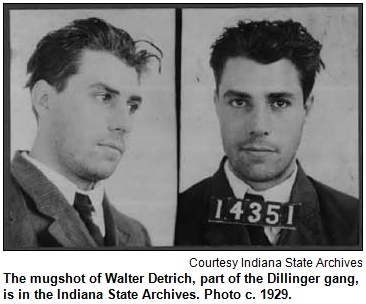 (May 16, 2015) - They are where you can find mug shots from the Department of Correction dating to the 1880s. The prison and reformatory records of notorious bank robber John Dillinger.
(May 16, 2015) - They are where you can find mug shots from the Department of Correction dating to the 1880s. The prison and reformatory records of notorious bank robber John Dillinger.
And the original Indiana State Constitution drafted in 1816, plus the new constitution of 1851.
The Indiana State Archives are the trove for all of that, as well as much more.
But most of the priceless documents, records and photos are not in climate-controlled areas. They are in a warehouse so antiquated the Indiana General Assembly has approved construction of a new state archives building. According to a recent story in the Indianapolis Business Journal, possible sites in downtown Indianapolis include one on the Central Canal near the Eugene and Marilyn Glick Indiana History Center.
To explore all of this, Nelson is joined in studio by:
- Indiana State Archivist Jim Corridan. He also is the director of the Indiana Commission on Public Records and the former deputy state librarian.
- And Stephen Towne, president of the Friends of the Indiana State Archives. He is an archivist at the IUPUI University Library.
Since 2001, the state archives have been kept in a warehouse at 6440 E. 30th St. in Indianapolis.
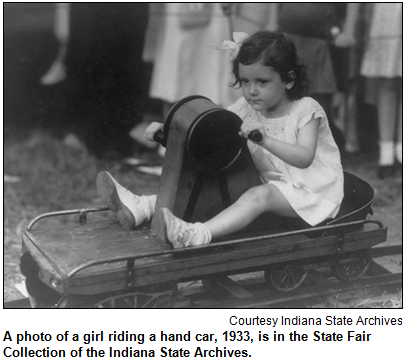 In addition to the state constitutions, Dillinger prison records and DOC mug shots, the archives have extensive records documenting the Civil War.
In addition to the state constitutions, Dillinger prison records and DOC mug shots, the archives have extensive records documenting the Civil War.
Our guest Steve Towne, the author of several books and articles about the Civil War, says the surviving records from the administration of Gov. Oliver P. Morton (the state's governor during the 1860s) "are probably better and fuller than those for any other Northern state governor." 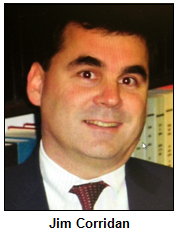 Steve's newest book, Surveillance and Spies in the Civil War (Ohio University Press, 2015), is about U.S. Army espionage operations in the Midwest to detect anti-government conspiracies.
Steve's newest book, Surveillance and Spies in the Civil War (Ohio University Press, 2015), is about U.S. Army espionage operations in the Midwest to detect anti-government conspiracies.
The state archives also house registries for "negroes and mulattos" from the 1850s; the 1851 state constitution required such registries.
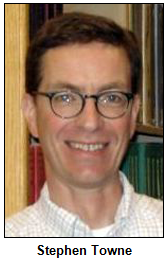 In addition to documents and photos, digital archives are maintained by the state archives.
In addition to documents and photos, digital archives are maintained by the state archives.
During our show, we explore the range - and condition - of the various historic records, as well as the pros and cons of possible sites for the archives building. The warehouse on the eastside was intended as a temporary repository when the archives were moved there nearly 15 years ago.
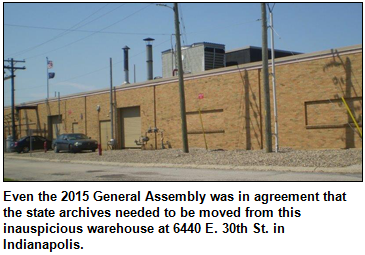 The first state constitution in 1816 was prepared in Corydon, Indiana's first capital, by delegates who often met under elm trees. It decreed Indiana would not be a slave state.
The first state constitution in 1816 was prepared in Corydon, Indiana's first capital, by delegates who often met under elm trees. It decreed Indiana would not be a slave state.
"The 1816 constitution is the single most important document in Indiana's history," acclaimed historian James Madison writes in his book Hoosiers: A New History of Indiana (IU Press, 2014).
During the 1840s, a major financial crisis in the Hoosier state - blamed in part on spending to build canals - prompted calls for another constitutional convention. The 1851 constitution prohibited overspending.
In addition to housing the constitutions, the state archives include Indiana Supreme Court decisions and the Indiana prison and reformatory records of Dillinger (1903-1934), who became known as "Public Enemy No. 1" during the Great Depression. Dillinger was born in Indianapolis, but his family moved to a farm near Mooresville when he was a teenager. He spent much of his young adulthood at the Indiana State Reformatory in Pendleton and the Indiana State Prison in Michigan City.
Learn more:
- Indiana Digital Archives.
- Indiana State Archives.
- Friends of the Indiana State Archives.
- Gov. Oliver P. Morton Telegraph Books and Slips.
History Mystery
John Dillinger, whose prison and reformatory records are housed at the Indiana State Archives, robbed banks in five states during the 1930s. His largest haul came from a robbery in October 1933 of a bank in an Indiana town. With three gang members, Dillinger, who had recently escaped from a jail in Lima, Ohio, robbed the bank of about $75,000. The bank building was on the courthouse square of the Indiana town.
Question: What is the town?
The prize pack is a gift certificate to Beef & Boards Dinner Theatre, courtesy of Visit Indy, and a family pass to Conner Prairie, courtesy of Conner Prairie.
Roadtrip: Hesston Steam Museum in La Porte
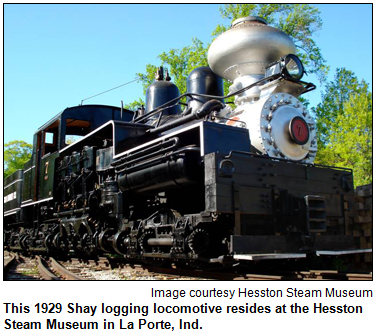 Our Guest Roadtripper is Ted Rita, general manager of the Hesston Steam Museum in La Porte in northwestern Indiana. This is the place for you if you love steam engines! You can ride the museum's one-quarter scale and one-eighth scale steam railroads that meander over bridges and through an enchanting wooded landscape. You can even enjoy a special treat at Doc's Soda Fountain.
Our Guest Roadtripper is Ted Rita, general manager of the Hesston Steam Museum in La Porte in northwestern Indiana. This is the place for you if you love steam engines! You can ride the museum's one-quarter scale and one-eighth scale steam railroads that meander over bridges and through an enchanting wooded landscape. You can even enjoy a special treat at Doc's Soda Fountain.
The Hesston Steam Museum is filled with all kinds of steam power machinery, including a steam-powered saw mill, a railroad steam crane, and a steam-powered electric power plant. The museum opens Memorial Day weekend on Saturday, May 23, with fun for the entire family.
Back in a week!
Probable pre-emption May 9
(May 7, 2015) - The University of Indianapolis softball team has qualified for the NCAA tournament, which involves rounds of playoff games on Saturday (May 9). WICR-FM will be broadcasting the Greyhounds action live, so we expect Hoosier History Live to be pre-empted.
Please rejoin us May 16, when we expect to return with a fresh, live show.
Abe Martin's creator, Kin Hubbard
|
(May 2, 2015) - "You can take a voter to th' polls, but you can't make him think."
"When a feller says, 'it hain't the money, but th' principle o' th' thing,' it's the money."
"Now an' then, an innocent man is sent to th' legislature."
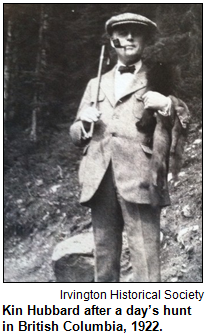 Do these quips sound as relevant today as they did a century ago? If so, that's testament to the talents of one of Indiana's best-known cartoonists - and the enduring appeal of his nationally syndicated character.
Do these quips sound as relevant today as they did a century ago? If so, that's testament to the talents of one of Indiana's best-known cartoonists - and the enduring appeal of his nationally syndicated character.
Abe Martin, the cracker-barrel philosopher who "lived" in Brown County, appeared in more than 300 newspapers across the country in the early 1900s. Will Rogers praised his creator, Indianapolis-based cartoonist Frank McKinney "Kin" Hubbard, as "America's greatest humorist" when he died.
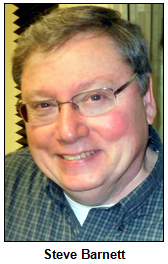 To explore the life and career of Kin Hubbard (1868-1930) - and the impact of his folksy Abe Martin character - Nelson will be joined in studio by Steve Barnett, executive director of the Irvington Historical Society.
To explore the life and career of Kin Hubbard (1868-1930) - and the impact of his folksy Abe Martin character - Nelson will be joined in studio by Steve Barnett, executive director of the Irvington Historical Society.
For most of the peak years of his career, Hubbard lived in the Irvington neighborhood on the eastside of Indy. A memorial to the cartoonist is at the corner of East New York Street and Emerson Avenue; at the memorial's dedication, Steve met Hubbard's son.
Hubbard placed his pipe-smoking, suspender-wearing Abe Martin character in Brown County in part because, during the early 1900s, the hilly, isolated county had one of the state's highest poverty and illiteracy rates. So the notion that a rustic Brown County resident could be a font of wisdom was considered humorous.
In the decades after the cartoonist's death, Brown County State Park dedicated a memorial to the cartoonist, and the rustic Abe Martin Lodge opened.
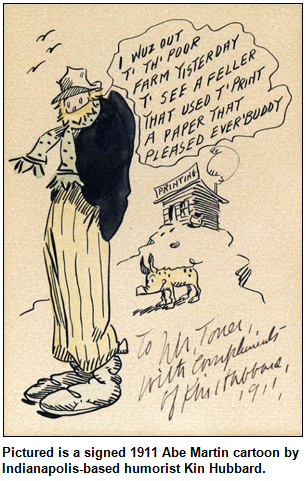 Abe Martin made his first appearance in 1904 in The Indianapolis News, Hubbard's "home" newspaper. Hubbard was born in Bellefontaine, Ohio, and dropped out of school there before the seventh grade.
Abe Martin made his first appearance in 1904 in The Indianapolis News, Hubbard's "home" newspaper. Hubbard was born in Bellefontaine, Ohio, and dropped out of school there before the seventh grade.
More than 25 books of Abe Martin's witticisms eventually were published.
Hubbard's fans ranged from peers like Will Rogers to contemporary-era notables such as our guest Steve Barnett's former boss, the late Andy Jacobs. The longtime congressman from Indianapolis, who died in 2013, had an extensive collection of Abe Martin books and memorabilia.
A further sampling of Abe Martin quips:
"It's no disgrace to be poor, but it might as well be."
"We'd all like to vote fer th' best man, but he's never a candidate."
"T' err is human, but t' admit it haint."
Quips like those became so popular across the country that Kin Hubbard and his wife, Josephine, moved into a posh North Meridian Street mansion for the final year of his life - an ironic abode for the creator of a bumpkin character. In 1930, Hubbard died suddenly of a heart attack at the peak of his success at age 62.
Another irony: Hubbard had seen Brown County only once - during a brief train ride - in the first few years of the Abe Martin cartoon.
"He was in no rush to go again, for he had learned the natives thought he was making fun of them and did not always approve of the kind of characters he created," according to The Life and Times of Kin Hubbard by Fred C. Kelly (Farrar, Straus and Young, 1951). "A visit, he feared, might be embarrassing, even dangerous."
Fortunately, Brown County residents welcomed the cartoonist during his periodic road trips. Sadly, though, the Hubbards endured a tragedy during a car ride elsewhere in Indiana with their infant son, Kin Jr., in 1919. Their car broke down, slid down an embankment and plunged into a creek. The baby was pinned beneath the car and drowned.
Although the cartoonist was said to be affected forever by the tragedy, the output of his humor continued at a steady pace. By the time of his death, Hubbard had written more than 8,000 Abe Martin quips.
|
History Mystery
 A well-known quip -
"What this country needs is a really good five-cent cigar" - typically is attributed to a famous Hoosier political figure of the early 1900s. Many historians, though, believe the quip may have originated with Kin Hubbard's folksy Abe Martin character.
A well-known quip -
"What this country needs is a really good five-cent cigar" - typically is attributed to a famous Hoosier political figure of the early 1900s. Many historians, though, believe the quip may have originated with Kin Hubbard's folksy Abe Martin character.
The politician usually credited with the remark about five-cent cigars was known for his wit. He served as governor of Indiana before being elected to a national office. He died in 1925.
Question: Who was he?
The call-in phone number is (317) 788-3314, and please do not try to win the prize if you have won any prize from WICR during the past two months. Please do not call in to the show until Nelson has posed the question on the air.
The prize pack is a gift certificate to On Golden Pond at the Indiana Repertory Theatre and a gift certificate to Cadillac Ranch restaurant, courtesy of Visit Indy.
Roadtrip: Glory's road to Hope
|
Guest Roadtripper Glory-June Greiff tells us about the "surprising little town" of Hope, less than 50 miles southeast of Indianapolis on SR9 in northeastern Bartholomew County.
"The town square is charming, and only a few steps away is the Yellow Trail Museum , open weekends only," Glory tells us. "There are also several unusual shops on the square. Hungry? Try the Corner Café on the southwest corner of the square, one of those iconic small-town cafes with attached walkup ice cream stand. Or perhaps your tastes might run to Auntie Amiee's Country Tea Room on the north side of the square, open for lunch six days a week."
Preservationists will love the historic commercial buildings and residences; Hope was founded in 1830 by Moravians, and some pre-Civil War structures still survive. An 1837 cabin was moved from two miles east of town to a lot across SR9 from the Corner Cafe. Art and artisan enthusiasts will enjoy the Haw Creek Heritage Center, a branch of the Bartholomew County Historical Society. It's southeast of downtown at 111 Aiken Street, next to the fire station.
Jam-packed!
Book-launch events draw plenty of interest
(April 2015) - With the launch of The Quiet Hero, A Life of Ryan White, author Nelson Price, the host of Hoosier History Live, is making a string of public appearances to promote the book.
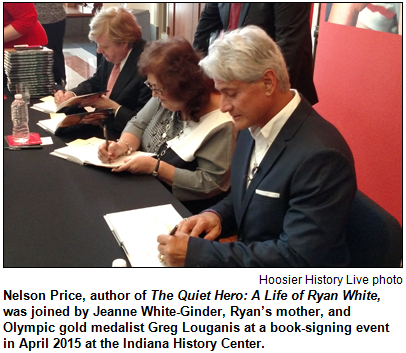 The big book-launch event on April 1 at the Indiana Historical Society was a great success, with a full house of history fans there to buy books and get them signed by Nelson, along with Jeanne White-Ginder and Olympic diver Greg Louganis, who drew inspiration from Ryan White.
The big book-launch event on April 1 at the Indiana Historical Society was a great success, with a full house of history fans there to buy books and get them signed by Nelson, along with Jeanne White-Ginder and Olympic diver Greg Louganis, who drew inspiration from Ryan White.
Hoosier History Live salutes our host for his continuing success as an author!
In the news:
- Fox 59 video interview with Nelson, White-Ginder and Louganis.
- WRTV-6 news video about Nelson's book and the signing event.
- Nuvo newsweekly - "New Ryan White biography emphasizes his coping skills."
Buy the book:
- The Quiet Hero, A Life of Ryan White - Hardcover. 151 pages. IHS Press. $17.95.
HIV history in Indiana
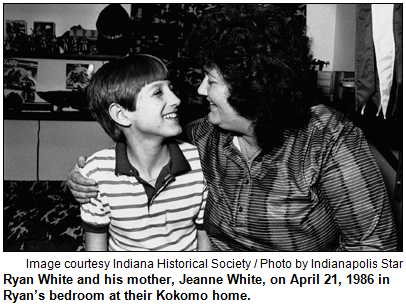 (April 25, 2015) - The current HIV outbreak in Scott County, which is drawing national attention to the county in southeastern Indiana, provides our show an opportunity to set in historic context the virus that causes AIDS.
(April 25, 2015) - The current HIV outbreak in Scott County, which is drawing national attention to the county in southeastern Indiana, provides our show an opportunity to set in historic context the virus that causes AIDS.
So Hoosier History Live explores the history, from the beginnings of the HIV/AIDS epidemic in the early 1980s, including early efforts to educate people about the virus. According to the Indiana State Department of Health, more than 10,000 Hoosiers are living with HIV/AIDS today.
Nelson is joined in studio by three expert guests who have been involved in different aspects of HIV awareness, advocacy for victims and education, some of them since the early era of AIDS deaths. His guests are:
- Jeremy Turner, director of support services at the Damien Center. It's a nonprofit that provides support services to those with HIV/AIDS.
- Tonja Eagan, CEO of the Social Health Association of Indiana, Inc. Her organization has sent social workers and other staff members to Scott County to educate teenagers, children and others about HIV amid the current epidemic. At least 130 people in Scott County, primarily residents of the city of Austin (population 4,500), have tested positive for HIV.
 And Paula French, co-founder of Step Up, Inc., an Indianapolis-based nonprofit that promotes health among underserved populations. Step Up assists organizations that provide HIV education.
And Paula French, co-founder of Step Up, Inc., an Indianapolis-based nonprofit that promotes health among underserved populations. Step Up assists organizations that provide HIV education.
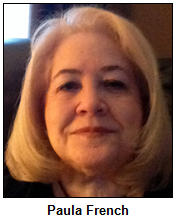 Paula began her career in HIV prevention following the death of her brother in 1994. Tonja's organization, which is nearly 80 years old, began as the Anti-Syphilis League of Indiana in 1937.
Paula began her career in HIV prevention following the death of her brother in 1994. Tonja's organization, which is nearly 80 years old, began as the Anti-Syphilis League of Indiana in 1937.
Awareness of AIDS began, both nationally and across Indiana, during the early 1980s with the deaths of victims, including gay people and hemophiliacs, who were infected as a result of tainted blood transfusions or products used to treat their blood-clotting disorder.
In Scott County, where the outbreak has resulted in front-page coverage by The New York Times, the epidemic has been attributed to needle sharing among intravenous drug users. Calling the situation "a public health emergency," Gov. Mike Pence has authorized a short-term needle exchange program in the mostly rural, economically struggling county.
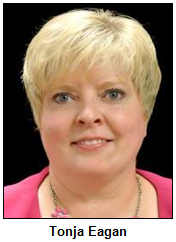 Back in 1981, florist Coby Palmer and others organized the first fund-raising event for HIV/AIDS in Indianapolis during an era when many funeral homes refused to handle AIDS patients. Indy Pride Bag Ladies, an organization that evolved from that event, is considered to be among the country's oldest AIDS fund-raising organizations.
Back in 1981, florist Coby Palmer and others organized the first fund-raising event for HIV/AIDS in Indianapolis during an era when many funeral homes refused to handle AIDS patients. Indy Pride Bag Ladies, an organization that evolved from that event, is considered to be among the country's oldest AIDS fund-raising organizations.
Some of those organizers continue to be involved with Step Up; "step" is an acronym for Services/Training/Education/Prevention. Our guest Paula French, Step Up's co-executive director, has been named an outstanding HIV/AIDS educator by the American Red Cross.
The Damien Center, named in honor of a Catholic priest who delivered compassionate care to people with leprosy, was established in 1987.
Both nationally and in Indiana, 1995 was the peak year for AIDS-related deaths. More than 50,800 people died across the country that year.
In the years since then, AIDS in this country has gone from being an inevitably fatal disorder to a chronic one that can be controlled with treatment plans that include a variety of medications. Even so, experts say the Scott County epidemic emphasizes why vigilance about HIV/AIDS remains crucial.
Learn more:
- The Body, the Complete HIV/AIDS Resource.
- Indiana Historical Society Destination Indiana Journey about HIV/AIDS.
- Indianapolis Star, Containing an HIV Outbreak, 4-22-2015.
- Indiana State Department of Health, HIV Outbreak in Southern Indiana.
|
History Mystery
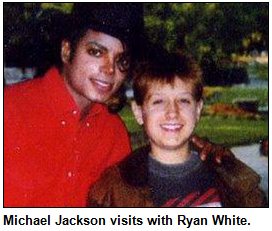 Ryan White, the Kokomo teenager with AIDS who crusaded to attend school during the 1980s, had a prized possession given to him by Michael Jackson.
Ryan White, the Kokomo teenager with AIDS who crusaded to attend school during the 1980s, had a prized possession given to him by Michael Jackson.
The gift from the pop superstar even served as a makeshift memorial for Ryan when he died in April 1990. It was placed on the front lawn of the White family's home in Cicero, where they had moved; notes, flowers and balloons were left by well-wishers next to the gift from Michael Jackson.
Question: What was the gift that Ryan White treasured?
The prize pack is a gift certificate to Story Inn in Brown County, courtesy of Story Inn, and a pair of tickets to the James Whitcomb Riley Museum Home, courtesy of Visit Indy.
Roadtrip: Ruth at Indy Eleven Theatre
|
Guest Roadtripper and writer Rita Kohn will be calling in about her new play Ruth, starring Miki Mathioudakis, which opens on Thursday, April 30, at 8 p.m. at IndyFringe's new Indy Eleven Theatre in downtown Indy at the corner of Massachusetts and College avenues.
Ruth takes place around 968 BCE, when famine was part of life and homeless widows had to find their way to safety with determination, ingenuity and faith.
You will be able to travel treacherous paths from Beth-lehem in Judea, to Moab, and back to Beth-lehem. Judge for yourself the timelessness of the struggles and triumphs of Ruth and her mother-in-law Naomi.
Tickets are available online. Here's an opportunity to see original work by two hometown favorites: playwright Rita Kohn and actress Miki Mathioudakis!
Ask Nelson - and gardener Jo Ellen, too
(April 18, 2015) - To celebrate spring, Hoosier History Live opens the phone lines throughout this show for listeners to call in and ask our host, author/historian Nelson Price, questions about our Hoosier heritage.
As a spring bonus, Nelson is joined by our favorite gardening guru. Jo Ellen Meyers Sharp, an author who writes the popular Hoosier Gardener column featured in The Indianapolis Star, co-hosts the show with Nelson.
 That means listeners were invited to pose any questions under the sun about flowers, plants and other gardening issues to Jo Ellen, who is secretary of the Garden Writers Association and co-author of The Indiana Gardener's Guide.
That means listeners were invited to pose any questions under the sun about flowers, plants and other gardening issues to Jo Ellen, who is secretary of the Garden Writers Association and co-author of The Indiana Gardener's Guide.
In between fielding calls from our listeners, Nelson and Jo Ellen interview each other.
During the show, Jo Ellen shares tips about spring clean-up in gardens, as well as planting tomatoes, peppers, eggplants and other warm-season crops before Mother's Day. She also discusses cool-season annuals (including snapdragons and wallflowers) that can be planted now.
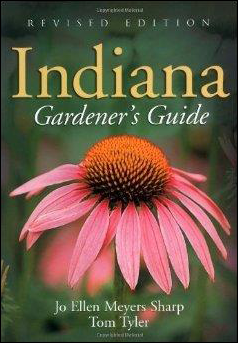 Jo Ellen asks Nelson about his brand-new book, The Quiet Hero: A Life of Ryan White (Indiana Historical Society Press). It's a biography of the Kokomo teenager, a hemophiliac who was infected with the virus that causes AIDS during the 1980s. Ryan became the focus of national attention because of his crusade to attend Western Middle School in nearby Russiaville.
Jo Ellen asks Nelson about his brand-new book, The Quiet Hero: A Life of Ryan White (Indiana Historical Society Press). It's a biography of the Kokomo teenager, a hemophiliac who was infected with the virus that causes AIDS during the 1980s. Ryan became the focus of national attention because of his crusade to attend Western Middle School in nearby Russiaville.
As a newspaper reporter, Nelson covered Ryan's crusade; he was among the media horde on the lawn of the White family's home in Cicero (where they eventually had moved) on April 8, 1990, the day Ryan died. This month's publication of The Quiet Hero coincides with the 25th anniversary of Ryan's death.
Ryan and his mother, Jeanne White-Ginder, also are among the contemporary and historic notables profiled in another book by Nelson, Indiana Legends: Famous Hoosiers from Johnny Appleseed to David Letterman (Hawthorne Publishing).
So our listeners call in with questions about famous Hoosiers ranging from Letterman (who will retire next month as host of NBC-TV's long-running late-night talk show) to Rev. Theodore Hesburgh, the former president of the University of Notre Dame who died earlier this year.
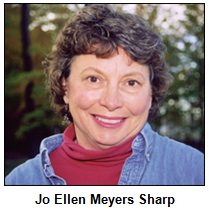 Nelson interviewed Letterman, Rev. Hesburgh, former Indiana Pacer Reggie Miller, TV newswoman Jane Pauley and other famous Hoosiers featured in his book, which is in its 4th edition.
Nelson interviewed Letterman, Rev. Hesburgh, former Indiana Pacer Reggie Miller, TV newswoman Jane Pauley and other famous Hoosiers featured in his book, which is in its 4th edition.
Several of the notables - such as basketball icon Bobby Plump, Hoosiers screenwriter Angelo Pizzo and jazz great David Baker - also have been Hoosier History Live guests. So has Jo Ellen, who most recently joined Nelson for a show last spring about flowers and plants that are native to Indiana.
She has been writing and speaking about gardening for more than 25 years. Jo Ellen also is a garden coach and a landscape consultant. A 25-year veteran of newspaper journalism, she is the author of The Visitor's Guide to American Gardens (Cool Springs Press, 2011) and contributes to Indiana Gardening magazines. Jo Ellen also is a director of the Indianapolis Museum of Art Horticultural Society and, as a speaker, can be reached at GreatGardenSpeakers.com.
During our show, she shares insights about upcoming plant sales, as well as about potential challenges for gardeners with the trend of keeping chickens in backyards, even in urban and suburban neighborhoods.
Her expertise makes for an ideal pairing with Nelson as we put out the welcome mat for listener phone calls.
Roadtrip: Maplelawn Farmstead in Zionsville
|
Guest Roadtripper Bonnie Carter, Zionsville resident and Maplelawn volunteer, suggests a Roadtrip to Maplelawn Farmstead at 9575 Whitestown Road in Zionsville. The farmstead offers an opportunity for visitors to experience a 1920s-30s Depression-era Indiana family farm.
The farmstead dates back to 1835, when it was established by John and Jane Wolf. Heirs sold it to Alfred Elroy and Elmira Moore Scott in 1900, who farmed and maintained the buildings for 65 years. The farmstead remained in the Scott family until the death of Lester Bradley, the surviving spouse of Scott heir, Alyce Scott Bradley, in 2000. In 2003, the land was sold to the town of Zionsville to be developed into a community park.
The Zionsville Historical Society, community volunteers and donors were inspired to form a committee to preserve the farmstead with the house, outbuildings, farm equipment and household items for educational purposes. In 2004 the Zionsville Parks & Recreation Department approved the motion to keep the farmstead as is, and Maplelawn Farmstead, Inc. was born.
Now Zionsville residents and visiting families enjoy programs and activities presented in the rustic barns and house. The land has survived the Depression and drought, revealing stories of survival in those times. Events that interpret the area in the 1920s and early 1930s have included kids' summer camp, classic movies shown on the side of the dairy barn and mystery dinners in the house. Many different groups have held their meetings at the farmstead, surrounded by beautiful gardens and nostalgic farm buildings.
Bonnie suggests we visit maplelawnfarmstead.org to see what's happening this season.
History Mystery
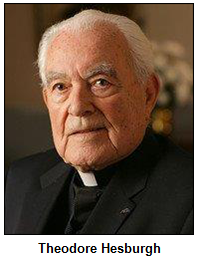 Famous Hoosiers profiled in Indiana Legends, the book by our host, Nelson Price, include Rev. Theodore Hesburgh, the beloved former president of the University of Notre Dame. Rev. Hesburgh, who died in February at age 97, was listed for decades by Guinness World Records for having "the most" of something.
Famous Hoosiers profiled in Indiana Legends, the book by our host, Nelson Price, include Rev. Theodore Hesburgh, the beloved former president of the University of Notre Dame. Rev. Hesburgh, who died in February at age 97, was listed for decades by Guinness World Records for having "the most" of something.
Question: What was it?
The prize pack is two tickets to the Indiana Wine Fair in Brown County on April 25, courtesy of Story Inn, and a pair of tickets to the Indiana State Museum, courtesy of the Indiana State Museum, and a pair of tickets to the NCAA Hall of Champions, courtesy of Visit Indy.
Morel mushrooms, ramps and other foraging foods
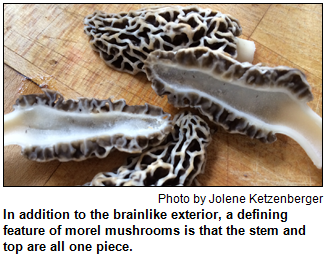 (April 11, 2015) - Not only do foodies salivate about morel mushrooms, those who forage for them across Indiana treasure the delicacies so much they often keep their locations top-secret.
(April 11, 2015) - Not only do foodies salivate about morel mushrooms, those who forage for them across Indiana treasure the delicacies so much they often keep their locations top-secret.
At the dawn of peak morel hunting season, Hoosier History Live delves into the sponge-like mushrooms, as well as other food that involves foraging. On this radio roadtrip (or woods excursion), we explore the hunts for morels, an annual tradition undertaken by generations of families and friends.
Our guests also share insights about how to avoid the unpleasant (even poisonous) varieties of wild mushrooms; how to prepare morels, and just why on earth there is so much frenzy about them.
Nelson is joined by two well-known experts in the central Indiana dining world:
- Becky Hostetter, chef and founder of Duos, which began its journey with food trucks and has expanded to include Duos Kitchen and Duos @ Eskenazi Health. Heralded for her vegetarian cuisine, Becky has led morel-hunting expeditions for decades.
- And food journalist Jolene Ketzenberger, who covers the landscape of the Hoosier culinary scene at EatDrinkIndy. Jolene has accompanied Hoosier chefs as they forage in the great outdoors, including hunts for edible flowers.
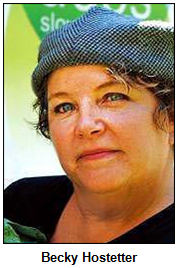 A front-page story last spring in The Indianapolis Star reported on some "morel maniacs" who faced criminal charges for trespassing on private property in Hamilton County. The rare mushrooms sometimes can be sold for $50 per pound.
A front-page story last spring in The Indianapolis Star reported on some "morel maniacs" who faced criminal charges for trespassing on private property in Hamilton County. The rare mushrooms sometimes can be sold for $50 per pound.
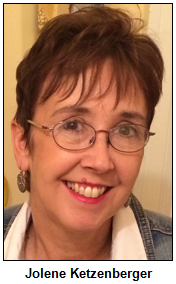 With their distinctive, honeycomb-shaped tops, morels even have achieved their own celebratory festival in Indiana. The third annual Brown County Morel Festival will be April 23-25. Featuring guided hunts, mushroom auctions, classes, live music and crafts, the festival is based at Bill Monroe Music Park and Campgrounds.
With their distinctive, honeycomb-shaped tops, morels even have achieved their own celebratory festival in Indiana. The third annual Brown County Morel Festival will be April 23-25. Featuring guided hunts, mushroom auctions, classes, live music and crafts, the festival is based at Bill Monroe Music Park and Campgrounds.
In addition to morels, Nelson and his guests explore ramps, which are wild leeks, and chanterelles, another type of mushroom cherished by foodies.
Like other mushrooms, morels sometimes are served sautéed and buttered, sometimes battered and fried.
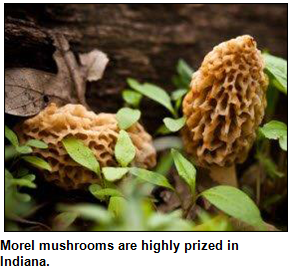 Although morels enjoy most of the hype, more than 2,000 species of mushrooms grow in Indiana, according to several sources. There even are several species of morels. In Indiana, most morels are black or yellow.
Although morels enjoy most of the hype, more than 2,000 species of mushrooms grow in Indiana, according to several sources. There even are several species of morels. In Indiana, most morels are black or yellow.
A serving of fun facts:
- Hunting season for morels only lasts about one month. Morels are among the first mushrooms to come up when winter ends.
- According to The Indianapolis Star account about the "morel maniacs" who trespassed on private property, mushrooms that are discovered in state parks, recreational areas and other state-owned land may be picked by hunters. (Ditto for berries, nuts, fruits and greens.) In a state park, Hoosiers also can leave an official trail to forage.
- The flavor of ramps typically is likened to onions or garlic.
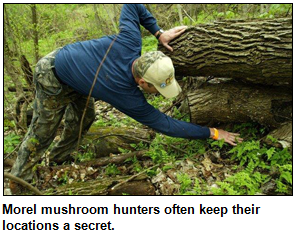 Our guest Becky Hostetter grew up near Bloomington and began her morel-hunting adventures with her mother. Before launching Duos, Becky owned Essential Edibles, a vegetarian restaurant, with her husband, David, for 10 years.
Our guest Becky Hostetter grew up near Bloomington and began her morel-hunting adventures with her mother. Before launching Duos, Becky owned Essential Edibles, a vegetarian restaurant, with her husband, David, for 10 years.
Our guest Jolene Ketzenberger has covered the Hoosier culinary scene for more than 20 years. Her food journalism has appeared in Indianapolis Monthly, NUVO Newsweekly, Indianapolis Business Journal and the Indianapolis Star. Last August, she joined Nelson for a Hoosier History Live show about pork tenderloins, persimmon pudding, sugar cream pie and other Hoosier heritage food.
Learn more:
Roadtrip: New Deal murals in Covington
|
Guest Roadtripper Terri Gorney of Fort Wayne, who also volunteers at several conservation organizations, including ACRES, DNR and Limberlost, suggests a Roadtrip to Covington in Fountain County in the central western part of the state.
The Art Deco Fountain County Courthouse and its interior art collection of New Deal murals once were described by the by Indianapolis Star as "the most significant example of a New Deal art and architecture in Indiana." The courthouse was constructed during 1936-1937 with Indiana limestone, and its architects were Louis R. Johnson of Covington and Walter Scholer of Lafayette.
And the impressive array of New Deal murals the inside of the courthouse make it seem more like an art museum than a government building. Much of the work is by Covington native Eugene Savage, who created the first murals under the Works Projects Administration in 1937. Savage was also strongly influenced by Thomas Hart Benton, and as he became well-known he directed other local artists in the painting of additional murals for the courthouse that reflect the county's history from the early 1800s to 1940. The murals cover more than 2,500 square feet of wall.
Terri also points out that Covington has ties to Lew Wallace. Wallace's mother is buried in the local cemetery, and the Fountain County clerk's building served as his first law office. And the Lew Wallace Museum and Study is a short 30 minutes away in Crawfordsville.
Learn more:
History Mystery
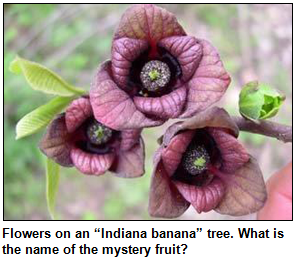 An unusual type of fruit has been nicknamed the "Indiana banana." The fruit, which is light green and ripens in the fall, grows wild on trees that have the same name as the fruit.
An unusual type of fruit has been nicknamed the "Indiana banana." The fruit, which is light green and ripens in the fall, grows wild on trees that have the same name as the fruit.
Its flavor has been compared to a cross between a banana and a mango. Although the trees can be found in many Eastern, Midwestern and Southern states, several varieties are thought to have originated in Indiana, accounting for the "Indiana banana" nickname. Even so, the trees - which have maroon-colored flowers - are not as common as persimmon trees, which bear fruit also identified with the Hoosier state.
Question: What is the unusual fruit known as the "Indiana banana"? Note: our "foodie" guests are not eligible to answer this one!
The prize pack is two tickets to the Indiana Wine Fair in Brown County on April 25, courtesy of Story Inn, and a pair of tickets to the Indianapolis Symphony Orchestra, courtesy of Visit Indy.
Donald Davidson on Clark, Carnegie and more
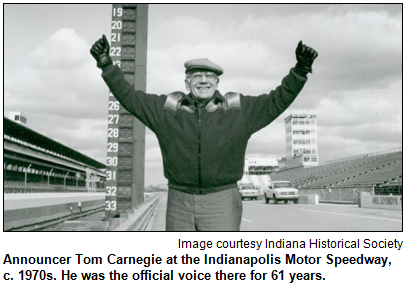 (April 4, 2015) - Fifty years ago, the Indianapolis 500 was won by one of the most popular drivers in history.
(April 4, 2015) - Fifty years ago, the Indianapolis 500 was won by one of the most popular drivers in history.
In fact, legendary broadcaster Tom Carnegie once confided to our host Nelson that Scotland native Jimmy Clark, who was killed during a race three years after his triumph in 1965 at the Indianapolis Motor Speedway, was one of his two favorite drivers.
To share insights about Clark, Carnegie and other aspects of the Speedway's colorful history, a "walking encyclopedia" is our guest. Speedway historian Donald Davidson joins Nelson in studio.
A native of England who became obsessed with the Speedway as a boy overseas, Donald showed up at the race track in 1964 and instantly wowed Hoosiers with the depth of his 500 Mile Race trivia. In addition to Donald's arrival in 1964, Jimmy Clark (who had captured Rookie of the Year honors the previous year) was the leader at one point during the 500, although the race ultimately was won by A.J. Foyt.
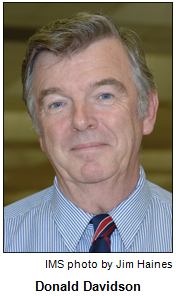 Also during the 1964 race, another popular driver, Eddie Sachs, was killed during a horrific seven-car accident. Sachs, by the way, was the other driver whom Tom Carnegie identified to Nelson as his all-time favorite.
Also during the 1964 race, another popular driver, Eddie Sachs, was killed during a horrific seven-car accident. Sachs, by the way, was the other driver whom Tom Carnegie identified to Nelson as his all-time favorite.
"He was a showman, just like me," Carnegie (referring to Sachs) told Nelson, whose profile of the "Voice of the 500" is the cover story of the current issue of Traces of Indiana and Midwestern History, the magazine published by the Indiana Historical Society.
Our guest Donald Davidson is quoted throughout the article about Carnegie, who died in February 2011. Beginning with his first gig as the track announcer for the Indy 500 in 1946, Carnegie, Nelson writes, "went on to announce an astonishing 61 Indianapolis 500s, 12 Brickyard 400 races and six U.S. Grand prix competitions, achieving a broadcasting version of a track record that probably will never be equaled."
Donald Davidson is equally treasured as a Speedway institution. He was a Hoosier History Live guest in March 2011 for a show about the 100th anniversary of the Indianapolis 500, which made its debut in 1911.
This time around, Donald will time-travel 50 years in reverse, to Jimmy Clark's spectacular victory in 1965 at the Indy 500. 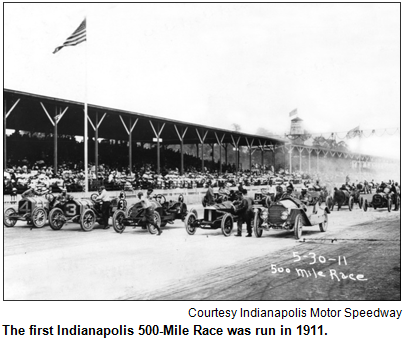 The Scotsman became the first foreign driver since 1916 to win the race, accelerating a "British invasion" that paved the way for subsequent successes by drivers such as Graham Hill and Jackie Stewart.
The Scotsman became the first foreign driver since 1916 to win the race, accelerating a "British invasion" that paved the way for subsequent successes by drivers such as Graham Hill and Jackie Stewart.
In Autocourse Official History of the Indianapolis 500 (CMG Publishing, 2006), which Donald co-wrote with Rick Shaffer, he describes Clark as "shy, polite, driven and adored by the American public." The 1965 race, which Clark led for 190 of the 200 laps, featured "as dominant a performance as ever seen at the Speedway."
Clark, a two-time Formula One champion, was 32 in 1968 when he was killed during a race in Germany.
His rookie year at the Speedway, 1964, also was notable for some famous guests who, four months after the race, stayed at the bygone Speedway Motel. The Beatles bunked there while in town for their legendary concerts at the Indiana State Fairgrounds.
During our show, Donald shares what he knows about the Beatles' visit to the racetrack. Donald reports he enjoyed a chat in 1964 about the Fab Four with Ed Sullivan, the host of the TV variety show that, earlier during the year, introduced the Beatles to the American public. Sullivan also visited the Speedway in 1964.
This Speedway historian extraordinaire, among other honors, has been inducted into the Auto Racing Hall of Fame.
Learn more:
- Hoosier History Live, March 2011 interview with Donald Davidson.
- Indianapolis Motor Speedway, "In Memory of Tom Carnegie."
Roadtrip: 1864 interracial collaboration in Fletcher Place
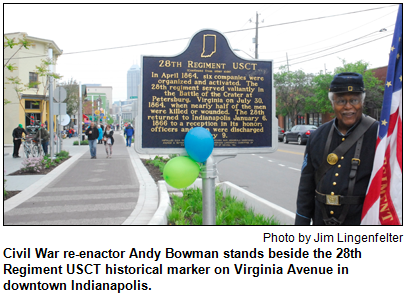 As Indiana continues to address the issue of diversity, Guest Roadtripper Georgia Cravey - a librarian, researcher and independent scholar - tells us that an 1864 interracial collaboration helped to create the formation of the USCT 28th, the only African-American Civil War troops from Indiana. And two historical markers on Virginia Avenue in Indianapolis tell more of the story.
As Indiana continues to address the issue of diversity, Guest Roadtripper Georgia Cravey - a librarian, researcher and independent scholar - tells us that an 1864 interracial collaboration helped to create the formation of the USCT 28th, the only African-American Civil War troops from Indiana. And two historical markers on Virginia Avenue in Indianapolis tell more of the story.
Says Georgia: "Rev. Willis R. Revels, pastor of Bethel AME Church, and Calvin Fletcher, a powerful white local business leader and attorney, were critical to the organization of the USCT 28th. Together the two men convinced Gov. Oliver P. Morton to authorize the enlistment of black Hoosiers in the Union Army."
Revels served as a recruiting officer and as a surgeon for the regiment. Fletcher allowed troops to muster and train on a portion of his Virginia Avenue farm known as Woodlawn. The encampment was dubbed Camp Fremont, named for Gen. John C. Fremont. Details about life in the USCT 28th are available to us thanks to letters exchanged among members of the Trail family, who sent four sons to fight. The troops departed Indianapolis in April of 1864.
History buffs can take an easy stroll on the Virginia Avenue leg of the Indianapolis Cultural Trail in the historic Fletcher Place neighborhood and encounter two state historic markers that document this history. The marker that commemorates the USCT 28th stands at the intersection of McCarty Street and Virginia Avenue near the site of Camp Fremont.
Fletcher's marker stands at the intersection of Virginia Avenue, Fletcher Avenue and East Street.
"Opportunities for refreshments along this portion of the trail are plentiful," says Georgia, "but in keeping with the topic, I recommend a caffeinated beverage from Calvin Fletcher Coffee Shop, a nonprofit operation midway between the two historical markers. You can watch the passing scene on the Cultural Trail or contemplate the Kipp Normand installation in the windows while you sip your latte. The shop is a community gathering spot with an inclusive atmosphere that would make Calvin Fletcher proud."
History Mystery
 Tom Carnegie, the legendary sports broadcaster and track announcer at the Indianapolis Motor Speedway, once told Nelson, our host, that he noticed a transformation in Indy 500 drivers when one particular race driver showed up.
Tom Carnegie, the legendary sports broadcaster and track announcer at the Indianapolis Motor Speedway, once told Nelson, our host, that he noticed a transformation in Indy 500 drivers when one particular race driver showed up.
Unlike drivers of previous eras, whom Carnegie characterized as typically "a rough bunch," this driver had graduated from Brown University and was an accomplished engineer. A native of New Jersey, he competed in his first Indy 500 in 1969. Popular, well-spoken and handsome, he eventually was an Indy 500 champion. Tragically, he was killed in 1975 during practice for a Grand Prix race overseas.
Question: Who was the driver?
The prize pack is two tickets to the Indiana Wine Fair in Brown County on April 25, courtesy of Story Inn, and a pair of tickets to the Indiana State Museum, courtesy of the Indiana State Museum, and a Family 4 Pack to Conner Prairie Interactive History Park, courtesy of Conner Prairie.
A nice comment
Janie reads us 'cover-to-cover'
(2014) - "I read the entire Hoosier History Live e-newsletter each week, cover to cover," says Jane "Janie" Hodge, an Indianapolis educator and former WTTV Channel 4 children's TV personality. "Or, as it is online, I should say top to bottom! I look forward to receiving it."
Who makes the enewsletter? The trio of Nelson Price, Richard Sullivan and Molly Head combine their talents and create it each week. In a world of seemingly increasing mediocrity in media, these three individuals seem to enjoy doing things well.
Interurbans: Their rise and fall across Indiana
(March 28, 2015 - encore presentation) - With mass transit proposals continually in the headlines, consider this:
Interurbans were intercity electric railways popular 100 years ago - and, believe it or not, the Hoosier state had one of the most extensive systems in the entire country. 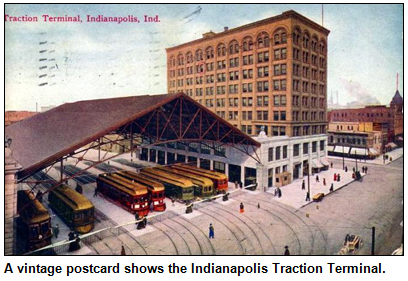 It's the focus of this encore broadcast of one of the most popular shows in our Hoosier History Live archives; the original air date was Sept. 28, 2013.
It's the focus of this encore broadcast of one of the most popular shows in our Hoosier History Live archives; the original air date was Sept. 28, 2013.
Interurban lines connected small towns with most of Indiana's big cities, and the cities with each other. Lines radiated from Indianapolis to Fort Wayne, Louisville, Lafayette, Peru, Terre Haute and Richmond (and six other routes). These interurbans then connected with others, reaching Chicago, Toledo, Columbus and even farther. A separate hub centered on Evansville.
To explore the rise and fall of the interurban system, Nelson is joined in studio by two experts:
- Nathan Bilger, the planning director for the town of Whiteland in Johnson County. Nathan grew up in Columbia City, lives in Greenfield and has extensively researched interurban and railroad lines throughout Indiana. He maintains a website about Indiana railroading.
- Craig Berndt of Fort Wayne, the author of The Toledo and Chicago Railway Company (2007), a book about one of the interurban lines that served travelers in northeastern Indiana, including residents of towns in his home turf of DeKalb County.
The first interurban line in Indiana opened in 1898, from Anderson to Alexandria. The first interurban to Indy opened on New Year's Day in 1900 and brought passengers from Franklin and Greenwood to the Hoosier capital.
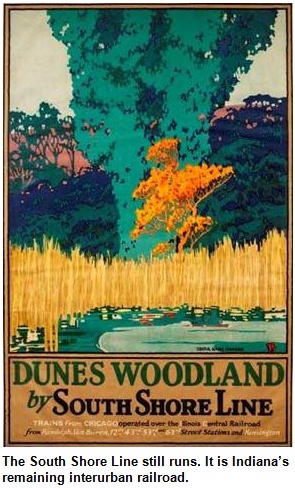 Today, the only remaining passenger interurban in the state - and one of the few left in the country - is the popular South Shore line that links South Bend with Chicago.
Today, the only remaining passenger interurban in the state - and one of the few left in the country - is the popular South Shore line that links South Bend with Chicago.
The bygone Traction Terminal in downtown Indianapolis, which opened in 1904, was easily the nation's largest interurban station. A nine-story building with a train shed, the Traction Terminal was demolished in 1972. The final interurban departed from Indianapolis in September 1941, bound for Seymour.
According to Electric Railroads of Indiana (Hoosier Heritage Press, 1980) by Jerry Marlette, a total of 111 interurban companies had operated more than 3,000 cars in the Hoosier state during the interurban era. Only Ohio had more miles of interurban lines than Indiana's 2,100 miles under wire.
Of Indiana's 92 counties, 68 were served by at least one interurban line. In addition to the massive Traction Terminal in downtown Indy, Muncie was known for its impressive interurban station.
Vestiges of the interurbans do still remain. In southern Marion County, the contemporary names of some streets - Stop 11 Road, for example - date to their heritage as stops on an interurban line.
"Learn more" videos; click to watch and listen:
Roadtrip: Feast of the Hunters' Moon
|
Guest Roadtripper Joan Hostetler of Heritage Photo Services reports on the annual Feast of the Hunters' Moon, which takes place Oct. 3-4 at Historic Fort Ouiatenon Park near West Lafayette, Ind. The annual festival is a re-creation of the annual fall gathering of the French fur traders and Native Americans that took place at the fort in the mid 1700s. Joan says it's a great place to experience the sounds, smells and sights of this era.
Period re-enactors from Indiana and elsewhere participate in this event, attended by thousands, which includes everything from battle re-enactments to musical performances to dozens of booths with goods that are similar to items available during this historic period.
History of Indiana women's prisons
(March 21, 2015) - When the Indiana Women's Prison opened in 1873, it was described as the first state-run women's prison facility in the entire country.
Even before that, though, privately run prisons for women - many of them known as Magdalene Laundries and overseen by orders of Catholic nuns - existed in the Hoosier state and elsewhere.
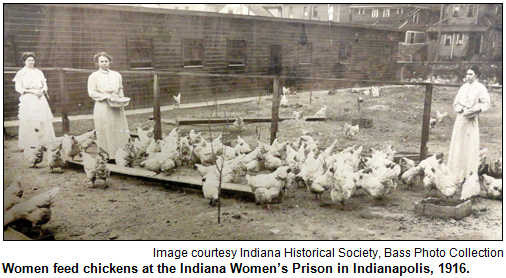 Even during Women's History Month, the heritage of prisons for women is rarely explored. But it is the focus of our show, and it currently is being researched by Hoosier women. They include inmates at the Indiana Women's Prison who have undertaken historic research for college-level classes.
Even during Women's History Month, the heritage of prisons for women is rarely explored. But it is the focus of our show, and it currently is being researched by Hoosier women. They include inmates at the Indiana Women's Prison who have undertaken historic research for college-level classes.
Nelson's studio guests include Kelsey Kauffman, a Greencastle-based instructor who is the volunteer director of the higher education program at the Indiana Women's Prison. In addition to assisting the women in writing a history of their own prison, Kelsey has taught at various colleges, including DePauw University.
She is joined in studio by Steve McCauley, the superintendent of the Indiana Women's Prison, who has had a long career with the Department of Correction.
Nelson and his guests share insights about various historic "firsts" (including a camp that enabled visits by children of inmates) during the last 20 years at the Indiana Women's Prison. For more than 100 years, the prison was located at a site on Randolph Street on the near-eastside of Indianapolis. The women's prison was relocated in 2009 to its current site on the far-westside of Indy (the former site of the Indiana Girls School) because of the need for more space.
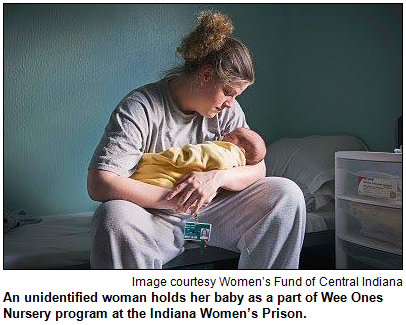 During our show, Nelson and his studio guests are joined by phone by Michelle Jones, an inmate at the women's prison who has been researching - and writing articles for academic and historical publications - about the evolution of punishment for women in Indiana.
During our show, Nelson and his studio guests are joined by phone by Michelle Jones, an inmate at the women's prison who has been researching - and writing articles for academic and historical publications - about the evolution of punishment for women in Indiana.
A current snapshot of the state-run sites, according to DOC statistics:
- At the Indianapolis site, a maximum/medium security facility, the daily prisoner population last year averaged 615 women.
- In Rockville, a correctional facility established in 1970 has an average daily population of 1,225. But officials emphasized that figure is skewed because the Rockville Correctional Facility, in addition to being a medium-security facility, is an intake unit where all women in the prison system are taken for processing.
- At a minimum security correctional facility in Madison, there are about 660 women. The Madison facility opened in 1989.
Before the Indiana Women's Prison opened in 1873, women felons had been detained at early state prisons that also housed male inmates, including one in Jeffersonville. After reports that male guards and others at the Jeffersonville facility were abusing women inmates, Quaker reformers - including Rhoda Coffin and Sarah J. Smith - crusaded for the creation of a separate correctional facility in Indiana for women.
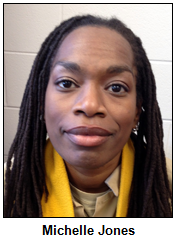 Several Magdalene Laundries already had been established across the country, including one in Indianapolis. Although Magdalene Laundries were privately run (by Catholic organizations), they received women who had been convicted of crimes in county courts.
Several Magdalene Laundries already had been established across the country, including one in Indianapolis. Although Magdalene Laundries were privately run (by Catholic organizations), they received women who had been convicted of crimes in county courts.
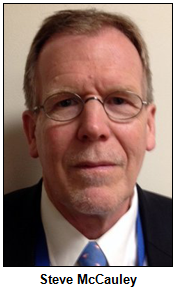 According to an article in the Journal of the Indiana Academy of the Social Sciences co-written by our guest Michelle Jones, Magdalene Laundries primarily housed prisoners who were considered "fallen women." Rather than felons who had been convicted of violent crimes, the women had been convicted of sex-related crimes such as prostitution.
According to an article in the Journal of the Indiana Academy of the Social Sciences co-written by our guest Michelle Jones, Magdalene Laundries primarily housed prisoners who were considered "fallen women." Rather than felons who had been convicted of violent crimes, the women had been convicted of sex-related crimes such as prostitution.
Historic research indicates the women were forced to perform "arduous physical labor," particularly scrubbing laundry amid grim conditions. The model was an initial Magdalene Laundry in Ireland that became infamous.
For all of the 20th century, the Indiana Women's Prison was located on a 15-acre site at Randolph Street. According to DOC spokesman Doug Garrison, portions of the buildings at the site are more than 100 years old. Since the move of the women’s prison in 2009, the Randolph Street site has housed low-risk male inmates transitioning to the work force.
Current programs at the women's prison include Wee Ones Nursery (WON), in which some inmates may keep their babies on a 24/7 basis in a specialized housing unit. Other programs include instruction from community volunteers in literacy and parenting.
Our guest Kelsey Kauffman, who has visited more than 80 prisons, is the author of Prison Officers and Their World (Harvard University Press, 1988). Our guest Michelle Jones has undertaken extensive historic research; during the show, Michelle explains how she was able to accomplish that while in prison.
Learn more:
- Michelle Jones, Women's Prison History: The Undiscovered Country, Feb. 2015.
- Michelle Jones, Lori Record, Magdalene Laundries, The First Prisons for Women in the United States.
- Kelsey Kauffman, Academia in Prison, Feb. 2015.
History Mystery
|
The country's oldest Catholic liberal arts college for women is in Indiana. Its heritage dates to the 1840s, when a group of pioneer Catholic nuns came to the Indiana wilderness. Their leader established an academy for girls that became the liberal arts college for women.
Question: What is the Indiana college?
The call-in phone number is (317) 788-3314, and please do not try to win the prize if you have won any prize from WICR during the past two months. Please do not call in to the show until Nelson has posed the question on the air.
The prize pack is two tickets to the Indiana Wine Fair in Brown County on April 25, courtesy of Story Inn, and a pair of tickets to the Indiana State Museum, courtesy of the Indiana State Museum, and a pair of tickets to the Benjamin Harrison Presidential Site, courtesy of Visit Indy.
Roadtrip: Camp Dellwood on Indy's west side
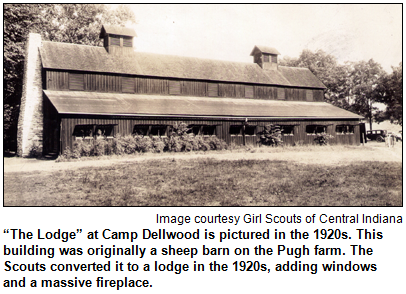 Guest Roadtripper Suzanne Stanis of Indiana Landmarks tells us that just minutes west of busy downtown Indianapolis lies an oasis providing outdoor adventure to girls since 1926. Camp Dellwood is tucked into the woods along Girls School Road, where it offers a variety of experiences - from primitive camping to technology workshops.
Guest Roadtripper Suzanne Stanis of Indiana Landmarks tells us that just minutes west of busy downtown Indianapolis lies an oasis providing outdoor adventure to girls since 1926. Camp Dellwood is tucked into the woods along Girls School Road, where it offers a variety of experiences - from primitive camping to technology workshops.
The original Marion County Girl Scout camp, known as Camp Ada Boyd Holliday, was located at 75th Street and College Avenue beginning in 1922. It moved to the Girls School Road address when the Indiana School for the Blind constructed its new campus along College Avenue. Dorothy Dell Moffat, a Girl Scout and college student at the time, donated $30,000 to purchase land on the west side of Indianapolis from the Pugh family estate.
150 girls attended the first summer camp. The nearby Girls School provided drinking water for the campers. The girls swam in nearby Eagle Creek until Booth Tarkington led a campaign to build a swimming pool that opened in 1929.
Today, Camp Dellwood thrives year-round with camps and a Math & Science Center. The Girl Scouts of Central Indiana celebrate Camp Dellwood's 90th anniversary in 2016 and look forward to the construction of a new Leadership and Learning Center near the camp at 21st Street and Girls School Road.
- Learn more: Vintage Girl Scout Camps.
Landmarks across Indiana with Marsh Davis
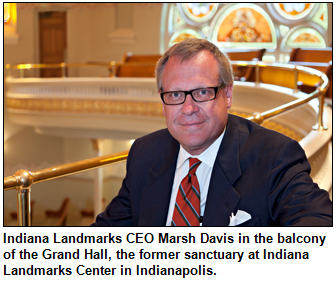 (March 7, 2015) - A former Greyhound bus station in Evansville. A historic German church in Cumberland with an unknown fate that's making headlines.
(March 7, 2015) - A former Greyhound bus station in Evansville. A historic German church in Cumberland with an unknown fate that's making headlines.
The long-ago City Hall of Indianapolis. And a bridge over the Wabash River near New Harmony that spans Indiana and Illinois - and is the focus of governmental squabbling over responsibility for the structure.
Those landmarks are on the "menu" as Nelson welcomes Marsh Davis, president of Indiana Landmarks, the statewide historic preservation organization, as his studio guest.
Some of the landmarks in our spotlight have been featured on past or present 10 Most Endangered lists that Landmarks compiles annually about historic structures across the state whose fates are in jeopardy.
With other landmarks, an ideal (or practical) use for them - including the majestic, 105-year-old building that served as City Hall in Indy until the 1960s - has been debated for years. This week, city leaders announced the Neo Classical building (at the corner of Alabama and Ohio streets) will become the lobby of a boutique hotel.
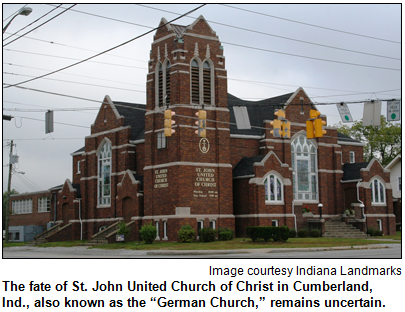 Nelson seeks insights and reactions from Marsh Davis, a native Hoosier who has led Landmarks since 2006. For years before that, Marsh was a staff member at Landmarks - with an interlude as the leader of historic preservation in Galveston, Texas.
Nelson seeks insights and reactions from Marsh Davis, a native Hoosier who has led Landmarks since 2006. For years before that, Marsh was a staff member at Landmarks - with an interlude as the leader of historic preservation in Galveston, Texas.
Some history nuggets about the various landmarks:
- In Evansville, the Greyhound terminal opened in 1939 and is considered a rare survivor of the bus company's "blue period" in which the exterior matched the color of its buses. In 2007, Greyhound moved out of the terminal, which was designed with curved corners and parallel lines to imply speed and movement.
- St. John's United Church of Christ in Cumberland - a town that straddles Marion and Hancock counties - was built on the National Road (Washington Street) in 1914. The German heritage congregation inspired the name for German Church Road, the cross street. News accounts have been describing the controversy involving the decaying church and its dwindling congregation, which has had various purchase offers for the structure. Historic preservationists have objected, noting potential purchasers would demolish it.
- Harmony Way Bridge, which was built in the 1930s and leads from historic New Harmony to Illinois. It was declared unsafe and was shut down in 2012. Since then, various state and county commissions - as well as transportation officials - have declined to accept responsibility for the bridge.
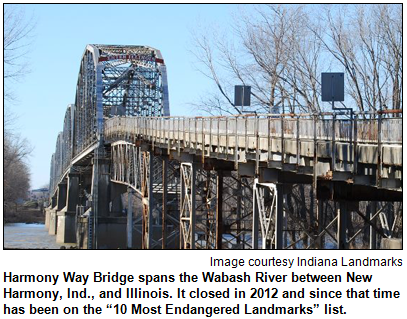 The bridge is included on the current 10 Most Endangered list put together annually by Indiana Landmarks. The organization is headquartered in the former Central Avenue United Methodist Church in the historic Old Northside neighborhood of Indy.
The bridge is included on the current 10 Most Endangered list put together annually by Indiana Landmarks. The organization is headquartered in the former Central Avenue United Methodist Church in the historic Old Northside neighborhood of Indy.
During our show, Marsh Davis also will discuss the evolution of the historic preservation movement in Indiana, including the beginnings of Indiana Landmarks, the largest statewide preservation organization in the country.
Marsh has served on the board of the National Trust for Historic Preservation. He also took the photos for the popular book 99 Historic Homes of Indiana (IU Press, 2002).
Speaking of historic homes: Some in northwest Indiana were designed in the 192os, '30s and '40s by architect and inventor John Lloyd Wright, son of the legendary Frank Lloyd Wright. For many years, John Lloyd Wright (1892-1972) was based in Long Beach, a northern Indiana resort in LaPorte County.
It's where he designed houses and other structures, including the Long Beach Town Hall, which once was on the 10 Most Endangered List. So Marsh and Nelson discuss John Lloyd Wright's work during our show, as well as the Evansville bus station, New Harmony bridge and other landmarks.
Hoosier History Live history fact: For a show on March 30, 2013, we explored houses across Indiana designed by Frank Lloyd Wright. You can listen to audio of that show right from our website.
|
History Mystery
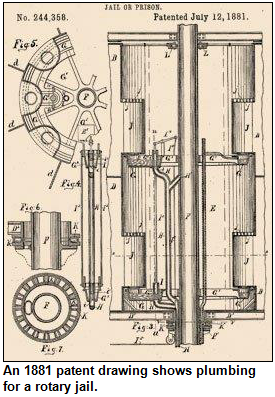 In an Indiana city, one of the best-known historic landmarks is an extremely unusual jail built in the early 1880s. The jail, the first of its kind in the country, was built with cells that revolve on a turntable. By rotating a hand crank on which the turntable pivoted, a jailer could bring one of the cells - shaped like slices of a pie - to the opening.
In an Indiana city, one of the best-known historic landmarks is an extremely unusual jail built in the early 1880s. The jail, the first of its kind in the country, was built with cells that revolve on a turntable. By rotating a hand crank on which the turntable pivoted, a jailer could bring one of the cells - shaped like slices of a pie - to the opening.
The rotary jail fell out of favor by 1930, though, for several reasons. Its revolving cell block was considered unsafe because prisoners could not be evacuated quickly in case of fire.
Closed long ago as the county jail, the building was placed on the National Register of Historic Places in 1975 because of its unique design. Now a museum, it is considered the only operational rotary jail structure - with a cell block that still spins - in the entire country.
Question: Name the city or county in Indiana where the landmark is located.
The prize pack is a gift certificate to Friday's in downtown Indianapolis, courtesy of Visit Indy, and a pair of tickets to the Indiana State Museum, courtesy of the Indiana State Museum.
Roadtrip: That Ayres Look
|
Guest Roadtripper Amy Lamb suggests you step into a world of business and fashion with the Indiana Historical Society's newest exhibit, You Are There: That Ayres Look, which will open March 14 as the latest addition to the Indiana Experience at the Eugene and Marilyn Glick Indiana History Center at 450 W. Ohio St. in downtown Indianapolis.
L.S. Ayres and Company spent more than a century catering to the needs of Hoosiers - and capturing their hearts along the way.
Through augmented reality, original items, videos and other graphics, guests will enjoy a multifaceted illustration of the company, its people and its innovations. They can also interact with costumed actors representing historical real-life characters from 1959, such as owner Lyman Ayres II, Ayres Fashion Bureau director Elizabeth Patrick and Ayres model Bea Fatout.
Guests also will be able to listen to stories of several people connected to Ayres who are still alive today and have shared their experiences in their own words.
By the way, you can listen here to the podcast of the Hoosier History Live show about L.S. Ayres and Company that originally aired on Jan. 13, 2013.
Reflections of World War II veterans
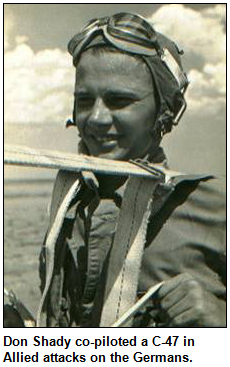 (Feb. 28, 2015) - At least once per year, Hoosier History Live tries to showcase the remembrances of Hoosiers who survived World War II.
(Feb. 28, 2015) - At least once per year, Hoosier History Live tries to showcase the remembrances of Hoosiers who survived World War II.
This year, our focus will be on veterans from northeastern Indiana. Nelson's guests include a 93-year-old Army veteran from Fort Wayne who was involved in the Battle of the Bulge and a 90-year-old Bluffton veteran of the Army Air Corps who helped Polish people freed from a concentration camp.
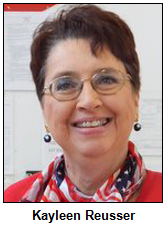 Both veterans are profiled in World War II Legacies: Stories of Northeast Indiana Veterans (Oak Creek Publishing), by Kayleen Reusser, an author based in Bluffton. Kayleen, who has interviewed more than 75 veterans of World War II, joins Nelson in studio.
Both veterans are profiled in World War II Legacies: Stories of Northeast Indiana Veterans (Oak Creek Publishing), by Kayleen Reusser, an author based in Bluffton. Kayleen, who has interviewed more than 75 veterans of World War II, joins Nelson in studio.
So does Bob Foster of Fort Wayne, who was among the thousands of Allied troops who arrived in Normandy, France, in mid-June 1944 for the Battle of Cherbourg. Six months later, he fought in the Battle of the Bulge, one of the war's most brutal conflicts.
Our guest Don Shady of Bluffton was a pre-med major at Indiana University before enlisting in the Army Air Corps. He co-piloted a C-47 in Allied attacks on Germans, then he was part of a rewarding event at war's end. His crew transported Polish prisoners of war - who had been liberated - back to their homeland from German-held territory.
Kayleen's book features the stories of veterans of the Marines and Navy, as well as the Army and Army Air Corps. A middle school librarian who has written 12 children's books, she profiles veterans from Wells, Allen, Adams, Huntington and Whitley counties in World War II Legacies.
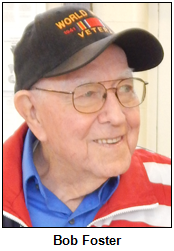 Referring to Bob Foster's arrival for the Battle of Cherbourg, she writes:
Referring to Bob Foster's arrival for the Battle of Cherbourg, she writes:
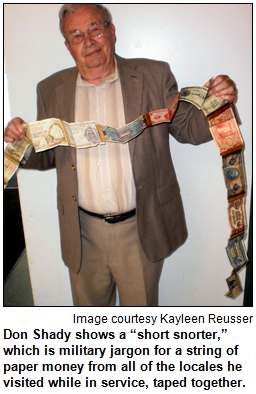 "He and other Allied troops disembarked from Landing Ship Tanks (LSTs) by descending 20-foot ladders into cold water before scrambling toward shore. The troops' marksmanship skills were of little help as they became easy targets for German marksmen on shore."
"He and other Allied troops disembarked from Landing Ship Tanks (LSTs) by descending 20-foot ladders into cold water before scrambling toward shore. The troops' marksmanship skills were of little help as they became easy targets for German marksmen on shore."
Although Bob Foster survived that conflict, he was injured during the Battle of the Bulge, which unfolded in frigid temps; soldiers fought while sleeping in foxholes filled with snow.
Bob Foster also discusses his role in capturing German POWs. And Don Shady shares insights about the Siege of Bastogne, a battle between American and German forces in Belgium at Christmas time in 1944.
During our show, Kayleen talks about common themes among the Hoosier veterans, such as their youth when they were dispatched overseas. Many were just 18 or 19 years old.
"Someone who would have been in his early 20s," she notes, "might have been called the 'old man'."
Her book features an account by an Army Air Force veteran from Fort Wayne who had to evacuate his plane over occupied France. He was hidden for three months by farmers in the French Resistance movement.
During a show last year, we focused on insights from veterans featured in another book, World War II: Duty, Honor, Country (iUniverse). Our guests included Noblesville resident Merrill "Lefty" Huntzinger, a staff sergeant in the 2nd Infantry Division who landed on Omaha Beach a few weeks after D-Day.
Last August, about seven months after our show aired, Lefty passed away at age 90. Here is our enewsletter for that Jan. 11, 2014 show.
|
Roadtrip: Lost Creek in Vigo County
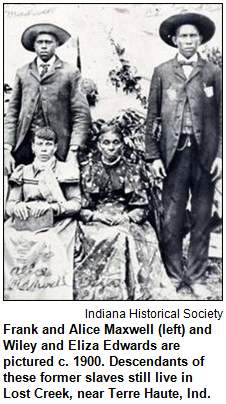 Guest Roadtripper Dona Stokes-Lucas, genealogist and co-chair of Indiana Freedom Trails, says that Lost Creek in Vigo County near Terre Haute was one of the "crown jewels" of her further discovery of early African-American settlements in Indiana.
Guest Roadtripper Dona Stokes-Lucas, genealogist and co-chair of Indiana Freedom Trails, says that Lost Creek in Vigo County near Terre Haute was one of the "crown jewels" of her further discovery of early African-American settlements in Indiana.
Dona tells us that Vigo County was formed in 1818, and by the 1820 census there were already 26 free blacks living in the county. The population of free blacks in the county continued to rise; 425 in 1840, 748 in 1850, 706 in 1860 (a slight decrease) and 1,099 in 1870. In 1850, there were 41 black landowners, whose real estate was collectively valued at $37,850.
An AME church was established by 1840 in Lost Creek, and a Baptist church was organized by 1850, an organization that still holds services today.
Two of the African-American cemeteries remain in Lost Creek: Roberts and Stewart Lawn. Descendants of these black pioneers still live on the same land, some for more than 150 years.
Lost Creek Settlement descendants Dorothy Ross and daughter Dee Reed live on a homestead there that has been recognized by the state as a "Hoosier Heritage Farm," and they maintain an impressive archive and records of their family history. They also helped to organize the Lost Creek Community Grove Restoration and Preservation Foundation.
Dona was one of several researchers participating in the Early Black Settlements initiative, which has documented 61 early farming communities in 43 counties in Indiana. Some of the better-known communities are Lyles Station in Gibson County and Roberts Settlement in Hamilton County.
You can click on this interactive map to learn about early black settlements in your county. The Early Black Settlements initiative was funded by Lilly Endowment.
History Mystery
|
One of the few remaining World War II battleships called LSTs - for Landing Ship, Tank - has been docked at an Indiana city in recent years. LSTs were designed to land tanks, soldiers and supplies directly onto enemy beaches so they were instantly ready for battle.
The LST docked at the Hoosier city participated in several operations, including D-Day at Omaha Beach. One of only two of the naval landing ships from the war to be preserved in this country, the LST at the Indiana city is a museum and memorial for those who served aboard them.
Question: At what Indiana city is the LST docked?
The prize pack is a gift certificate to Story Inn in Brown County, courtesy of Story Inn, and a pair of tickets to the Indiana State Museum, courtesy of the Indiana State Museum.
Civil War and African Americans in Indiana
|
(Feb. 21, 2015) - During the final years of the Civil War, African Americans from Indiana fought in a regiment called the 28th U.S. Colored Troops. Earlier during the war - before that regiment was organized - blacks from Indiana joined fighting units from other states, including a legendary infantry from Massachusetts depicted in the movie Glory (1989).
As Hoosier History Live salutes Black History Month, we explore a range of aspects related to the Civil War, including life for African-American families who remained on the home front in Indiana. 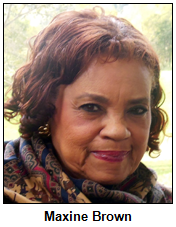 In Putnam County, a black man who enlisted in the 28th Regiment may have been intentionally poisoned before he could serve in combat, according to research by one of our guests.
In Putnam County, a black man who enlisted in the 28th Regiment may have been intentionally poisoned before he could serve in combat, according to research by one of our guests.
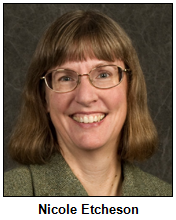 Nicole Etcheson, a Ball State University history professor, became intrigued by the life of Robert Townsend, who may have purchased a poisoned pie when the 28th Regiment was being mustered in Indianapolis. Nicole says she researched Townsend after discovering he was the only African American in Putnam County with a tombstone from the 1800s.
Nicole Etcheson, a Ball State University history professor, became intrigued by the life of Robert Townsend, who may have purchased a poisoned pie when the 28th Regiment was being mustered in Indianapolis. Nicole says she researched Townsend after discovering he was the only African American in Putnam County with a tombstone from the 1800s.
In addition to Nicole, Nelson is joined by historic preservationist Maxine Brown of Corydon. As she reported in a Roadtrip during a show last month, Maxine has been coordinating the renovation of a historic house built by a Civil War veteran wounded in the Battle of Petersburg, also known as the Battle of Crater.
The veteran, Leonard Carter (1845-1905), was born in Floyd's Knobs, but he settled in Corydon with his wife after the war. The small bungalow that he built for his family - known as the Carter House - was built circa 1891.
Maxine also shares insights about a former slave, Lucy Higgs Nichols, who served as a nurse for the Union Army. 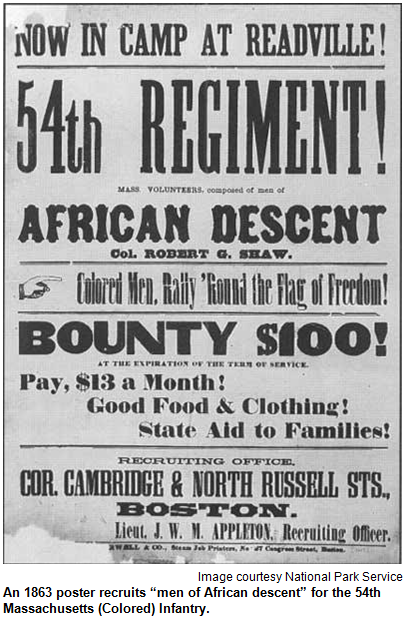 After the war, the Grand Army of the Republic admitted Lucy Higgs Nichols, a Tennessee native who lived in New Albany, as their only honorary female member in the country.
After the war, the Grand Army of the Republic admitted Lucy Higgs Nichols, a Tennessee native who lived in New Albany, as their only honorary female member in the country.
According to some accounts, more than 1,500 black men from Indiana fought in the Civil War. That happened even though the 28th Regiment wasn't formed until 1864 because some Hoosiers persisted with objections to black soldiers.
Earlier in the war, African Americans who wanted to fight for the Union cause had to enlist in other state's regiments, including the 54th Massachusetts Volunteer Infantry. Glory, the movie starring Denzel Washington that focused on that unit, won three Academy Awards. Historians say the valiant efforts of the 54th infantry - particularly during the Battle of Fort Wagner in South Carolina - made other Northern states realize they had neglected a great source of soldiers by not recruiting African-American men.
Even so, obstacles remained.
According to our guest Nicole Etcheson, several reports during the Civil War in Indiana described the sales of poisoned food to black troops. Robert Townsend, who lived near Putnamville, had purchased a pie from a peddler before falling violently ill and eventually passing away in 1865. His pension records link the illness to the pie, Nicole says.
Although Lucy Higgs Nichols, the nurse, eventually was granted a pension, she is said to have died penniless in 1915. In New Albany, the Carnegie Center for Art and History has a permanent exhibit about her; a historic marker in New Albany also honors Lucy Higgs Nichols.
During our show, our guest Nicole Etcheson discusses the treatment of African-American veterans after the Civil War. She is the author of A Generation at War: The Civil War in a Northern Community (University of Kansas Press, 2011).
Our guest Maxine Brown has won praise for her preservation work with African-American landmarks in southern Indiana. They include the Leora Brown School, a cultural center housed in a restored school - once known as the Corydon Colored School - where, before desegregation, generations of African-American children were educated.
The Carter House, which was saved from demolition, is being moved to a site near the Leora Brown School.
Roadtrip: Exotic Feline Rescue Center
"This week's Roadtrip is really off the beaten path," says guest Roadtripper and film historian Eric Grayson. "It's the Exotic Feline Rescue Center south of the tiny town of Center Point."
If you take the historic Old National Road (U.S. 40) west from Indianapolis, you'll run into the Oasis Diner just outside of Plainfield. This diner has just been reopened after being moved west from its previous location.
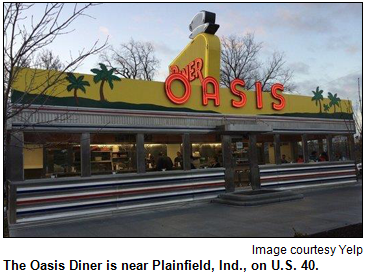 "I can highly recommend the Oasis for both its history and its food," says Eric. Originally built and shipped to Indiana from New Jersey, this diner has been lovingly restored.
"I can highly recommend the Oasis for both its history and its food," says Eric. Originally built and shipped to Indiana from New Jersey, this diner has been lovingly restored.
If the wait is too long at the Oasis, then you may want to continue west on U.S. 40 to the Harmony Diner in, yes, the small town of Harmony. Then, to get to the Exotic Feline Rescue Center, turn south on Harmony Road. It eventually passes over I-70 and becomes Barnett Street and finally County Road 200 East. But stick with it!
Once you pass through the very tiny town of Center Point, watch for the sign for the Exotic Feline Rescue Center, where you will turn east and arrive.
This is a fabulous place, especially if you like big cats. You'll see tigers, panthers, leopards, bobcats, and lions. These animals have been rescued from abusive owners and other horrible situations, but they're given separate pens, which are huge, so they can live out the rest of their lives in peace.
The Exotic Feline Rescue Center is truly a rescue center, not a zoo, but they welcome visitors.
"If you're lucky," says Eric, "all the lions will roar in competition with any Harley-Davidson motorcycle that comes by."
You also can hear Eric "Dr. Film" Grayson at an upcoming Vintage Movie Night at Garfield Park in Indianapolis.
History Mystery
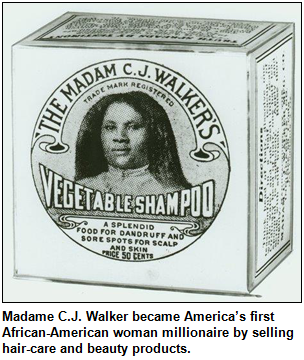 Two years after the Civil War, Madam Walker was born in Louisiana. Her parents had been slaves on a cotton plantation there.
Two years after the Civil War, Madam Walker was born in Louisiana. Her parents had been slaves on a cotton plantation there.
The future hair-care entrepreneur may have become the country's first African-American millionaire after she moved in 1910 to Indianapolis and built her factory that made hair-care products. But her name was not Madam Walker when she was born in 1867.
Question: What was her birth name?
The prize pack is a gift certificate to Bee Coffee Roasters Cafe, a pair of tickets to the Eiteljorg Museum and a pair of tickets to the Indianapolis Motor Speedway Hall of Fame Museum, courtesy of Visit Indy.
Victorian mourning and the Lincoln funeral train
|
(Feb. 14, 2015) - The spring will mark the 150th anniversary of the funeral that became the largest in the country's history until then - and the Abraham Lincoln funeral train came through the Hoosier state.
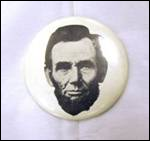 Hoosier History Live will pay tribute to the anniversary with a show about the Lincoln funeral cortege - the assassinated president's body lay in state at the Indiana State Capitol in April 1865 - as well as Victorian-era mourning customs.
Hoosier History Live will pay tribute to the anniversary with a show about the Lincoln funeral cortege - the assassinated president's body lay in state at the Indiana State Capitol in April 1865 - as well as Victorian-era mourning customs.
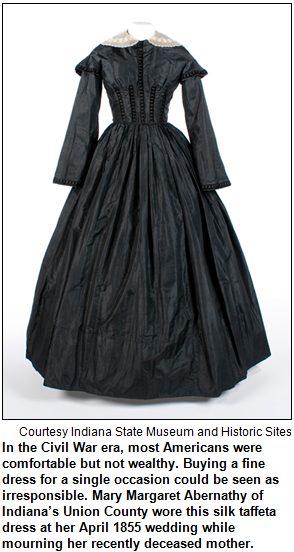 Artifacts related to Victorian mourning are included in an exhibit that opened this month at the Indiana State Museum titled "So Costly a Sacrifice: Lincoln and Loss." The exhibit features dozens of artifacts related to the Civil War and Lincoln, including a Confederate artillery shell that hit troops commanded by Col. Eli Lilly and the last portrait painted of Lincoln (1807-1865) from life.
Artifacts related to Victorian mourning are included in an exhibit that opened this month at the Indiana State Museum titled "So Costly a Sacrifice: Lincoln and Loss." The exhibit features dozens of artifacts related to the Civil War and Lincoln, including a Confederate artillery shell that hit troops commanded by Col. Eli Lilly and the last portrait painted of Lincoln (1807-1865) from life.
En route on a 20-day journey from Washington D.C. to Springfield, Ill., the Lincoln funeral train had three significant stops in the Hoosier state:
- Richmond, where church bells rang simultaneously and Gov. Oliver P. Morton boarded the train.
- Indianapolis, where despite a rainfall so heavy it was described as "torrential," a crowd of Hoosiers estimated as high as 50,000 - more than the entire population of the Hoosier capital then - paid respects at the Statehouse rotunda.
- And Michigan City, where problems on the railroad tracks necessitated an unplanned stop as the train was bound for Chicago. As at other stops, a funeral service - an impromptu one, in this case - was held for Lincoln.
Our previous shows about Abraham Lincoln have focused on earlier eras because the 16th president spent so much of his young life - from ages 7 to 21 - as a Hoosier.
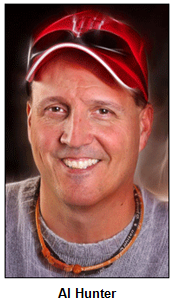 Guests on a show last February about young Abe's relationships with his parents included Dale Ogden, chief curator of cultural history at the State Museum. Dale, an expert on Lincoln's years in Indiana, will join Nelson in studio for this show as well.
Guests on a show last February about young Abe's relationships with his parents included Dale Ogden, chief curator of cultural history at the State Museum. Dale, an expert on Lincoln's years in Indiana, will join Nelson in studio for this show as well.
Another guest will be Al Hunter, a history columnist for The Weekly View, a community newspaper that serves the Eastside of Indy. Al has written two books about the historic National Road in Indiana. He has been working on a book about the entire journey of the Lincoln funeral train, with a particular focus on the trip's final portion from western Ohio, across Indiana, and to its final destination.
 According to Al, so many people dropped buttons, keys and other personal remembrances into the open casket at each stop that the president's coffin continually had to be "swept," or cleaned of memorabilia.
According to Al, so many people dropped buttons, keys and other personal remembrances into the open casket at each stop that the president's coffin continually had to be "swept," or cleaned of memorabilia.
Because Lincoln was shot on Good Friday (and died the next day), his passing during Easter weekend "became almost a religious experience" for residents of Northern states like Indiana, Dale Ogden says.
He notes that, because the telegraph was a relatively new invention in 1865, the assassination also became "the first national event the country experienced simultaneously." In earlier eras, news traveled slowly by letter or word of mouth.
During our show, Dale also will share insights about the approach to death and mourning during the Victorian era. Most funerals were held at home in a greeting room (hence, the origin of the term "funeral parlor"); socio-economic classes handled mourning in different ways.
The state museum's exhibit includes the funeral wardrobe of a family from Corydon, as well as a child's coffin, circa 1870, from Noble County. The average life expectancy during the era was 45 years old, a statistic skewed by so many deaths of children and infants.
During our show, Dale will talk about what has been called the "unprecedented carnage" of the Civil War. By the end of the war, more than 25,000 Hoosiers had been killed in battle or died of diseases that quickly spread in the soldiers' camps.
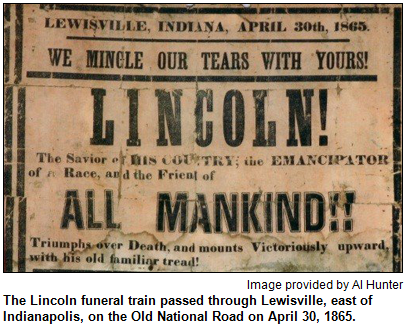 "The carnage of the Civil War is almost impossible to overstate," Dale Ogden says.
"The carnage of the Civil War is almost impossible to overstate," Dale Ogden says.
With Lincoln's death soon after the war ended, the president also, Dale notes, was regarded as a "martyr." To enable as many Americans as possible to pay their respects, the funeral train took a circuitous route from Washington, D.C.
In the eastern half of Indiana, the funeral train ran on tracks that nearly paralleled the Old National Road. So, in addition to Richmond, the train passed through Centerville, Cambridge City and other towns before stopping in Indianapolis, where the slain president's coffin was transferred to a hearse drawn by four white horses. Led by Gov. Morton, a procession formed to accompany the hearse to the Statehouse.
According to our guest Al Hunter, mourners included residents of Philadelphia and dozens of other cities who flocked to Indianapolis because their hometowns were not on the train's route. The heavy rainfall meant that some outdoor events - including a speech by Gov. Morton, a fierce ally of Lincoln and supporter of the Union cause - were canceled or shifted indoors.
On April 30, 1865, public viewing at the Indiana State Capitol began at 8 a.m. It continued until 10 p.m.
Learn more:
|
Roadtrip: Pogue's Run in Indianapolis
Guest Roadtripper Jim Lingenfelter of Five2Five Design Studio suggests we explore the stream Pogue's Run, which he describes as "a dubious historic remnant that flows through several historic neighborhoods and ends underground through downtown and into the White River."
Pogue's Run has been called a source of pestilence, a major pathway for early settlers, an impediment to growth of the city and a location for two major urban art installations.
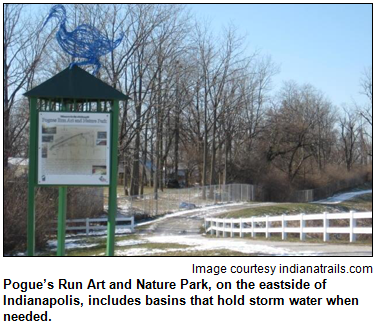 Starting near Brightwood on the near east side, Pogue's Run flows through Brookside and Spades Parks, Windsor Park and Cottage Home neighborhoods, Tech High School and the Legacy Center before going underground near the Holy Cross neighborhood.
Starting near Brightwood on the near east side, Pogue's Run flows through Brookside and Spades Parks, Windsor Park and Cottage Home neighborhoods, Tech High School and the Legacy Center before going underground near the Holy Cross neighborhood.
Prior to the arrival of early white settlers George Pogue and John Wesley McCormick, Indians and wildlife would often follow Pogue's Run as a pathway. Pogue (c.1763-1821) was a blacksmith from Connersville, Ind., and in 1819 he blazed a trail that corresponds with the present-day Brookville Road. The creek became known as Pogue's Run after Pogue mysteriously disappeared from Indianapolis in April 1821; his body was never found.
When Indianapolis was laid out, only Pogue's Run running diagonally across the southeast portion of the "Mile Square" disturbed the orderliness of the grid pattern. Alexander Ralston had to make compromises due to the stream's location within the congressional donation lands given for the future Indianapolis. Before the state government could be moved to Indianapolis from Corydon, $50 was spent to rid swampy Pogue's Run of the mosquitoes that made it a "source of pestilence."
In the so-called Battle of Pogue's Run on May 20, 1863, during the American Civil War, several Democrats leaving the state party convention on the railroad running parallel to Pogue's Run threw various firearms and knives into the creek because Union troops were looking for contraband weapons. Two decades later, in 1882, the Run flooded, killing at least ten people.
The Pogue's Run Art & Nature Park can be seen south of I-70 on the east side of Indianapolis; it's a 43-acre refuge for wildlife and art. Best to get off the interstate and just go explore the trails!
History Mystery
Abraham Lincoln was the first person to lie in state at the Indiana Statehouse. The second person, a Hoosier who achieved national fame, died in 1916. According to several accounts, more than 35,000 people filed past his casket at the Statehouse.
Question: Who was the famous Hoosier?
The call-in number is (317) 788-3314, and please do not call in to the show until you hear Nelson pose the question on the air. Please also do not call in to the show if you have won any prize from WICR in the last two months.
The prize pack is a pair of tickets to the Indiana Repertory Theatre and two passes to the President Benjamin Harrison Presidential Site, courtesy of Visit Indy.
Bart Peterson, former Indy mayor
(Feb. 7, 2015) - In 1999, Bart Peterson made history as the first Democrat to be elected mayor of Indianapolis since the 1970 merger, known as Unigov, of most aspects of city and Marion County government.
He served eight years as the top elected official in the Hoosier capital until he was defeated in a major upset in 2007 by previously little-known Greg Ballard.
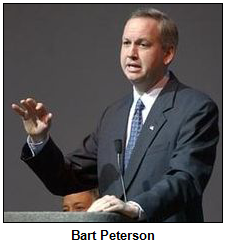 Now, as the race to succeed Mayor Ballard heats up, former Mayor Peterson, 56, is Nelson's studio guest for a "modern city history" show as we explore his life before, during and after his stint on the top floor of the City-County Building.
Now, as the race to succeed Mayor Ballard heats up, former Mayor Peterson, 56, is Nelson's studio guest for a "modern city history" show as we explore his life before, during and after his stint on the top floor of the City-County Building.
Since 2009, he has been the senior vice president for corporate affairs and communications for Eli Lilly and Company, the pharmaceutical giant. (History fact: His job at Lilly once was held by former Gov. Mitch Daniels.)
A lifelong resident of Indy, where his late father, Howard Peterson, was a prominent developer of the Castleton area, the future mayor graduated from North Central High School in 1976. He also is a graduate of Purdue University and the University of Michigan Law School. As a law school student, he suffered major injuries as a pedestrian in a horrific traffic accident.
Before winning election as mayor, Bart Peterson's jobs included serving as chief of staff for then-Gov. Evan Bayh.
Does he ever foresee running for public office again?
That's one of the questions Nelson plans poses to the former mayor, who is the latest in a series of former and current mayors of Hoosier cities to be guests on Hoosier History Live. They have included Indy's current mayor, Greg Ballard, as well as Bill Hudnut, the former four-term mayor of Indy.
Others have been Chris McBarnes of Frankfort, who became the youngest mayor of an Indiana city when he won election at age 23 in 2011; Dan Wright, the current mayor of Vernon, the state's only elected mayor of a town (rather than a city), and Wayne Seybold, who has been mayor of Marion since 2003.
During former Mayor Peterson's two terms in office, he was known as an advocate for making Indy a destination for arts and culture. His defeat for a third term has been blamed in part on voter frustration with property tax increases.
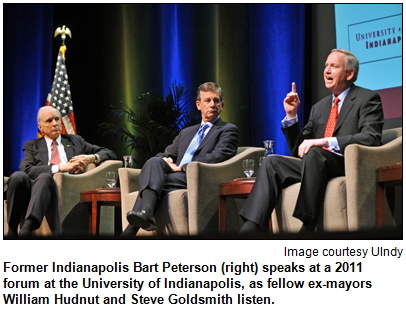 Two years ago, former Mayor Peterson and his wife, Amy Minick Peterson, moved into the historic Lockerbie neighborhood in downtown Indy. The couple met when he was in law school; the Petersons have a daughter, Meg, who is in her 20s.
Two years ago, former Mayor Peterson and his wife, Amy Minick Peterson, moved into the historic Lockerbie neighborhood in downtown Indy. The couple met when he was in law school; the Petersons have a daughter, Meg, who is in her 20s.
Bart Peterson's job with Lilly has involved extensive travel, most recently to Hong Kong and Europe. When Lilly, one of the world's largest drug makers, announced his appointment, The Indianapolis Star reported he would oversee about 440 people, including lobbyists and communications specialists, as well as manage an annual budget of about $200 million.
Before being hired by Lilly - and following his defeat for a third term as Indy's mayor - he was a resident fellow at the Kennedy School of Government at Harvard University.
He also is a former trustee at the University of Indianapolis, which houses the Mayoral Archives. It's a collection of documents, photos, recordings and artifacts from the administrations of mayors ever since Richard Lugar took office in 1968.
As mayor, Bart Peterson oversaw the establishment of charter schools and emphasized initiatives with Bio Crossroads, which markets central Indiana to life-science businesses.
Following voter protests over rising property taxes, Greg Ballard defeated him (51 percent to 47 percent) in an outcome that has been described as one of the "biggest upsets in Indianapolis history."
Some history facts:
- In addition to being a major developer of the Castleton area in the 1960s and '70s, Howard Peterson was a racehorse breeder. Twice named "Indiana Horseman of the Year," he was 84 when he died last August.
- According to several accounts, Howard Peterson, a Wisconsin native, had just $20 in his pocket when he roared into Indy on a motorcycle at age 19 to attend the Indianapolis 500. A former bricklayer, Howard Peterson was described as the embodiment of a "rags to riches story" by The Indianapolis Star in 2003.
- During his years as Indy's mayor, Bart Peterson served as president of the National League of Cities in 2006-07.
- Also during his term in office, Bart Peterson appeared as a guest on an NBC talk show hosted by one of Indy's most famous natives: The Late Show with David Letterman.
Roadtrip: Indy jazz, Pookie Johnson and more
|
The African-American jazz scene along Indiana Avenue in Indianapolis represents one of the richest parts of our state's heritage. It's time to celebrate Black History, and Katie Keesling of the Indiana Historical Society suggests that we head to the Eugene and Marilyn Glick Indiana History Center at 450 W. Ohio Street in downtown Indianapolis for some of its upcoming black heritage programs.
On February 12, IHS will host I Heart Indy Jazz!, an evening of history, storytelling and music celebrating the late Indianapolis great Alonzo "Pookie" Johnson. The program starts at 6 p.m at the Stardust Terrace Cafe, and two of Pookie Johnson's sons will perform and reminisce about their father and other Indianapolis legends.
On Feb. 14, guests at the Eugene and Marilyn Glick Indiana History Center can explore Indiana jazz from noon to 4 p.m. - listen to jazz renditions of Cole Porter songs, see Deborah Asante perform Rollin' Down the Avenue at 2 p.m. and participate in other family activities. Guests also can catch a screening of Chris Rock's documentary, Good Hair on the evening of Feb. 19 at the History Center. Advance registration is encouraged for the Feb. 12 and Feb. 19 events. To register, visit www.indianahistory.org.
History Mystery
Not only was future Indianapolis Mayor Bart Peterson a member of North Central High School's Class of '76, so was a talented musician. The classmate went on to become an enormously successful pop singer, songwriter and producer.
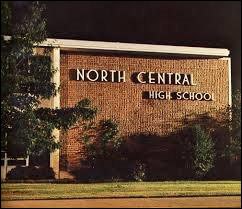 A winner of 10 Grammy Awards, he has turned out nearly two dozen No. 1 hits since 1987. In addition to his hits as a singer, the native Hoosier has created hits - as a songwriter or producer - for such stars as Madonna and the late Whitney Houston.
A winner of 10 Grammy Awards, he has turned out nearly two dozen No. 1 hits since 1987. In addition to his hits as a singer, the native Hoosier has created hits - as a songwriter or producer - for such stars as Madonna and the late Whitney Houston.
In 2007, when the North Central alum was named a Living Legend by the Indiana Historical Society, his high school classmate, Bart Peterson, presented him with the award.
Question: Who is he?
The prize pack is a gift certificate to the Rathskeller restaurant in downtown Indianapolis and two passes to Comedysportz, courtesy of Visit Indy.
Guinness World Records and Hoosiers
|
(Jan. 31, 2015) - During Super Bowl weekend, Hoosier History Live focuses on history-making achievements in offbeat athletic endeavors - as well as a buffet of other kinds of world records.
That's because our focus is on Indiana people and places associated with Guinness World Records.
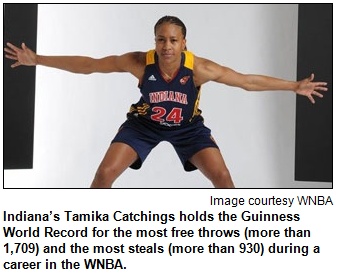 There are more of these connections than you might assume, in part because the famous Guinness Book of World Records has a long track record; it's celebrating the 60th anniversary of its annual editions. In addition, the records chronicled in the books - which rotate listings every year - draw on a massive international database at Guinness that stretches back a century or more.
There are more of these connections than you might assume, in part because the famous Guinness Book of World Records has a long track record; it's celebrating the 60th anniversary of its annual editions. In addition, the records chronicled in the books - which rotate listings every year - draw on a massive international database at Guinness that stretches back a century or more.
Nelson is joined in studio by two Hoosiers who have set Guinness records. We also explore world records that have involved the Indiana State Fair, Children's Museum of Indianapolis, the Indianapolis 500 and Tamika Catchings, the star player for the Indiana Fever.
Our guests are:
- David Fisher of Westfield, who has carved out a career as an expert about the benefits - and techniques - of various forms of rope jumping. Known as the "rope warrior" and the author of Cool Jump Rope Tricks You Can Do, David set a world record for the most "rump jumps," a type of rope jumping in which both the push-off and landing occur only on the participant's, ahem, rear end.
- And Kevin Silva of Indianapolis, proud owner of the world's largest collection of Batman memorabilia. Thanks to his massive collection of more than 2,501 pieces (ranging from lunch boxes, posters and neon signs to cowls), Kevin has been featured in national news media, as well as in the 2015 Guinness Book of World Records.
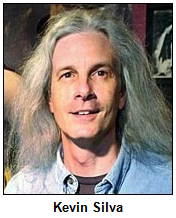 An interview with him is included in the newly released Blu-Ray boxed set of the Batman TV series from the mid-1960s.
An interview with him is included in the newly released Blu-Ray boxed set of the Batman TV series from the mid-1960s.
A London-based crew from Guinness came to Kevin's house last October to photograph his collection, which consumes his basement.
"They told me the Guinness database has 60,000 verified world records, and only about 3,300 to 3,500 are selected to be included in each year's edition," Kevin says.
By the way, "Batman collector" isn't his vocation. He's a songwriter, guitarist and the owner of Uncle Albert's, an amplifier repair business.
David, the rope warrior, has been featured in national media, including Good Morning, America and The Today Show. In Indiana, he has appeared at events with popular Tamika Catchings, who holds the world record for the most free throws (more than 1,709) during a career in the WNBA. She also holds the world record for the most steals (more than 930) during a WNBA career, according to an account in The Indianapolis Star.
The rump-jumping record, which David achieved on the set of a Los Angeles-based TV show in 1998, involved 56 consecutive revolutions.
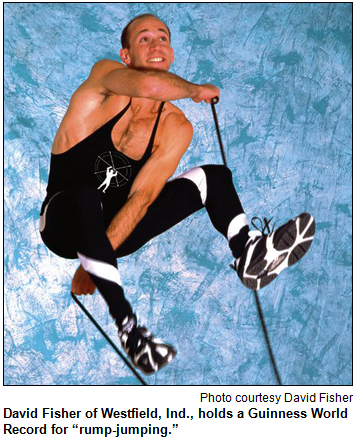 During our show, we also explore two Guinness World Records that have involved the Children's Museum. Leslie Olsen, the museum's media manager, phones in to share details about a record set last October when 250 preschool students gathered at the museum for a vocabulary lesson. Organized by PNC Financial Services, the Hoosier preschoolers were among 4,000 children in 37 cities who set a record for simultaneous participants in such a lesson.
During our show, we also explore two Guinness World Records that have involved the Children's Museum. Leslie Olsen, the museum's media manager, phones in to share details about a record set last October when 250 preschool students gathered at the museum for a vocabulary lesson. Organized by PNC Financial Services, the Hoosier preschoolers were among 4,000 children in 37 cities who set a record for simultaneous participants in such a lesson.
The other Guinness record related to the Children's Museum involves Leonardo, the mummified dinosaur that is exhibited. Unearthed in Montana in 2002, Leonardo is cited by Guinness as the "most complete dinosaur fossil" ever discovered.
Franklin County in southeastern Indiana also is credited with a Guinness record. According to Pam Beneker, Franklin County's recorder, the county set a world record "for the largest serving of fried chicken - 1,645 pounds - during the Franklin County Bicentennial." The feast was in July 2010.
Pam also reports that Grannie's Cookie Jar and Ice Cream Parlor in Metamora set a Guinness record for the most cookie jars on display.
Speaking of food: Remember the world's largest popcorn ball that was exhibited during the "Year of Popcorn" in 2013 at the Indiana State Fair? It set a Guinness World Record by weighing 6,510 pounds.
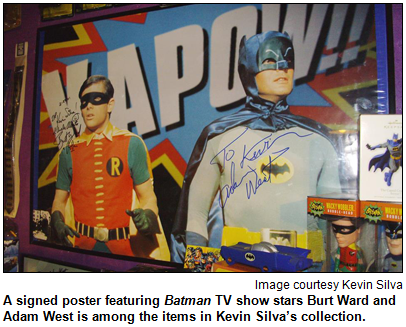 Fun fact: The 2013 edition of the Guinness book lists a distinction from 1952 at the Indianapolis Motor Speedway. At age 22, Troy Ruttman became the youngest winner in Indy 500 history.
Fun fact: The 2013 edition of the Guinness book lists a distinction from 1952 at the Indianapolis Motor Speedway. At age 22, Troy Ruttman became the youngest winner in Indy 500 history.
Back to David Fisher, the rump jumper and our guest; he performs rope-jumping tricks and techniques at school assemblies across the country and even at international sporting events and parades. They have included the 1994 Goodwill Games in St. Petersburg, Russia (spectators included Boris Yeltsin) and presidential inaugural parades for Bill Clinton and George W. Bush.
Our guest Kevin Silva, 53, also has enjoyed international exposure; his vast Batman collection was featured in an article and photos in The Daily Mail of London, for example. The collection is displayed in Kevin's personal "Batcave," the basement of his house. Memorabilia include rare comic books and props from the TV series that starred Adam West and Burt Ward, who have signed some of the collectibles. As a 5-year-old kindergartener, Kevin was given his first item, a Batman lunchbox.
Learn more:
- Video: David Fisher sets world record for rump jumping
- Indianapolis Star, Guinness Book of World Records.
Roadtrip: Zionsville's trains, trolleys and Main Street bricks
Why are the bricks in the middle of Main Street in Zionsville a different color? Bonnie Carter, a longtime Zionsville resident and history enthusiast, will explain. Trains and trolleys played a major role in the town, which was platted in 1852.
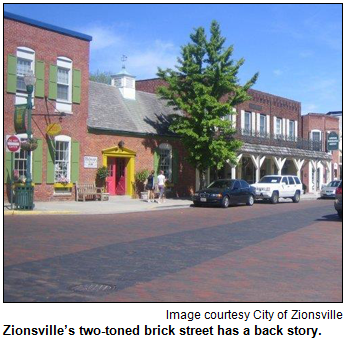 Zionsville's trains were vital communication links and the major reason for Zionsville's growth. On Feb. 11, 1861, Abraham Lincoln's train from Springfield, Ill., stopped in Zionsville for him to speak about his coming presidency, and this area is now Lincoln Park on First Street.
Zionsville's trains were vital communication links and the major reason for Zionsville's growth. On Feb. 11, 1861, Abraham Lincoln's train from Springfield, Ill., stopped in Zionsville for him to speak about his coming presidency, and this area is now Lincoln Park on First Street.
By 1902, Zionsville was ready for faster and more frequent transport to Indianapolis and many other Hoosier towns. The Indianapolis, Lebanon & Frankfort Traction Co. closed the deal to construct a trolley line using heavy wooden "combine" cars in the center of Main Street.
Area resident Thelma Shelburne Dye remembered riding first to school in Zionsville, to her doctor in Indianapolis and eventually to Purdue in nice, comfortable, reliable cars. By 1930, automobiles and buses were faster and reasonably priced so that trolley travel became obsolete. The electric trolleys were abandoned.
In 1911, bricks were first laid on Main Street after much controversy over the costs. When the bricks needed to be replaced, there were not enough available in the country to match the more than 90-year-old pavers. The solution was to use similar but different color bricks in the center to represent the old trolley tracks.
Credits to Ralph & Jan Stacey, Remembering Zionsville (2009) by Joan Lyons and History of Boone County, Indiana by Boone County Historical Society & Friends (1984) for stories and information.
Learn more:
- Hoosier History Live, Interurbans: their rise and fall across Indiana.
- Vintage film of Indiana interurbans, part 1.
- Vintage film of Indiana interurbans, part 2.
Note: If you are an interurban buff, you will enjoy these videos. Courtesy Pictorial Indiana.
History Mystery
Ripley's Believe It or Not drew national attention beginning in the 1930s to an Indiana town.  The newspaper feature created by cartoonist Robert Ripley focused on the town because it has the name of a folk character.
The newspaper feature created by cartoonist Robert Ripley focused on the town because it has the name of a folk character.
In one cartoon, Ripley identified the town as having the only post office in the entire country with the folk character's name. As a result, the Indiana town received a surge of letters from around the world; it continues to receive thousands of them every year, particularly during a certain month.
In tribute to the interest generated by the publicity from Ripley that began more than 80 years ago, the town paid tribute to Ripley's Believe It or Not in 2010.
Question: What is the Indiana town?
The prize pack is two passes to the Eiteljorg Museum, two passes to tour Lucas Oil Stadium and two passes to Laser Flash, a game of tag, in Carmel. These prizes are courtesy of Visit Indy.
Figure skating heritage in Indiana
|
(Jan. 24, 2015) - Nine figure skating clubs across Indiana are affiliated with the U.S. Figure Skating Association. They include the Winter Club of Indianapolis, which is turning 75 years old and has been a part of the lives of thousands of Hoosiers, from preschoolers taking their first steps on ice to skating devotees in their 80s.
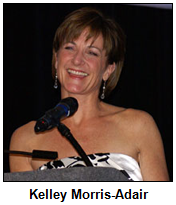 Indiana also has produced Olympians in figure skating, as well as influential coaches and judges.
Indiana also has produced Olympians in figure skating, as well as influential coaches and judges.
Just as the national championships in figure skating are unfolding on network TV, Hoosier History Live explores the heritage of the sport across Indiana, where well-known venues have included the Coliseum at the Indiana State Fairgrounds (it recently was renamed the Indiana Farmers Coliseum), the home of the Winter Club since 1940.
Nelson's guests are:
- Patty Hagen, director of the "Learn to Skate" program at the Winter Club and the author of The Joy of Coaching (Professional Skaters Association, 2013). A former reporter for The Indianapolis Star, Patty lives in Carmel and has been teaching group and private lessons since the 1980s.
 Michael Fisher, an Indianapolis-based judge of ice dancing. He competed in ice dancing tournaments as a student at Southport High School and Butler University several years before ice dancing became an Olympic sport in 1976. A Realtor in his day job, Michael joins Nelson and Patty in studio after returning from his role as an ice dancing judge in Greensboro, N.C., site of the national championships currently underway.
Michael Fisher, an Indianapolis-based judge of ice dancing. He competed in ice dancing tournaments as a student at Southport High School and Butler University several years before ice dancing became an Olympic sport in 1976. A Realtor in his day job, Michael joins Nelson and Patty in studio after returning from his role as an ice dancing judge in Greensboro, N.C., site of the national championships currently underway.- And Kelley Morris-Adair of Indianapolis. She is a past president of the Professional Skaters Association and a nationally known coach. As a child in her hometown of Columbus, Ind., Kelley began competing in figure skating. In 1977, she won the U.S. junior ice dance championship with her then-partner Michael Seibert. Today, her coaching partner is her husband, Donny Adair.
The evolution of figure skating in Indiana was affected by some historic tragedies. They included a plane crash in Belgium during February 1961 that killed top American skaters and coaches. 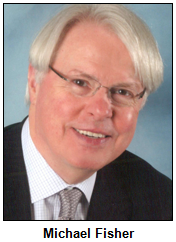 Among the fatalities was Danny Ryan, a coach in Indianapolis who had been the first American to win a medal in ice dancing at a world championship.
Among the fatalities was Danny Ryan, a coach in Indianapolis who had been the first American to win a medal in ice dancing at a world championship.
An explosion at the Coliseum on Halloween night of 1963 - during a Holiday on Ice show - also affected the lives and training of Hoosier skaters.
On the positive side, Hoosier figure skaters who have competed in the Olympics included brother-sister pairs team from Marion of Wayne and Natalie "Kim" Seybold (who were crowd favorites during the 1988 Calgary Olympics) and Jill Watson of Bloomington, who won a bronze medal, also at the 1988 Olympics.
Wayne Seybold, currently the mayor of Marion, and his sister were guests on a Hoosier History Live show in 2010 about their careers.
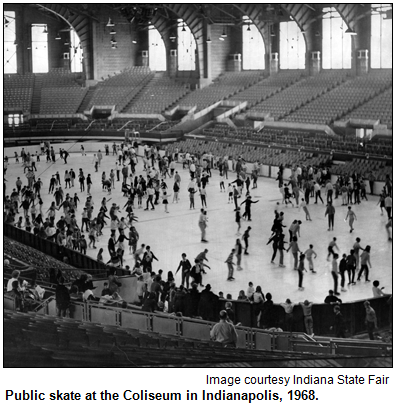 Like our guest Michael Fisher, the Seybolds began as competitive roller skaters, then switched to figure skating - even though, in their case, there was no ice rink in Marion. The Seybolds traveled to Fort Wayne, then Indianapolis and, finally, to Delaware as they advanced in their skating careers.
Like our guest Michael Fisher, the Seybolds began as competitive roller skaters, then switched to figure skating - even though, in their case, there was no ice rink in Marion. The Seybolds traveled to Fort Wayne, then Indianapolis and, finally, to Delaware as they advanced in their skating careers.
Influential Hoosier coaches have included Sandy Schwomeyer Lamb, a Shortridge High School graduate who pioneered figure skating as a sport in the Special Olympics. Her sister, Judy Schwomeyer Sladky, is considered a pioneer in ice dancing.
(Sandy Lamb also was an early coach of our guest Kelley Morris-Adair. Today, Kelley travels to rinks around the country to work with coaches on figure skating skills and ice-dancing choreography.)
Many accomplished skaters were influenced by the late Pieter Kollen, who coached at the Indiana/World Skating Academy at Pan American Plaza in Indy. In 2012, the academy moved to another well-known venue - the Carmel Ice Skadium - prior to the closing of the ice rinks at Pan Am Plaza.
In addition to figure skating clubs in central Indiana, others affiliated with the U.S. Figure Skating Association include clubs in Fort Wayne, South Bend, Columbus and Evansville.
Roadtrip: Winter fun in Ellenberger Park
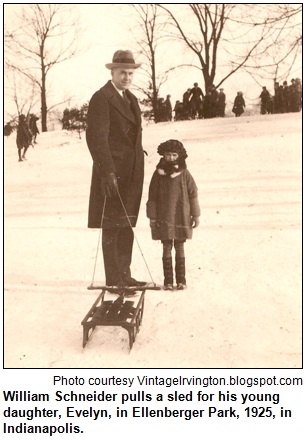 Suzanne Stanis of Indiana Landmarks suggests we take the Roadtrip to historic Ellenberger Park on Indianapolis's east side.
Suzanne Stanis of Indiana Landmarks suggests we take the Roadtrip to historic Ellenberger Park on Indianapolis's east side.
In 1909 the city of Indianapolis acquired part of the Ellenberger family farm in Irvington for use as a community park. The land, known as Ellenberger Woods, had long been enjoyed by residents of the area who took advantage of its wooded paths and creek.
German-born landscape architect George Kessler's plan for the park included the existing well-worn paths and linked the Ellenberger land to Garfield Park via the construction of Pleasant Run Parkway. The city added an outdoor ice skating rink in 1962, enclosing it in 1987 for year-round skating.
With increasing competition from commercially operated rinks and maintenance challenges, Indy Parks closed the rink in 2009. The building remains as locker rooms for the adjacent swimming pool.
Winter fun has not ceased at the park. The beloved sledding hill, enjoyed by several generations of Indianapolis families, continues to provide thrills for all ages, as demonstrated by this little daredevil in a 2009 YouTube video.
History Mystery
A national Hall of Fame is in Marion, Ind., the hometown of Wayne and Kim Seybold, the former Olympic figure skaters. The Hall of Fame has nothing to do with sports. Instead, it celebrates a domestic art.
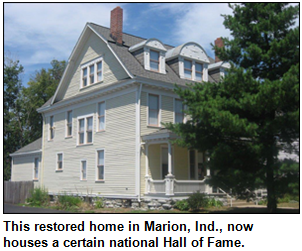 Located in a restored house that is on the National Register of Historic Places, the Hall of Fame honors a domestic art that has been associated with generations of Hoosier women. For more than 35 years, the Hall of Fame has been in Marion, where Wayne Seybold has served as mayor since 2003.
Located in a restored house that is on the National Register of Historic Places, the Hall of Fame honors a domestic art that has been associated with generations of Hoosier women. For more than 35 years, the Hall of Fame has been in Marion, where Wayne Seybold has served as mayor since 2003.
Question: What is the national Hall of Fame located in Marion?
The prize pack is a gift certificate to Story Inn in Brown County, courtesy of Story Inn, and two passes to the Indianapolis Motor Speedway Hall of Fame Museum and two passes to tour Lucas Old Stadium, courtesy of Visit Indy.
William Forsyth's colorful life, plus Portfolio Club history
|
(Jan. 17, 2015) - Undoubtedly, artist T.C. Steele continues to be the most frequently celebrated member of the nationally renowned Hoosier Group of painters who flourished during the late 1800s and early 1900s.
Recently, though, the spotlight also has been on Steele's peer, colorful and cantankerous William J. Forsyth, who lived in the Irvington neighborhood of Indianapolis.
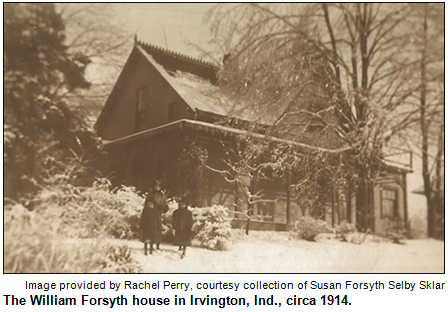 The life and career of Forsyth (1854-1935) are the focus of a new biography, and his paintings are featured in a retrospective exhibit at the Indiana State Museum.
The life and career of Forsyth (1854-1935) are the focus of a new biography, and his paintings are featured in a retrospective exhibit at the Indiana State Museum.
In addition, a cultural organization with which Forsyth was affiliated is about to celebrate a milestone. The Portfolio Club - which counted Forsyth, Steele and other influential Hoosiers among its members when the club was founded in 1890 - turns 125 years old this month. Forsyth served as its third president.
To explore a palette of topics related to all of this, Nelson is joined in studio by three guests:
- Rachel Berenson Perry, a well-known art historian based in Brown County. She is the author of William J. Forsyth: The Life and Work of an Indiana Artist (Indiana University Press, 2014). Rachel is the former fine arts curator of the Indiana State Museum; its current exhibit, William Forsyth: Only the Strong Persist, continues through March 29.
 Steve Barnett, executive director of the Irvington Historical Society. He also is treasurer of the Portfolio Club, which was formed to support artists and encourage art appreciation among Hoosiers.
Steve Barnett, executive director of the Irvington Historical Society. He also is treasurer of the Portfolio Club, which was formed to support artists and encourage art appreciation among Hoosiers.- And Wendy Boyle, current president of the Portfolio Club. She is a fund-raising consultant whose clients have included the Fine Arts Society (now Classical Music Indy) and the Indianapolis Art Center.
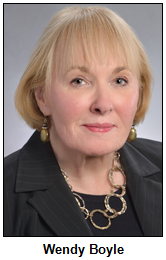 Forsyth was a key figure in founding what was then known as the John Herron Institute of Art in Indianapolis. As an instructor there through the early 1930s, he enormously influenced subsequent generations of Hoosier artists.
Forsyth was a key figure in founding what was then known as the John Herron Institute of Art in Indianapolis. As an instructor there through the early 1930s, he enormously influenced subsequent generations of Hoosier artists.
In her new book, Rachel explores Forsyth's lifelong jealousy of (and eventual estrangement from) Steele; she contrasts Forsyth's "blue-collar upbringing" with Steele's cultured family. (History fact: The Portfolio Club was inspired as a result of the urgings of Libbie Steele, the artist's first wife.)
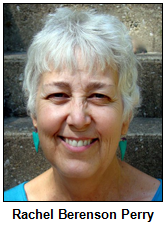 Like other members of the Hoosier Group, Forsyth studied at the Royal Academy of Art in Munich. Although known for a fiery personality, Forsyth had a flair for teaching and was loyal to serious art students. In her biography, Rachel praises his constant experimentation with various art mediums, subjects and styles.
Like other members of the Hoosier Group, Forsyth studied at the Royal Academy of Art in Munich. Although known for a fiery personality, Forsyth had a flair for teaching and was loyal to serious art students. In her biography, Rachel praises his constant experimentation with various art mediums, subjects and styles.
In addition to Forsyth, members of the Portfolio Club during its long history have included architects Bernard and Kurt Vonnegut Sr. (the grandfather and father of the novelist); jazz photographer Duncan Schiedt, who died in 2014, and Ferdinand Schaefer, founder and conductor of the Indianapolis Symphony Orchestra.
The Portfolio Club provides scholarships, including one that is endowed at what is now the Herron School of Art & Design at IUPUI.
In Irvington, Forsyth and his family lived in a rambling house (with a studio next to it) near Pleasant Run Creek. 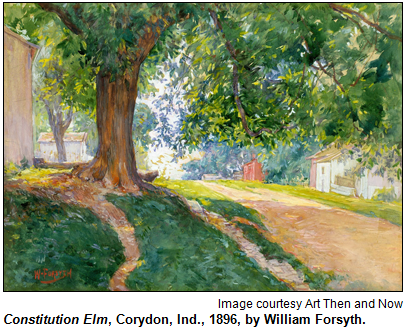 Forsyth became an avid gardener; his house and studio have been demolished, but a historical marker was erected on the site in 1984.
Forsyth became an avid gardener; his house and studio have been demolished, but a historical marker was erected on the site in 1984.
In addition to his paintings of Irvington and a range of sites across Indiana, Forsyth's works included drawings, painted china and even plaster sculptures. In her book, Rachel describes his experimentation as "fearless."
He painted landscapes, as well as portraits, creating artwork with watercolors, oil on canvas, charcoal on paper and in other ways. During the 1920s, he spent summers at Winona Lake in northern Indiana and painted scenes there.
Eventually, Rachel writes in her new book, Forsyth "exhibited more, won more awards and medals, and wrote more comprehensively about the Hoosier Group and Indiana art than Steele."
The introduction to her book is written by Susan Forsyth Selby Sklar, the painter's granddaughter. Rachel's other books include T.C. Steele and the Society of Western Artists (IU Press, 2009).
Learn more:
Roadtrip: The road to Liberty
Guest Roadtripper and public historian Glory-June Greiff suggests a scenic drive through eastern Indiana. Her directions from Indianapolis for this adventure are:
"Take U.S. 52 down to Rushville, perhaps stopping at the legendary Kopper Kettle in Morristown for lunch. But be hungry; the Kopper Kettle serves mounds of traditional food, family-style. Its over-the-top interior (especially at Christmas!) alone is worth stopping for. Or you might want to just wait until you get to Liberty."
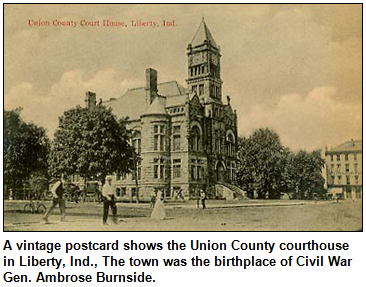 From Rushville, (the first of three county seats you'll see) head east on Ind. 44 to Liberty. You'll pass through Connersville, an old canal town and another county seat.
From Rushville, (the first of three county seats you'll see) head east on Ind. 44 to Liberty. You'll pass through Connersville, an old canal town and another county seat.
Take heart, Liberty is not far!
Yes, Liberty, Ind., is one of our smallest county seats, only a little over 2000.
Most of its downtown is listed in the National Register of Historic Places and features numerous 19th- and some early 20th-century styles, great to explore. The focal point is the beautiful Richardsonian Romanesque courthouse built in 1890.
Don't miss the New Deal-era post office, completed in 1937-38; go inside to see its mural Autumn Fields by Avery Johnson. The square also features interesting shops.
Hungry? Try the Liberty Bell restaurant, a down-home place just a little south of the square on Main Street (Ind. 101). For lighter fare or an ice cream treat, Glory recommends J's Dairy Inn, 207 W. Union, just west across the tracks from the old depot.
Perhaps most people know of Liberty through its proximity to Whitewater Memorial State Park, only a few miles south on Ind. 101, worth mentioning, of course! But if you're an explorer of old roads, you might want to take U.S. 27 southwest out of Liberty. Union County borders Ohio, and at the state line you'll find yourself in West College Corner, Ind., but a few steps later, in College Corner, Ohio. One post office serves both. Says Glory: "Love these state-line towns!"
History Mystery
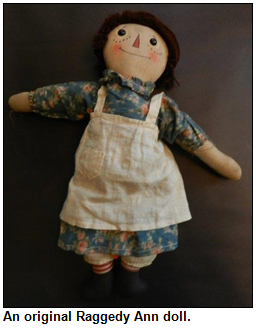 The Hoosier Group of artists included, in addition to William Forsyth and T.C. Steele, a painter whose son made a lasting cultural impact. The son, who grew up in Indianapolis, created the Raggedy Ann doll and books.
The Hoosier Group of artists included, in addition to William Forsyth and T.C. Steele, a painter whose son made a lasting cultural impact. The son, who grew up in Indianapolis, created the Raggedy Ann doll and books.
His artistic father was a friend of Hoosier poet James Whitcomb Riley. The son, who became a cartoonist for the Indianapolis Star and other newspapers, is said to have based Raggedy Ann on his two favorite Riley poems, Little Orphant Annie and The Raggedy Man.
The first book, Raggedy Ann Stories, was published in 1918. The floppy dolls were created as spinoff products to promote the book.
Question: Who was the Hoosier creator of Raggedy Ann?
The prize pack is a gift certificate to Peterson's restaurant in Fishers, courtesy of Visit Indy.
How to furnish an historic home
(Jan. 10, 2015) - Maybe your home's interior has a Victorian-era theme. Or is your preference for an even earlier period, like the Colonial era? Perhaps, though, a much later era, such as the 1950s or '70s, is your decorative dream.
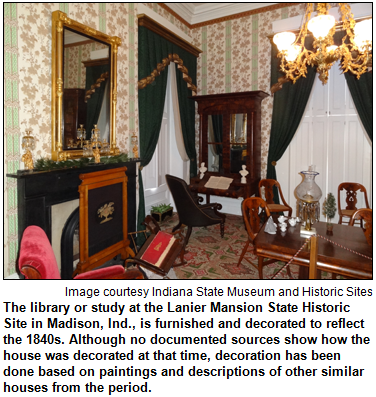 To offer advice about furnishing homes with "period" themes, Hoosier History Live calls on three experts with track records of making period-appropriate decorating decisions about distinctive homes, including some of Indiana's historic sites. Our topics include plenty of do's and don'ts. We also explore the care, treatment and placement of period furniture.
To offer advice about furnishing homes with "period" themes, Hoosier History Live calls on three experts with track records of making period-appropriate decorating decisions about distinctive homes, including some of Indiana's historic sites. Our topics include plenty of do's and don'ts. We also explore the care, treatment and placement of period furniture.
Nelson is joined in studio by:
- David Buchanan of Indianapolis, curator of decorative objects and furniture for the Indiana State Museum and Historic Sites.
- Link Ludington of Madison, director of historic preservation for the state museum and historic sites. He also is an architectural historian.
- And Greg Ziesemer of Madison, an antique furniture conservator and owner of Antique Furniture Restoration Inc. He also is a folk musician.
Along with advice for homeowners, our guests share anecdotes related to their restoration, furnishing and conservation experiences.
Regarding antique furniture, they talk about reproductions - along with, as our guest Link Ludington puts it, "reproductions that are now legitimate antiques." In addition, he discusses whether "investing" in antiques is a good idea; tips about starting collections; fakes and forgeries, and "matching furnishings to the period and style of a house versus eclectic collections."
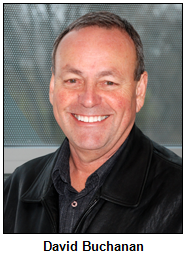 Link, who says his career has been shaped by "a lifelong interest in the architecture, decorative arts and furniture of the 19th century," is the vice president of the Cornerstone Society Inc. It is the historic preservation advocacy organization in Madison.
Link, who says his career has been shaped by "a lifelong interest in the architecture, decorative arts and furniture of the 19th century," is the vice president of the Cornerstone Society Inc. It is the historic preservation advocacy organization in Madison.
Some other tidbits:
- David Buchanan lives in an Italianate home built in 1870 that is considered the closest private residence to Monument Circle.
- Among the conservation experiences Greg Ziesemer regards as his most cherished: helping conserve a corner cupboard made in Indiana by Thomas Lincoln, father of future president Abraham Lincoln. (During a Hoosier History Live show in February 2014, we explored Abe Lincoln's relationships with his parents and Thomas' outstanding skills as a furniture maker.)
- Greg Ziesemer also has been involved with historic furnishings at the Lanier Mansion in Madison (where our guest Link Ludington once was the curator); the Benton House in the Irvington neighborhood of Indianapolis, and the IU Memorial Union in Bloomington.
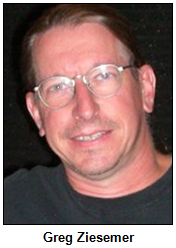 Often described as the "crown jewel" of this historic district in Madison, the Lanier Mansion was built in the 1840s by
Often described as the "crown jewel" of this historic district in Madison, the Lanier Mansion was built in the 1840s by 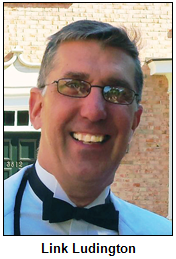 early Indiana architect Francis Costigan, who designed other buildings in Madison and Indianapolis. In the 1850s, Costigan designed a hotel in Indianapolis at a site on South Illinois Street that, ever since, has been the setting for a hotel. A few months ago, Le Meridien opened on the site, replacing the Canterbury Hotel; the current structure dates to the 1920s.
early Indiana architect Francis Costigan, who designed other buildings in Madison and Indianapolis. In the 1850s, Costigan designed a hotel in Indianapolis at a site on South Illinois Street that, ever since, has been the setting for a hotel. A few months ago, Le Meridien opened on the site, replacing the Canterbury Hotel; the current structure dates to the 1920s.
In Madison, the historic district includes more than 130 blocks. Homes are said to reflect every era of the Ohio River town's development between 1817 and 1939.
With its Corinthian columns on the south portico, Doric pilasters (ornamental columns) and other features, the Lanier Mansion in Madison is considered one of the best examples of Greek Revival architecture in the country.
Few of our listeners live in a house with that kind of rich history and spectacular features. But our guests offer advice for a range of owners of houses with period-focused themes. Link, for example, shares his take on "buying what you like and can afford instead of what someone tells you to like."
History Mystery
|
A type of desk created during the 1870s in Indiana became famous across the country and is considered one of the most significant successes of the state's woodworking industry. The desks, which featured built-in pigeonholes with specialized storage for letters, were made by an Indianapolis furniture shop.
Often made of walnut, the desks were known for consolidating work and storage space by providing nooks and crannies.
The name of the desks was derived from the Hoosier businessman who established the furniture shop in Indianapolis. John D. Rockefeller, Ulysses S. Grant and other famous Americans used the desks, which often had folding doors that could be locked, protecting the contents.
Question: What was the name of the Indiana-made desk?
The prize pack is a gift certificate to Bee Coffee Roasters, downtown Indianapolis and on Lafayette Road, and two tickets to the President Benjamin Harrison Presidential Site, and two tickets to the Eiteljorg Museum, courtesy of Visit Indy.
Roadtrip: Carter House in Corydon
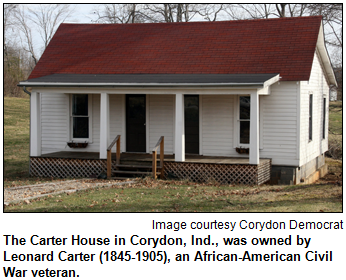 Guest Roadtripper and historic preservationist Maxine Brown of Corydon will tell us about the challenges in correctly decorating and furnishing of what she calls "the modest home of an everyday African American living in the 1890s."
Guest Roadtripper and historic preservationist Maxine Brown of Corydon will tell us about the challenges in correctly decorating and furnishing of what she calls "the modest home of an everyday African American living in the 1890s."
The Carter House in Corydon was owned by Leonard Carter (1845-1905), an African-American Civil War veteran born in Floyd's Knobs, Indiana, who fought with the Civil War 28th U.S. Colored Troops, Company C, and was wounded at the Battle of Petersburg (also known as the Battle of the Crater, which serves as the opening scene in the movie Cold Mountain).
After the Civil War, Leonard Carter settled in Corydon and married Easter Perry in 1866. They had nine children, and he built a small bungalow for his family at 545 S. Floyd St. around 1891. The Carter House was saved from demolition and is being restored. It has been moved to Hill Street, close to the Leora Brown Colored School, another African American landmark in Corydon. The Carters and some of their children are buried in Cedar Hill Cemetery in Corydon near where the house stands now.
Maxine Brown says that the house will feature a mixture of styles and period pieces, and she will be using a three-quarter-size bed donated by Habitat for Humanity. She hopes the house will be ready for touring by this summer.
Scottish heritage in Indiana
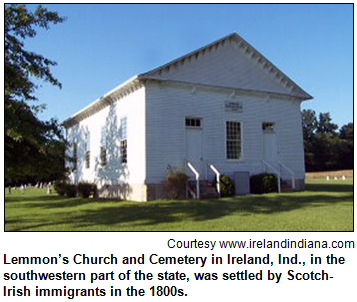 (Jan. 3, 2015) - To kick off our seventh year on the air in high style - or should that be Highlands and Lowlands style? - Hoosier History Live will present one of our popular ethnic-heritage shows.
(Jan. 3, 2015) - To kick off our seventh year on the air in high style - or should that be Highlands and Lowlands style? - Hoosier History Live will present one of our popular ethnic-heritage shows.
Scotland made headlines 'round the world awhile back with the vote on independence from the United Kingdom, so doesn't it seem logical to explore immigration to Indiana from the land of bagpipes and kilts?
Scots became the fourth most numerous European heritage group in Indiana, according to Peopling Indiana: The Ethnic Experience (Indiana Historical Society Press, 1996). They were exceeded only by residents of German, Irish and English descent.
"A trait of Scots who are immigrants is the tendency to assimilate rather than cluster," says Dr. Lee Cloe, a Noblesville native and charter member of the Scottish Society of Indianapolis. "While in most large cities, one can find 'Chinatown,' 'Greektown' or other groupings, you will not see a 'Scottstown.' Normally after two generations, they did not refer to themselves as Scots, but Americans."
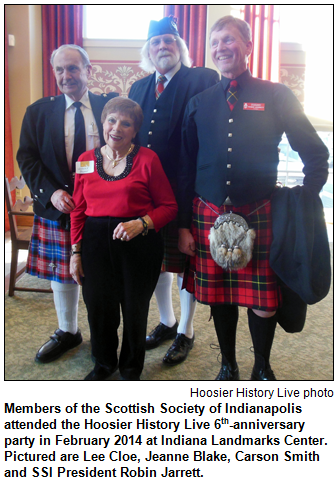 Dr. Cloe, a retired U.S. Air Force pilot, training officer and commander (he retired with the rank of major), joins Nelson in studio.
Dr. Cloe, a retired U.S. Air Force pilot, training officer and commander (he retired with the rank of major), joins Nelson in studio.
So does Carson Smith, a past president of the Scottish Society of Indianapolis who was frequently quoted by Indiana media during the referendum in his ancestral homeland last fall to break from the United Kingdom after more than 300 years. (In case you missed the outcome, the move to secede from the United Kingdom was unsuccessful. Scotland accounts for one-third of the U.K.'s land, 8 percent of the population and 10 percent of the tax revenue, according to news reports at the time.)
One of the best-known figures of early Indiana - frontier military leader George Rogers Clark, a Revolutionary War strategist - was of Scottish heritage. Famous for defeating the British at Vincennes(which had been renamed Fort Sackville) with a ragtag army during the winter of 1779, Clark (1752-1818) founded the town of Clarksville on the Ohio River. His brother, William Clark, became the renowned explorer of Lewis & Clark fame.
Ever wonder what the term Scotch-Irish means?
Our distinguished guests explain, along with sharing insights about how and why a mix of people with Scottish heritage were among the first people to survey the early Virginia Colony and European heritage settlers to penetrate the Appalachian Mountain range in the 1780s.
Today, Scottish societies flourish in Hoosier cities such as Bloomington and Fort Wayne.
According to several sources, many Scots were recruited to help build railroads in the area around Columbus, which hosts a popular Scottish Festival every September. Even so, our guest Dr. Cloe notes that Scots did not tend to arrive in "waves" to Indiana, unlike some other ethnic heritage groups.
 He adds that not all place names in Indiana have the kind of direct link to his ancestral homeland that you might assume. Dr. Cloe notes the town of Scottsburg in southern Indiana was named in honor of Horace Scott, a railroad president; Scott County was named after Gen. Charles Scott, who fought in the Revolutionary War.
He adds that not all place names in Indiana have the kind of direct link to his ancestral homeland that you might assume. Dr. Cloe notes the town of Scottsburg in southern Indiana was named in honor of Horace Scott, a railroad president; Scott County was named after Gen. Charles Scott, who fought in the Revolutionary War.
Some history nuggets:
- Coal miners from Scotland immigrated in substantial numbers to southwestern Indiana to work in Hoosier coal mines, according to Peopling Indiana.
- In the 1820s, Scottish industrialist Robert Owen started the second attempt at a utopian society in New Harmony. (He had been born in Wales but eventually owned mills in Scotland.) After purchasing the scenic village on the Wabash River from a group headed by German immigrant George Rapp, Owen brought a "Boatload of Knowledge" - scientists, scholars and other intellectuals were aboard - to New Harmony.
- Indiana's governor during the Civil War, Oliver P. Morton, was of Scottish heritage.
- "Not all Scots have a 'Mac' in front of their names," Dr. Cloe notes, "so unless they 'bragged' about being from Scotland, most people would not know their background."
Our guest Carson Smith, who has had a long career as a sales representative, is a past president of the Indiana society of the Sons of the American Revolution and was the first editor of The Thistle, the newsletter of the Scottish Society of Indianapolis.
 In addition to his military background, our guest Dr. Cloe was an administrator or specialist with universities in Indiana and with various state and city agencies. In 2008, our first year on the air, Dr. Cloe was a guest on one of our first ethnic heritage shows.
In addition to his military background, our guest Dr. Cloe was an administrator or specialist with universities in Indiana and with various state and city agencies. In 2008, our first year on the air, Dr. Cloe was a guest on one of our first ethnic heritage shows.
Since then, Hoosier History Live has expanded from 30 minutes to an hour and has explored ethnic heritage groups, including Germans, Irish, Cubans, Italians, Greeks, Scandinavians and Russians, as well as Colombians and Venezuelans.
(Note: Not all of our past programs are audio-archived for online listening. As a small, independent production group, we need financial assistance in order to accomplish this.)
Learn more:
- Scottish Colonization of the Americas.
- Migration Patterns of our Scottish Ancestors.
- History of Edinburgh, Indiana.
- Scottish Society of Indianapolis
- Indianapolis Highland Games & Festival.
History Mystery
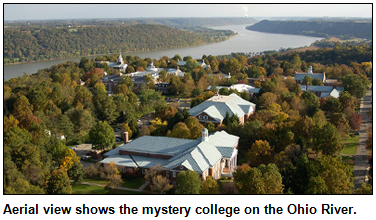 The oldest private college in Indiana was established by an educator of Scottish heritage. Located on a scenic campus in far southern Indiana, the liberal arts college began as an academy in 1827 and has had a long affiliation with the Presbyterian Church.
The oldest private college in Indiana was established by an educator of Scottish heritage. Located on a scenic campus in far southern Indiana, the liberal arts college began as an academy in 1827 and has had a long affiliation with the Presbyterian Church.
Attended by about 1,150 students, the college is near the banks of the Ohio River.
Question: What is the Indiana college?
The prize pack is a gift certificate to the Claddaugh Irish Pub & Restaurant, two tickets to the James Whitcomb Riley Museum Home, and two tickets to the President Benjamin Harrison Presidential Site, courtesy of Visit Indy.
Digital Roadtrip: The Indiana Album
|
Not all Roadtrips are physical places. The Internet also allows us to travel to and explore the past!
Guest Roadtripper Joan Hostetler of Heritage Photo & Research Services will tell us about The Indiana Album, a community-submitted digital album of Indiana-related photographs lingering in albums, attics and basements and now finding their way to the web.
Tune in this Saturday to learn more about this Indiana Bicentennial project and how you can participate. By the way, The Indiana Album is seeking help in identifying the photo of this mystery bridge.

